The Pantanal in Brazil is a wonderful place to spot animals in the wild. Jaguars, giant anteaters, howler monkeys, but also a great variety of birds like hyacinth macaws and monk parakeets found a home in Brazil’s largest tropical wetland. In this blog entry I will tell you more about what you can expect in April on a three-day tour in the south of the Pantanal in Mato Grosso do Sul.
The Pantanal in Brazil
The Pantanal in Brazil is a great place for every wildlife lover as you can find a great variety of different animal species there. If you visit the wetland in the right season and furthermore find a great guide who knows best where to find most wildlife, I’m sure you will be stunned by the amount of different animal species. My wildlife wish list was long for the Pantanal. Jaguars. Howler Monkeys. Giant anteaters. Hyacinth macaws. Giant otters. Just to name a few. My list was long. But did I spot all these animals? Well. Unfortunately, I did not meet all of them. However, I still saw some great and very interesting wildlife on our three-day-two-night tour to the south of the Pantanal in Mato Grosso do Sul. Below I will tell you more about the wildlife I met.
In general the Pantanal in Brazil can be divided into a northern and southern region. Starting point in the south of the Pantanal is usually Campo Grande in the state Mato Grosso do Sul. In the northern Pantanal most visitors start from Cuiabá in the state Mato Grosso. Another starting point for many travelers is Corumbá which is close to the Bolivian border.
The climate of the Pantanal in Brazil can be divided roughly into two seasons. The wet and the dry season. The wet season starts approximately in November and usually ends in March. During the wet season the water of the rivers flood the low-lying regions of the Pantanal. On small islands – called cordilheiras in Portuguese – wild animals herd together in order to find protection from the flood. The water lever is highest in January and February, but decreases slowly in March. During the dry season between April and October the water level is low and lagoons and marshes dry out. Fishes remain in the remaining ponds and end often as a food source for many wild animals.
We started our expedition in Campo Grande – the capital of Mato Grosso do Sul. We booked a tour which was recommended in your travel guide. It was a three-day-two-night tour including an English-speaking guide. Our group was mixed with people from different countries, namely, from Ireland, the Netherlands, France and Slovakia. In general, the Pantanal was more expensive than all the other places where we had been before. Therefore, we booked a tour specialized on backpackers.
We traveled by bus from Foz do Iguaçu to Campo Grande. We arrived at the bus terminal in Campo Grande early in the morning. Our tour operator was already waiting for us. He took us to an hotel in the center of Campo Grande where we could have a breakfast. We were asked to have a good and long breakfast as we would have to skip lunch. After our long breakfast we and all other participants entered a small mini-van. The transfer from Campo Grande to the Fazenda São João in the Pantanal where we stayed for three nights took about five hours. By the way, if you want to start your tour in Campo Grande, but travel to Bonito or Corumbá after the tour, the tour operator will organize a transfer for you (included in the price). We started in Campo Grande and went back to the town again after the tour as our bus back to Rio de Janeiro left at the bus terminal in Campo Grande.
If you also want to explore the Pantanal in Brazil with a tour operator, be careful when you choose a tour. Some tours might be cheap, however, they might not bring you to a place where you can see much wildlife. Given the price and the season, I was not unhappy with the tour we had chosen, but there was one point in the tour that I was missing. And that was conservation. I haven’t learned anything about conservation in the Pantanal. If you consider that there are large farms in the Pantanal, I would have been interested to learn more about all that on our visit. Our tour guide even considered hyacinth macaws as very abundant although they are listed as “vulnerable” according to the International Union for Conservation of Nature (IUCN). Maybe next time I wouldn’t join a tour specialized on backpackers again, but one which is focused on conservation (and probably more expensive).
Tip: In general you can expect more expensive and more exclusive tours in the north of the Pantanal in Brazil. In the south there are many cheap tours addressing especially backpackers. If you can afford it, a private guide might bring you to the best places where you can observe wildlife.
Best time to visit the Pantanal
The best time to visit the Pantanal in Brazil is the dry season. At first, we intended to visit the Pantanal in March, however, one tour operator (not the one we booked as we went to the south and not to the north) recommended us to visit the Pantanal later in the dry season. The later the better. Therefore, the Pantanal became our last destination on our journey through the south of Brazil, and thus, decided to visit the Pantanal at the end of April. At the end, I can say, it would have been better to visit the Pantanal even later. Our tour operator, however, told us that it is possible to visit the Pantanal the whole year. I say, if you are interested to spot many wild animals, I recommend to visit the Pantanal not before April/May. In general, it is said that the best time to visit the Pantanal is from June to August. That means, in the driest months. If you are interested to spot jaguars, best chances are in these months. And by the way, apparently it is better to observe jaguars in the north of the Pantanal.
Tip: Ask your tour operator when it is the best time to visit them. Try to find out as much as possible which animals you can expect to see in the different months.
A tour through the Pantanal
A boat trip on the river
Due to our long drive from Campo Grande to the Fazenda São João we arrived in the late afternoon on our first day in the Pantanal. However, it was not too late to participate in a boat trip. It was very cloudy, but also very warm and humid. The clouds in the sky indicated some rain in the next few hours.
I was looking forward to witness my first sunset in Brazil’s largest wetland area. I was also excited about all animals that might show up during our boat tour in the Pantanal. Maybe a giant otter? Or some howler monkeys? And what about jabirus and other birds?
To get straight to the point: We saw not all of them. However, instead we spotted some other animals I had never seen before.
The first animal we saw was a typical bird of the Pantanal. A jabiru (Jabiru mycteria). Later on we would meet some more of them. Our next wild animal we spotted was a Yacaré caiman (Caiman yacare). It was lying inconspicuously in the water and observing very attentively the boat that was just passing by its resting place.
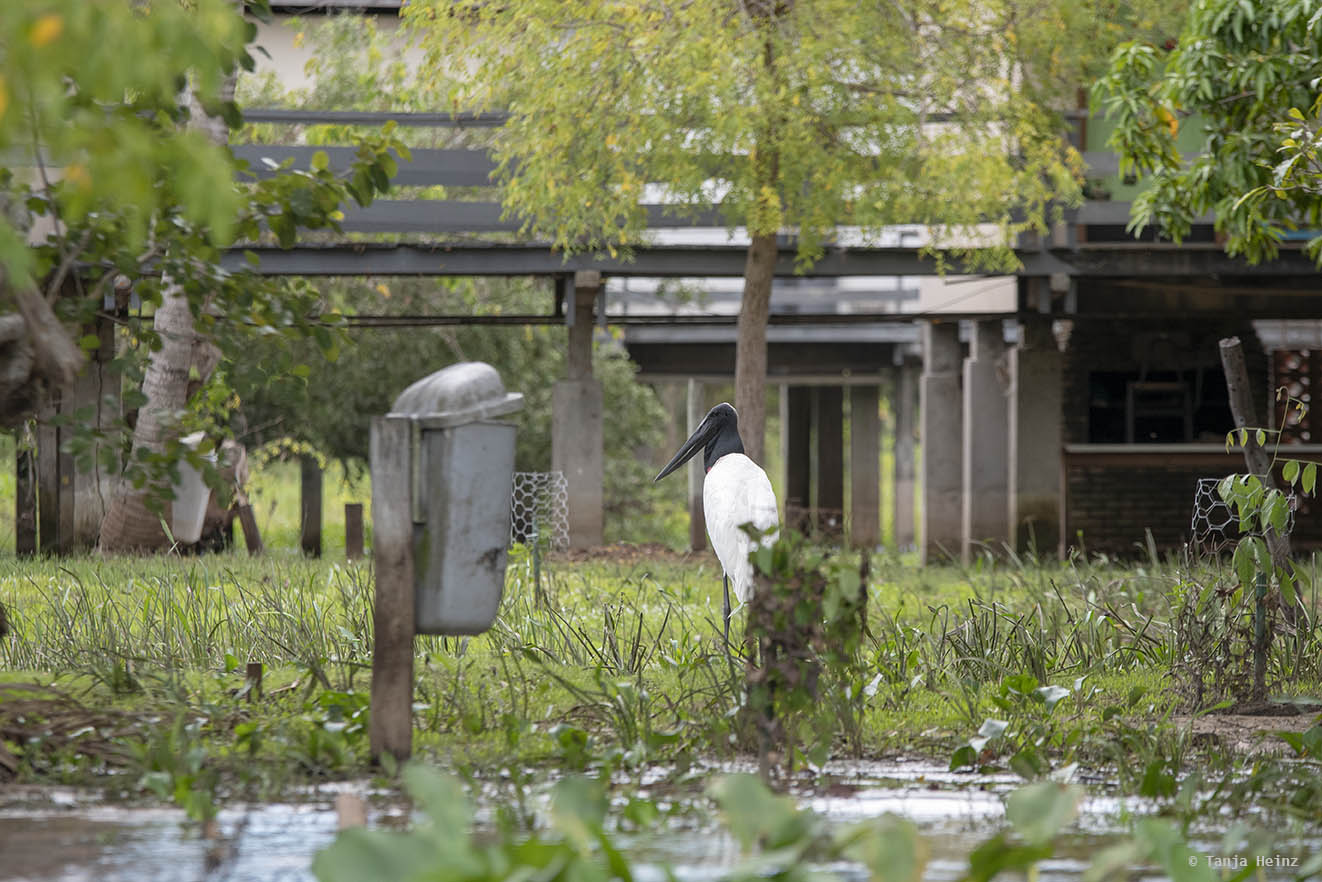
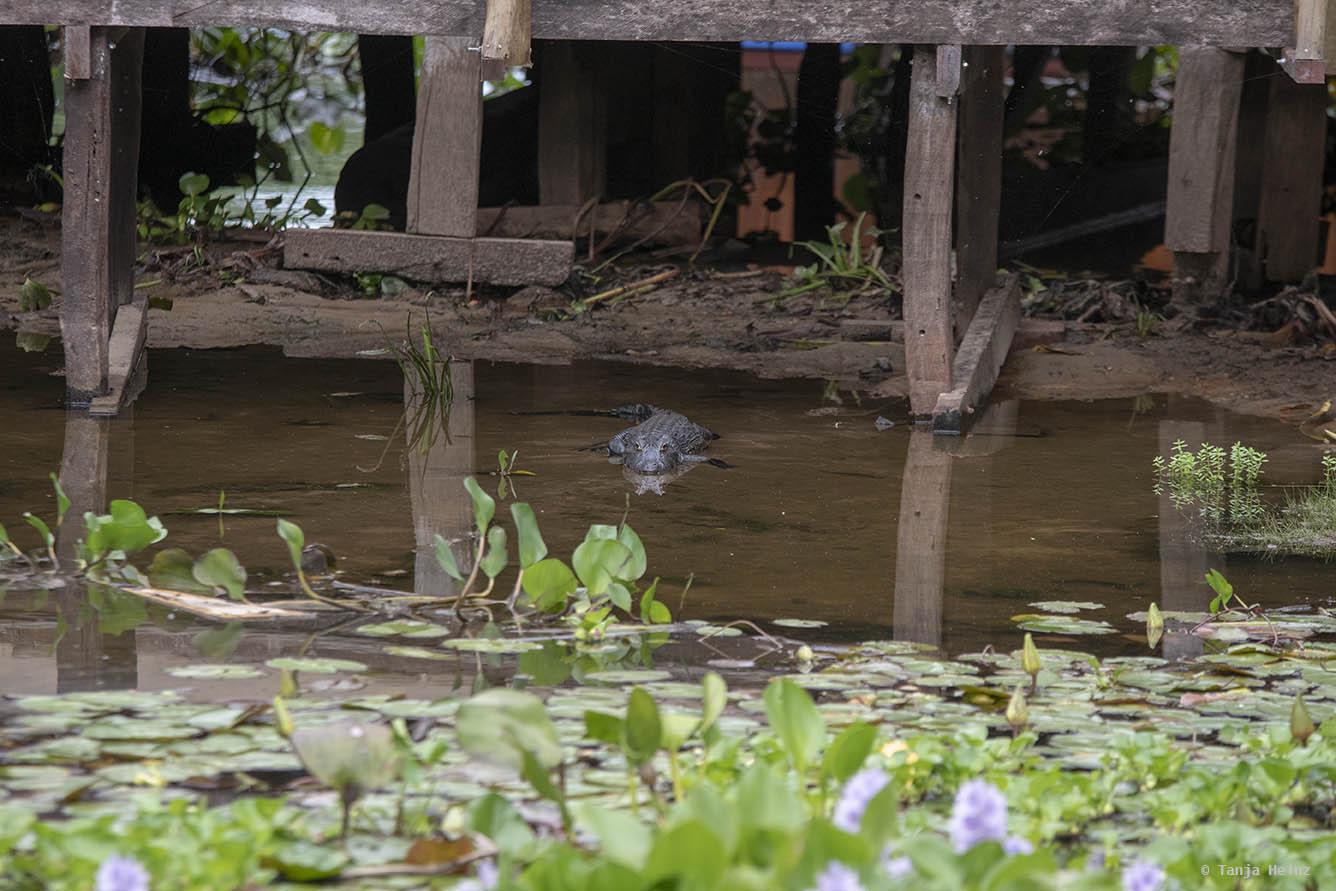
Another bird we met at the beginning of the boat tour was a capped heron (Pilherodius pileatus). In general we observed many birds of this bird family.
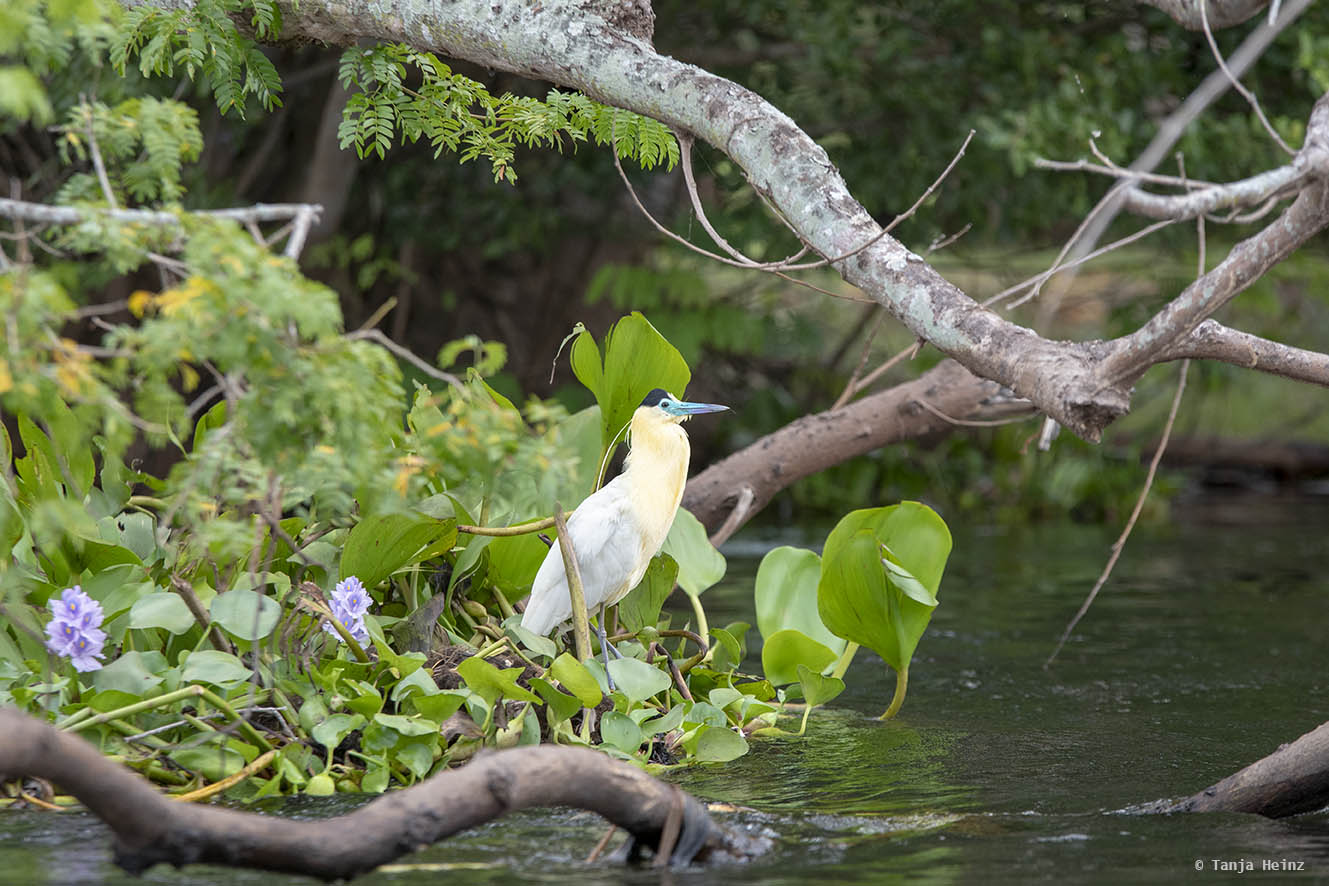
Finally we left the Fazenda behind us and followed the course of the river.
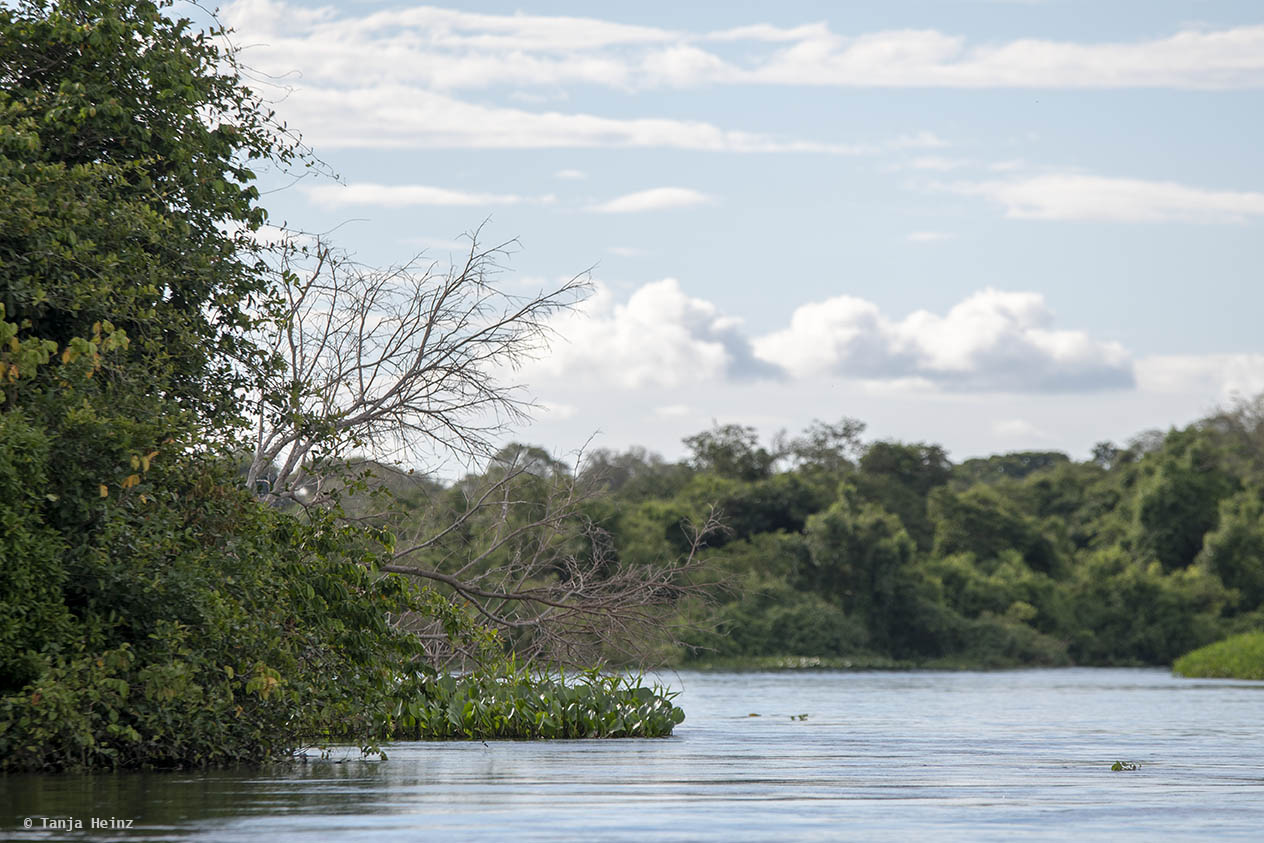
In the next two hours we could admire the natural beauty of the Pantanal by boat. Large cloud formations on one side and a darkling sky on the other side reminded us to observe attentively the weather during the boat trip.
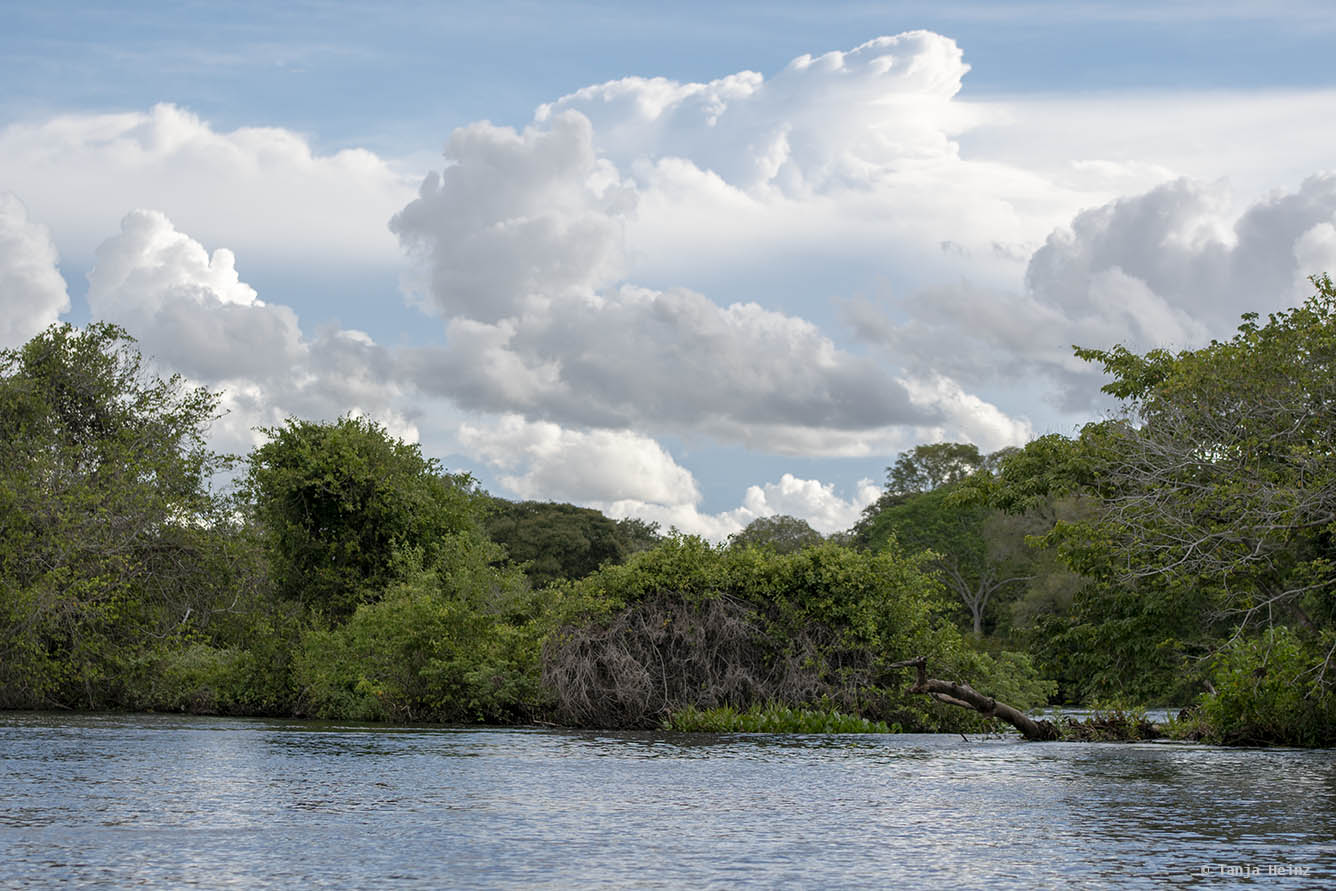
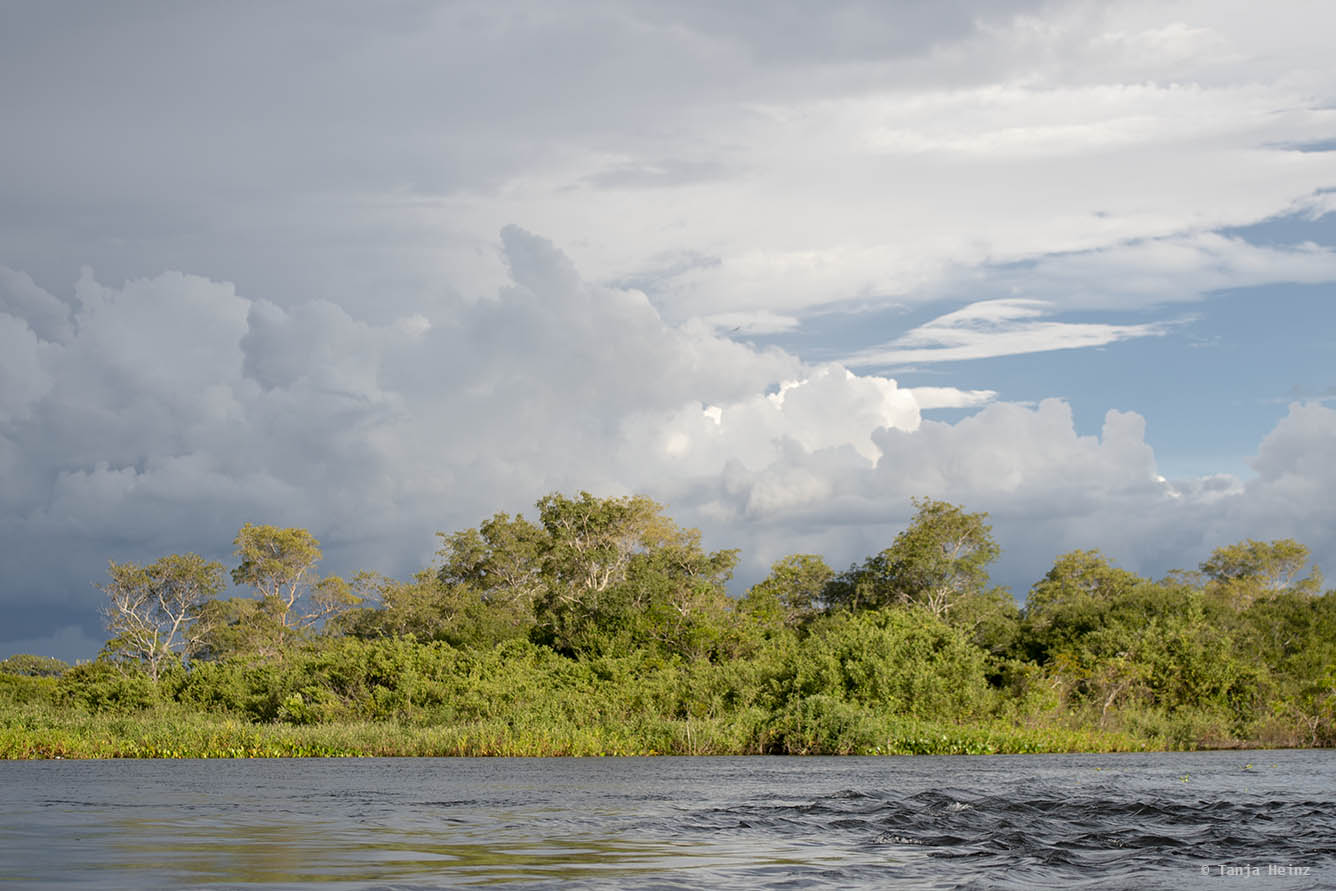
In some moments the colors of the Pantanal took my breath away.
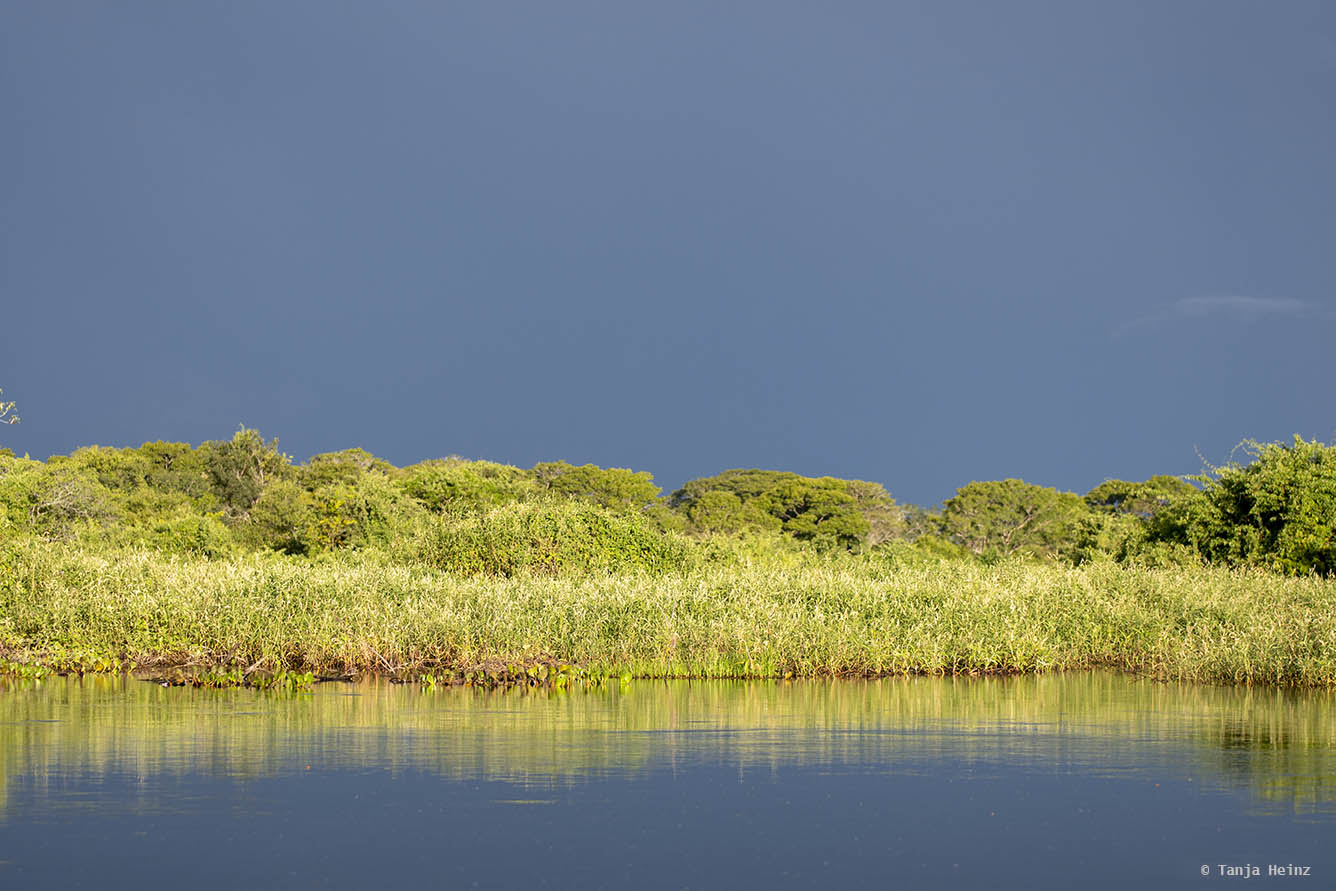
Finally we saw some more birds on both sides of the river bank. A very predominant bird family in the Pantanal include herons and egrets. Consequently, we also spotted a great egret (Ardea alba). Furthermore, during our boat trip we saw several rufescent tiger herons (Tigrisoma lineatum) sitting on tree crowns.
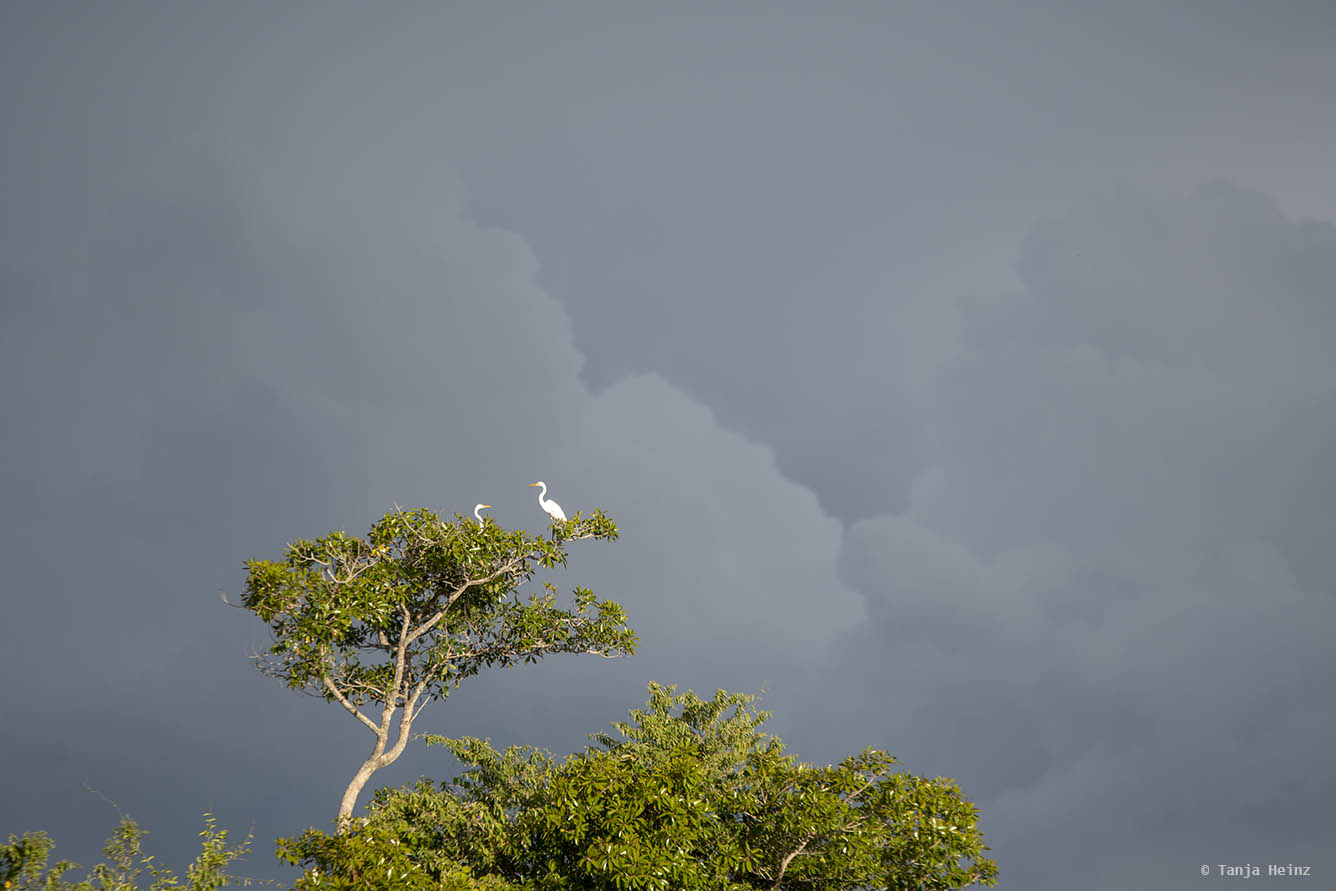
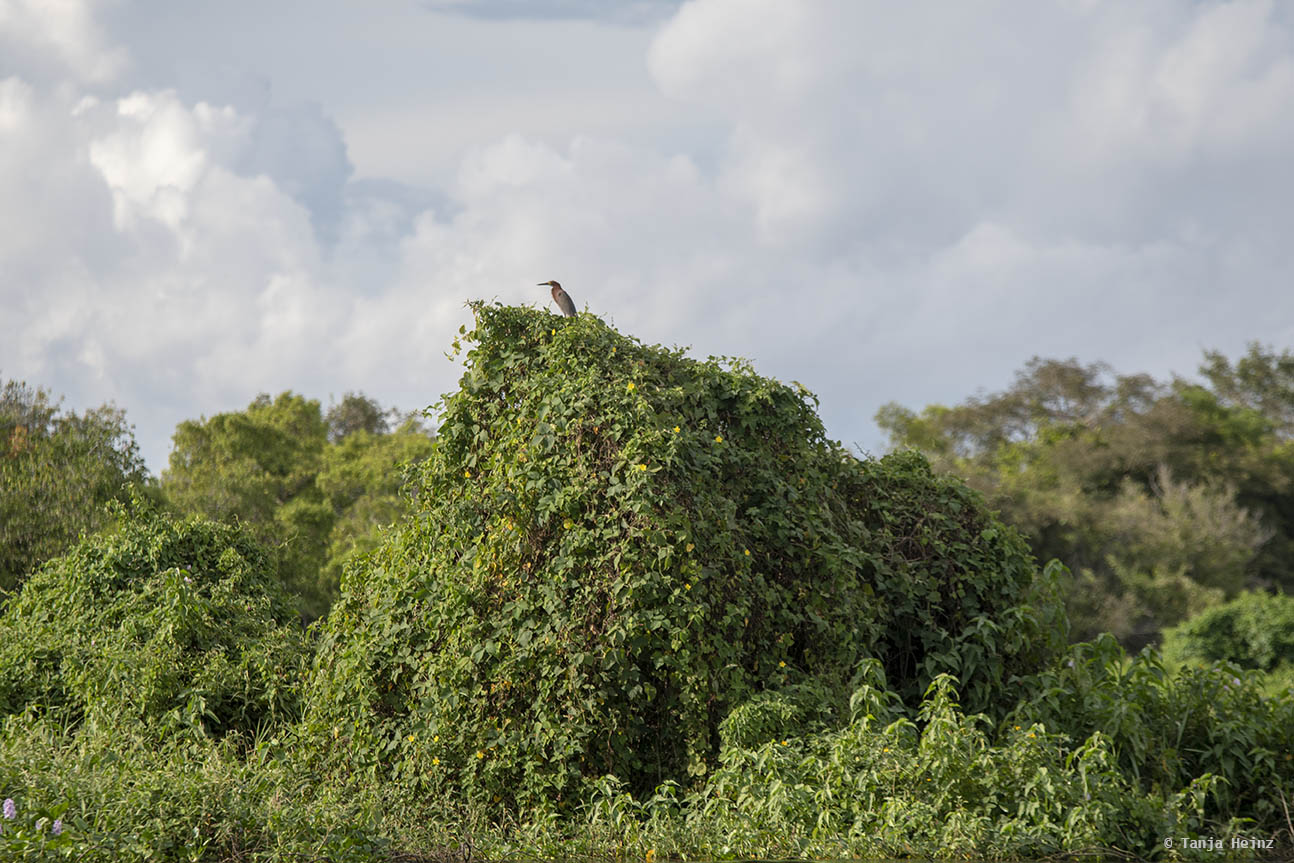
We found another rufescent tiger heron close to a house built on stilts.
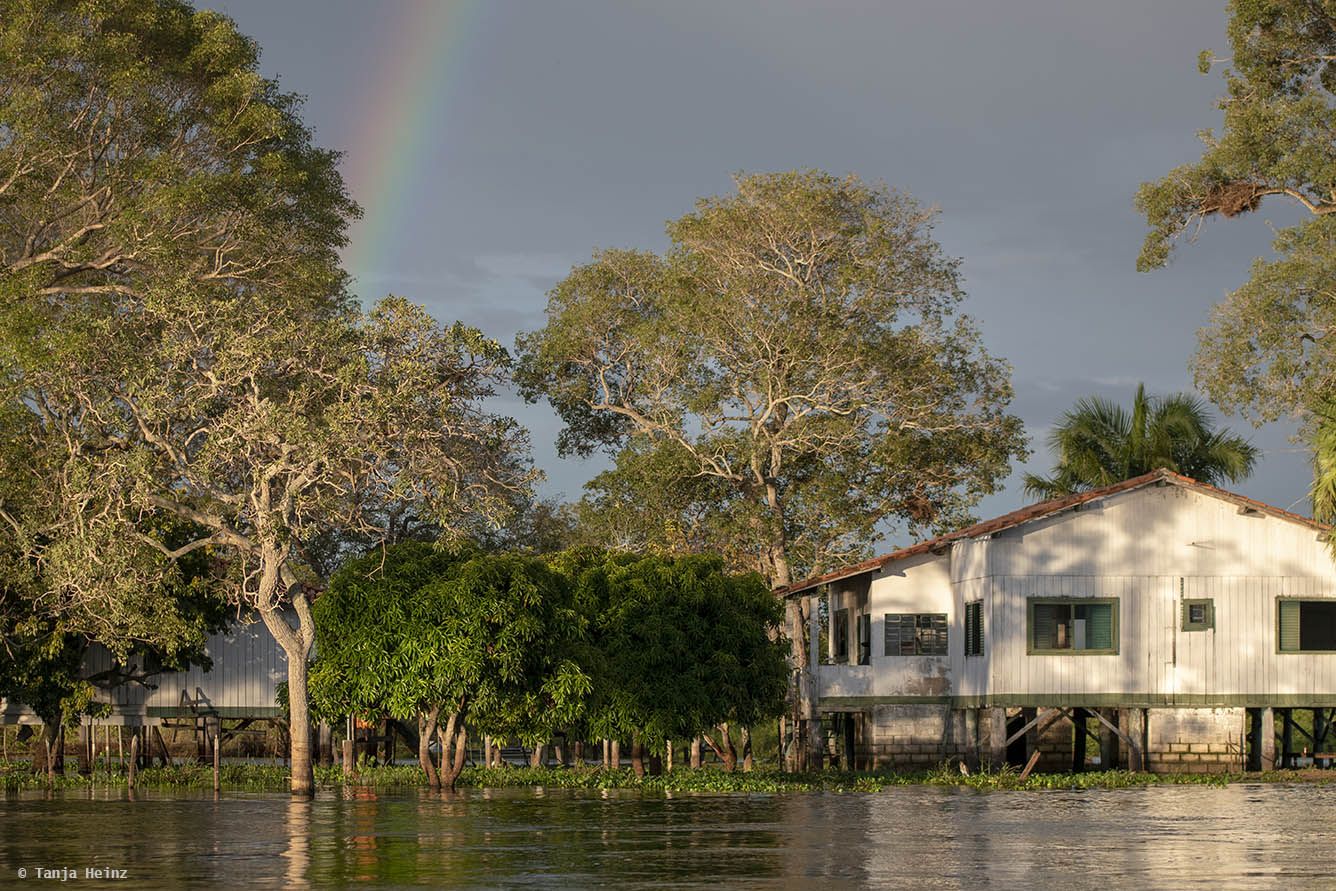
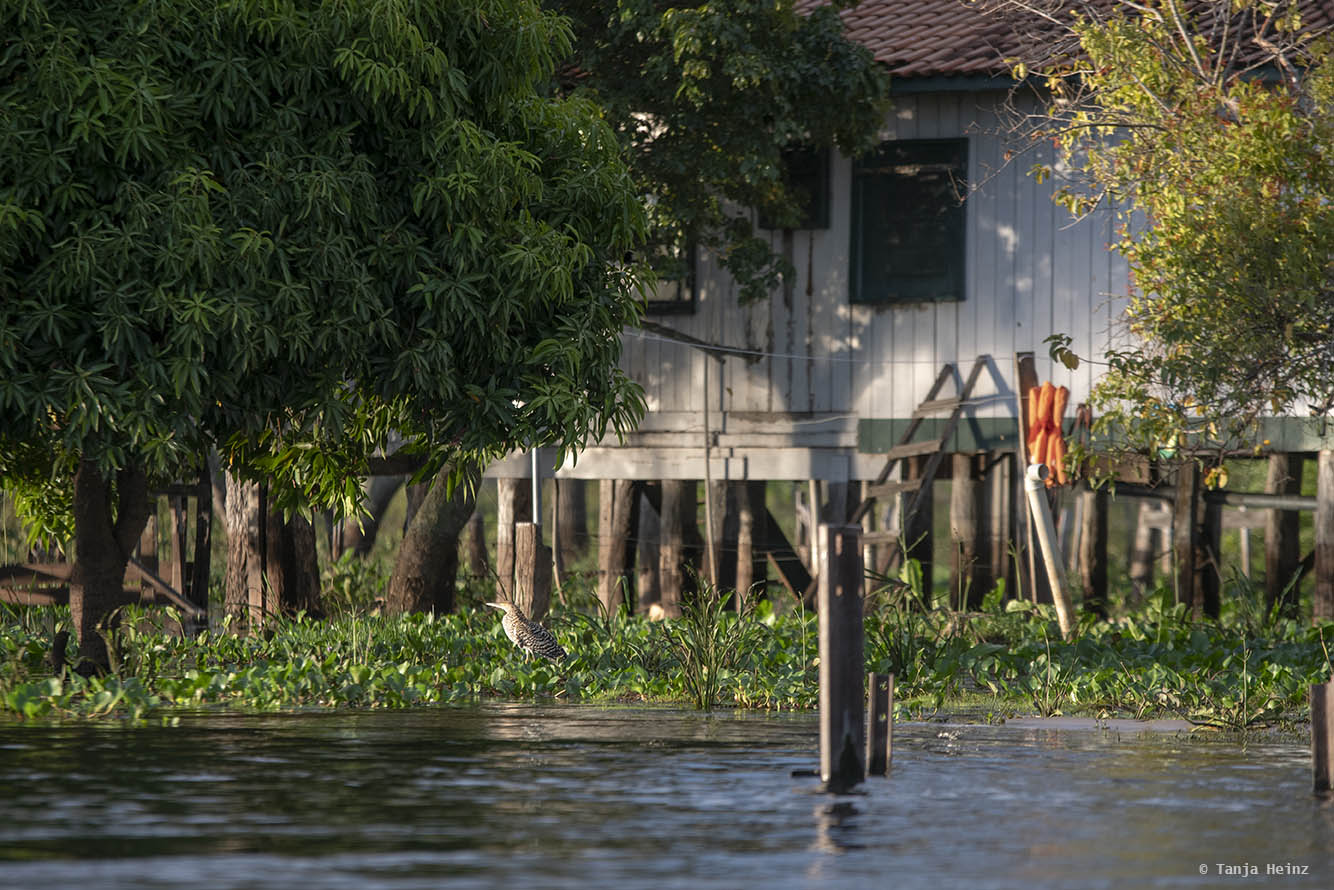
As rain was in the air we were surrounded by several rainbows.
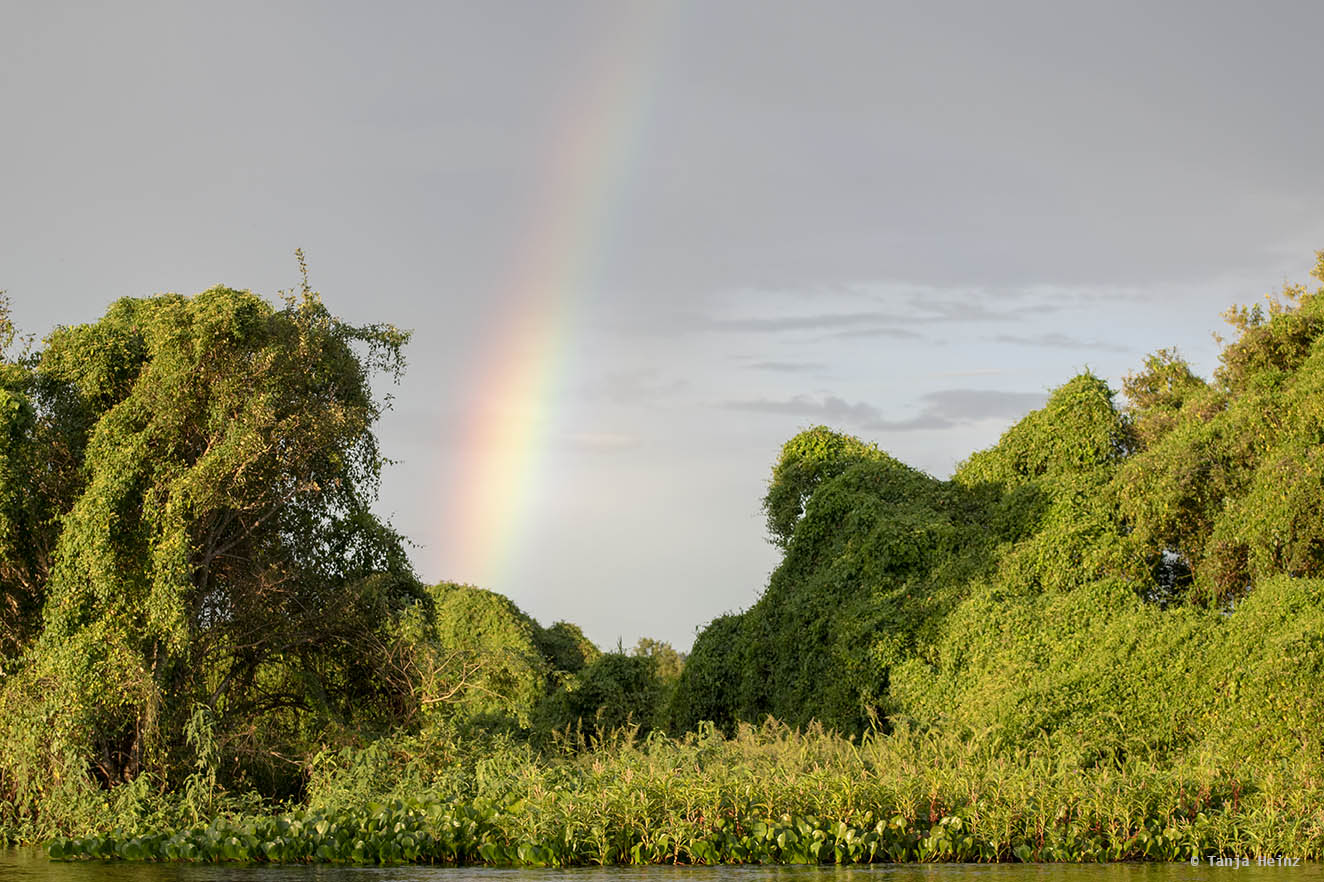
But anyway, some more herons were still around like a cocoi heron (Ardea cocoi) which was apparently followed by some cormorants. Some Neotropic cormorants (Phalacrocorax brasilianus) found a resting place close-by.
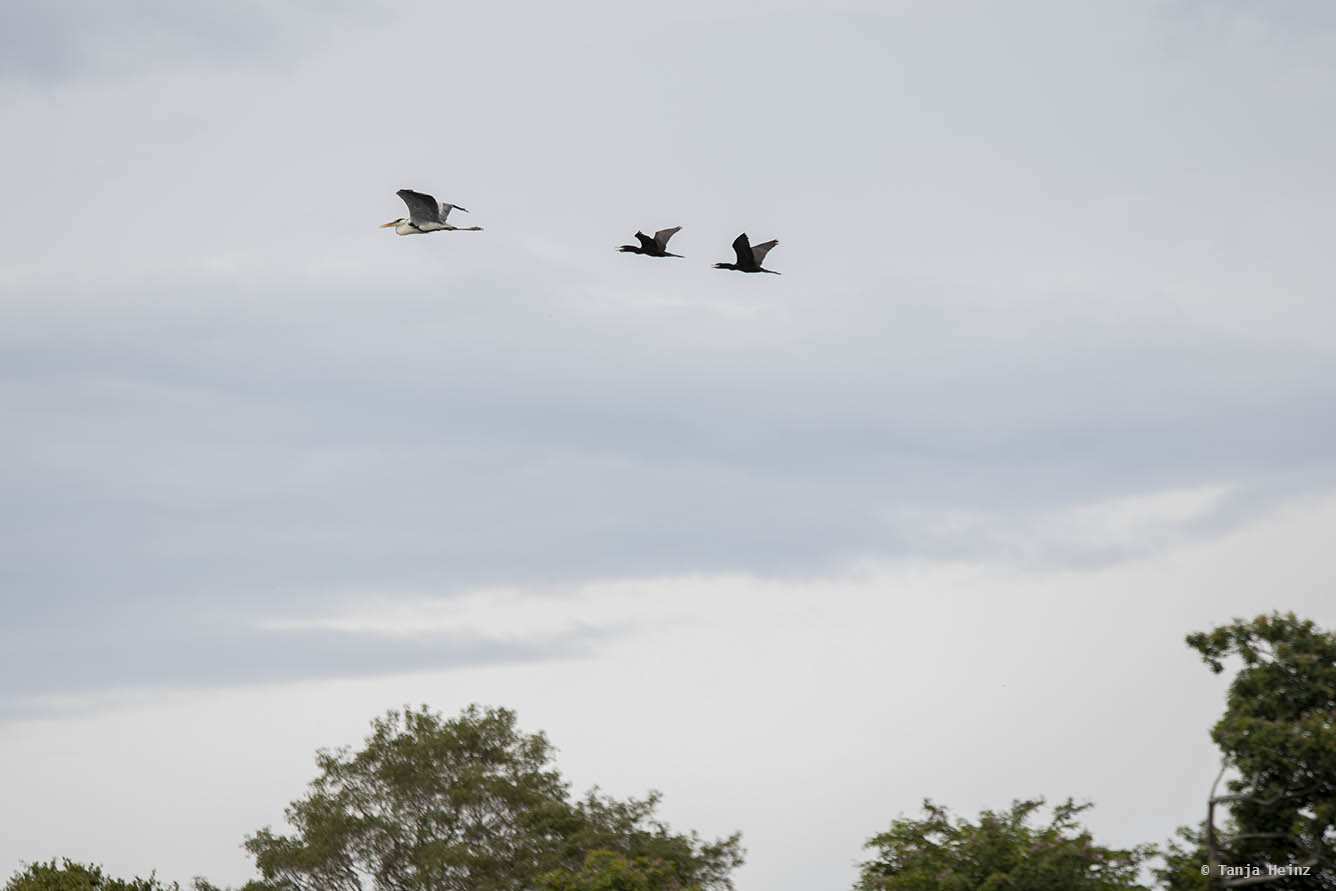
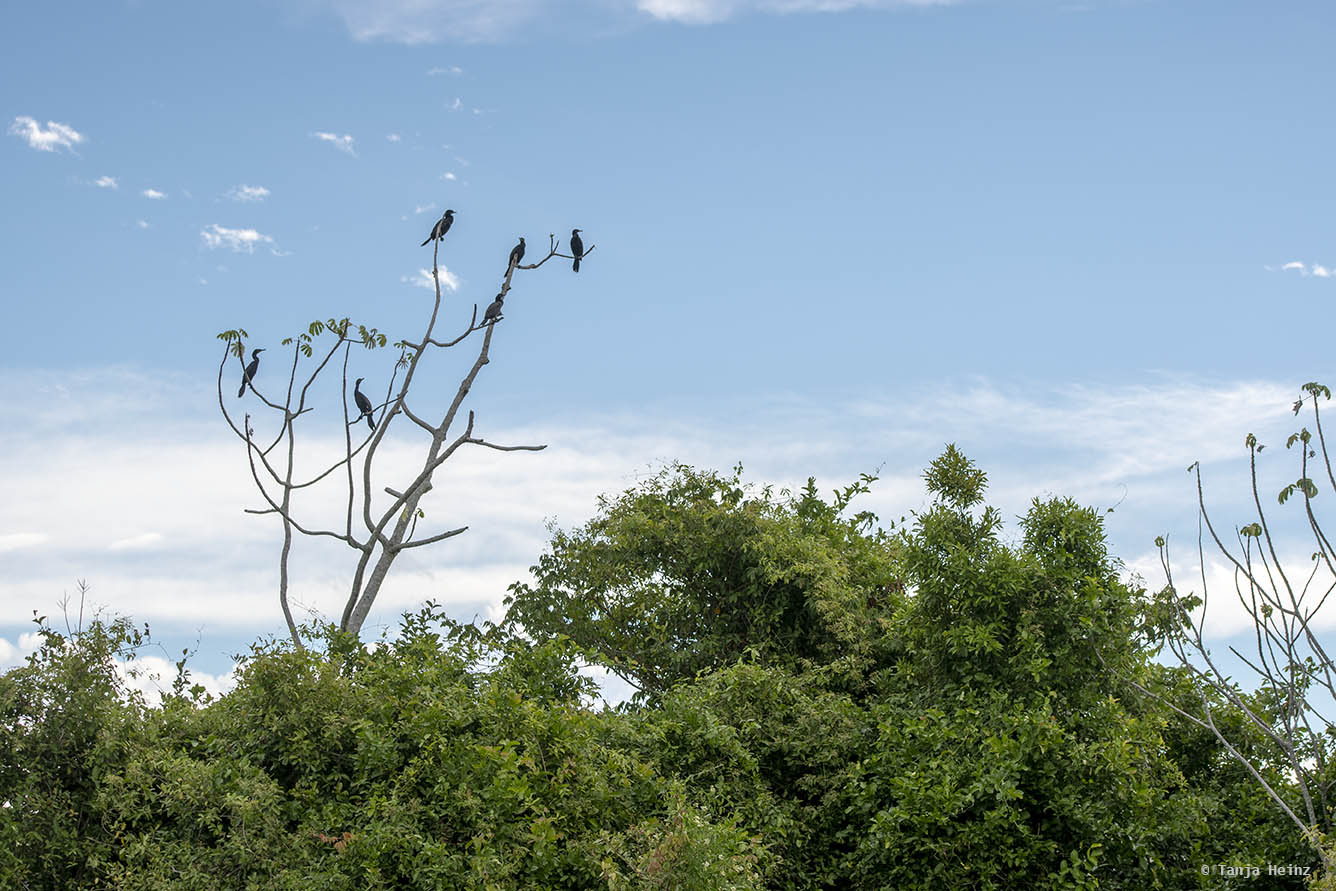
We observed quite many herons, egrets and cormorants on tree crowns, but also this limpkin (Aramus guarauna).
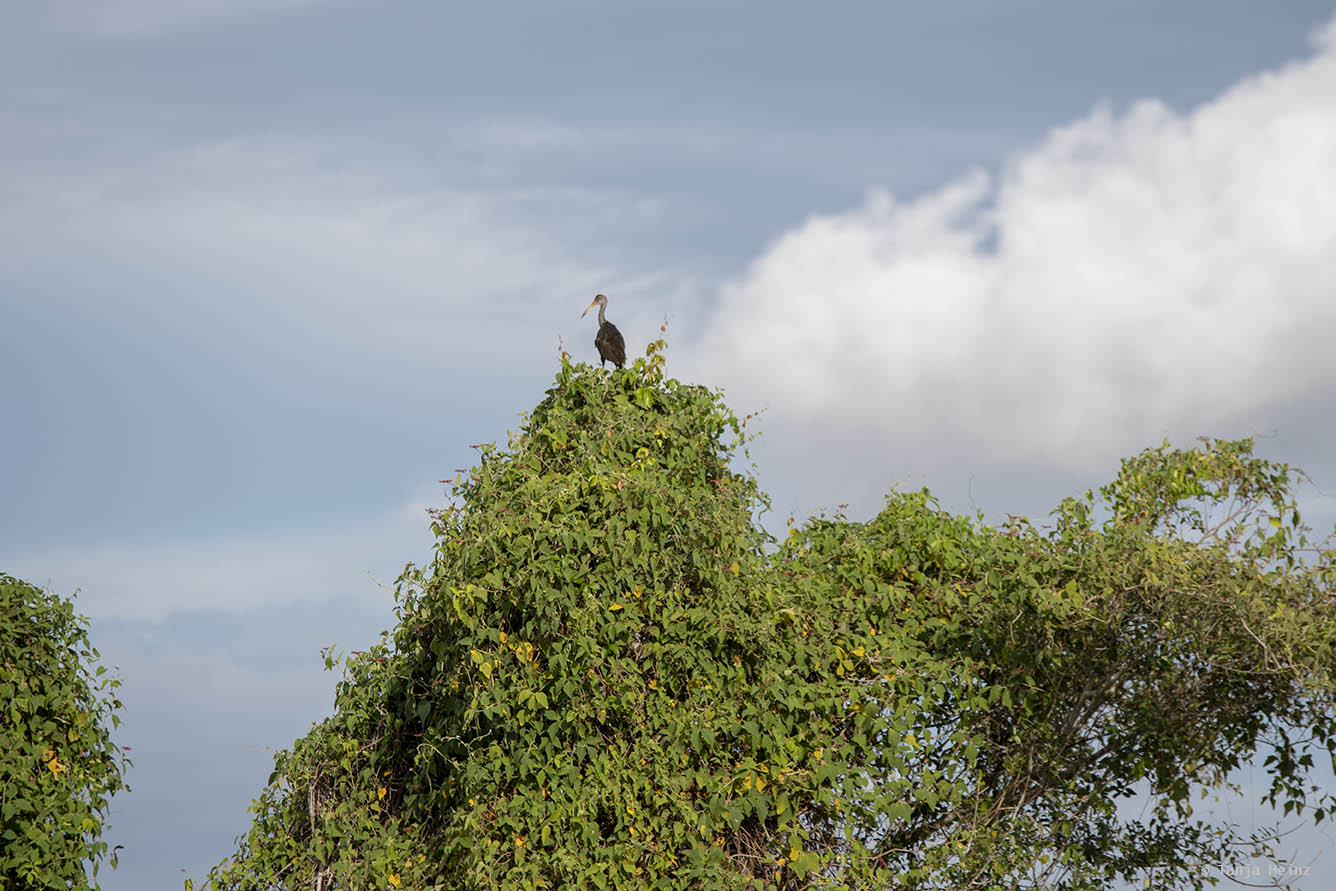
In one of the trees we saw tow Southern caracaras (Caracara plancus). In contrast to the other birds, I had seen these birds already before this encounter in the Pantanal. The first time I encountered Southern caracaras on my journey through the South of Brazil was in Itaúnas – another paradise for birders in Brazil.
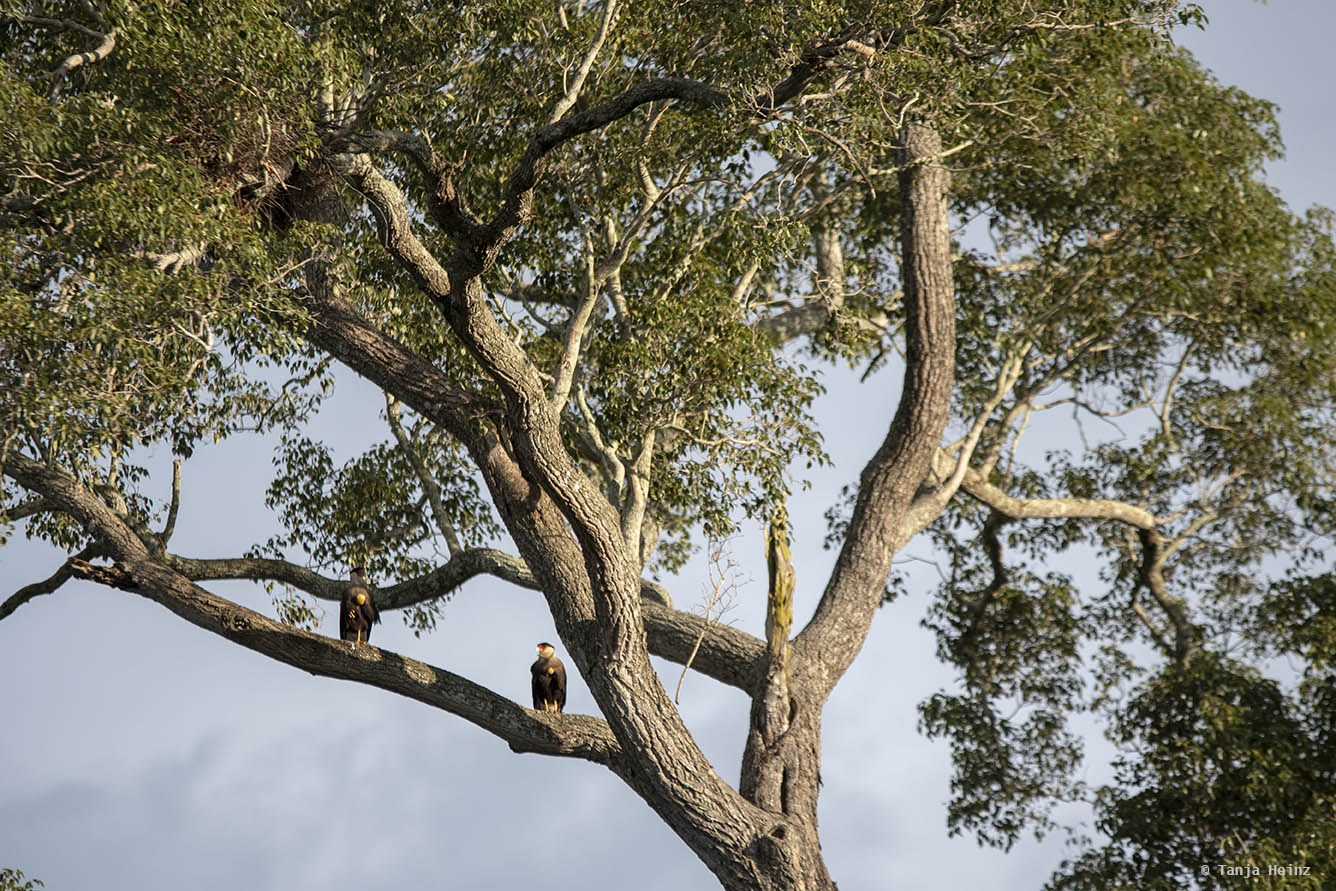
Another bird family we encountered quite often on those three days in the Pantanal was the family of kingfishers. However, on our boat trip we saw just ringed kingfishers (Megaceryle torquata). In the following days we would meet this species again and again.
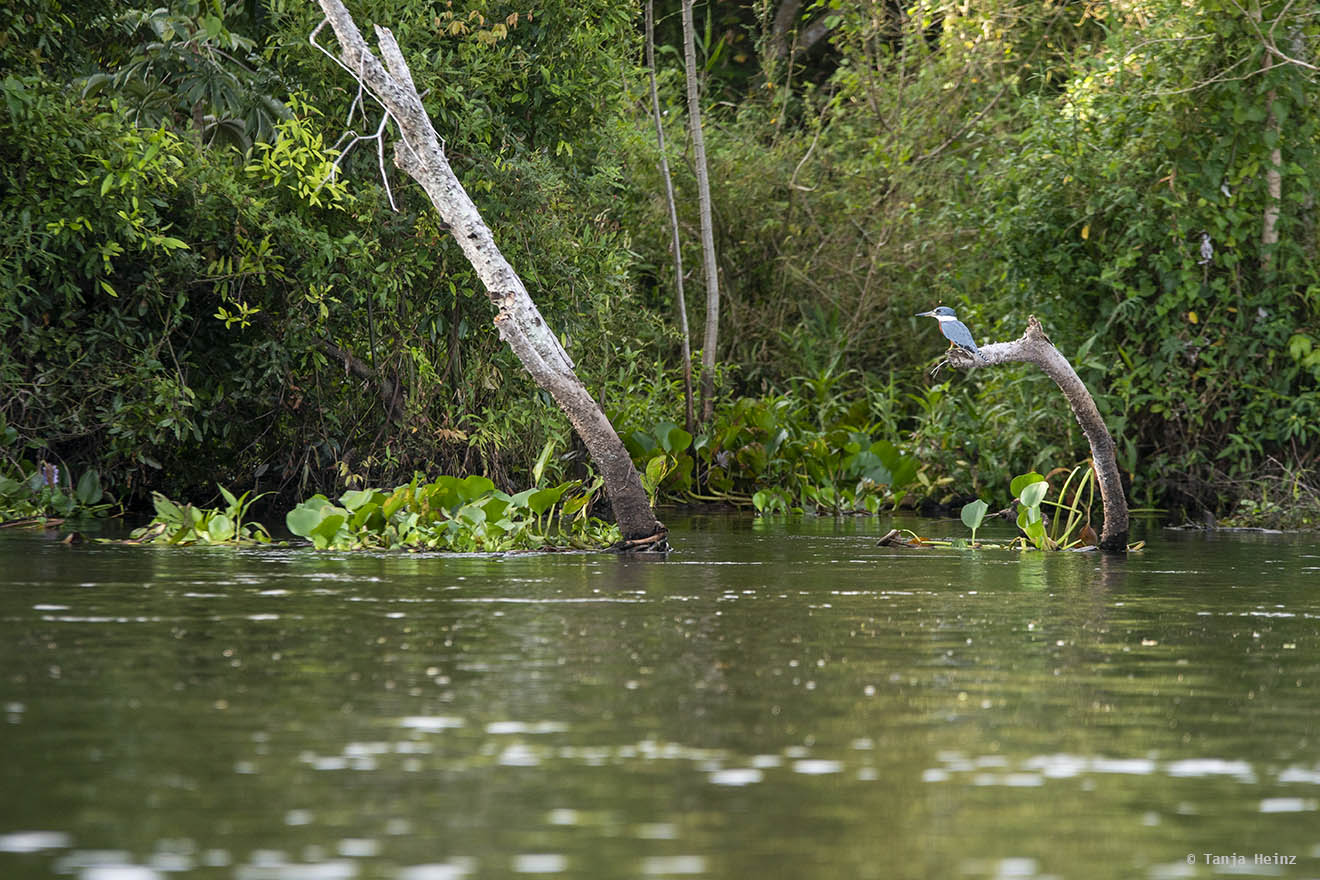
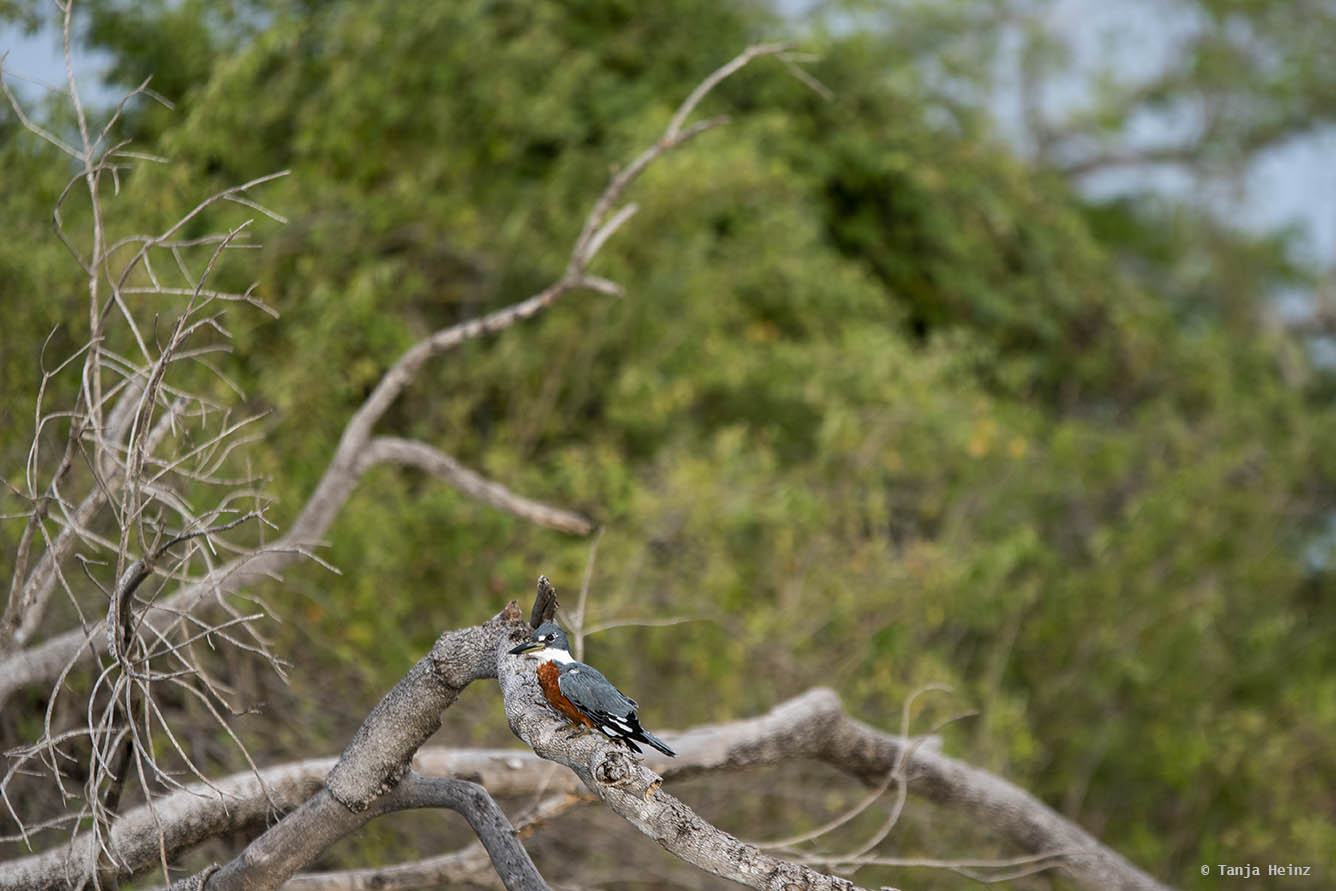
Another bird species I was happy to meet again was the toco toucan (Ramphastos toco). At first we saw just a single toco toucan, but later a couple. The first time I saw a toco toucan in Brazil was in Parque das Aves in Foz do Iguaçu – a bird park focused on the conservation of Brazilian birds. However, we also saw some wild toco toucans close to this bird park at the Iguazú Falls on the Argentinian side.
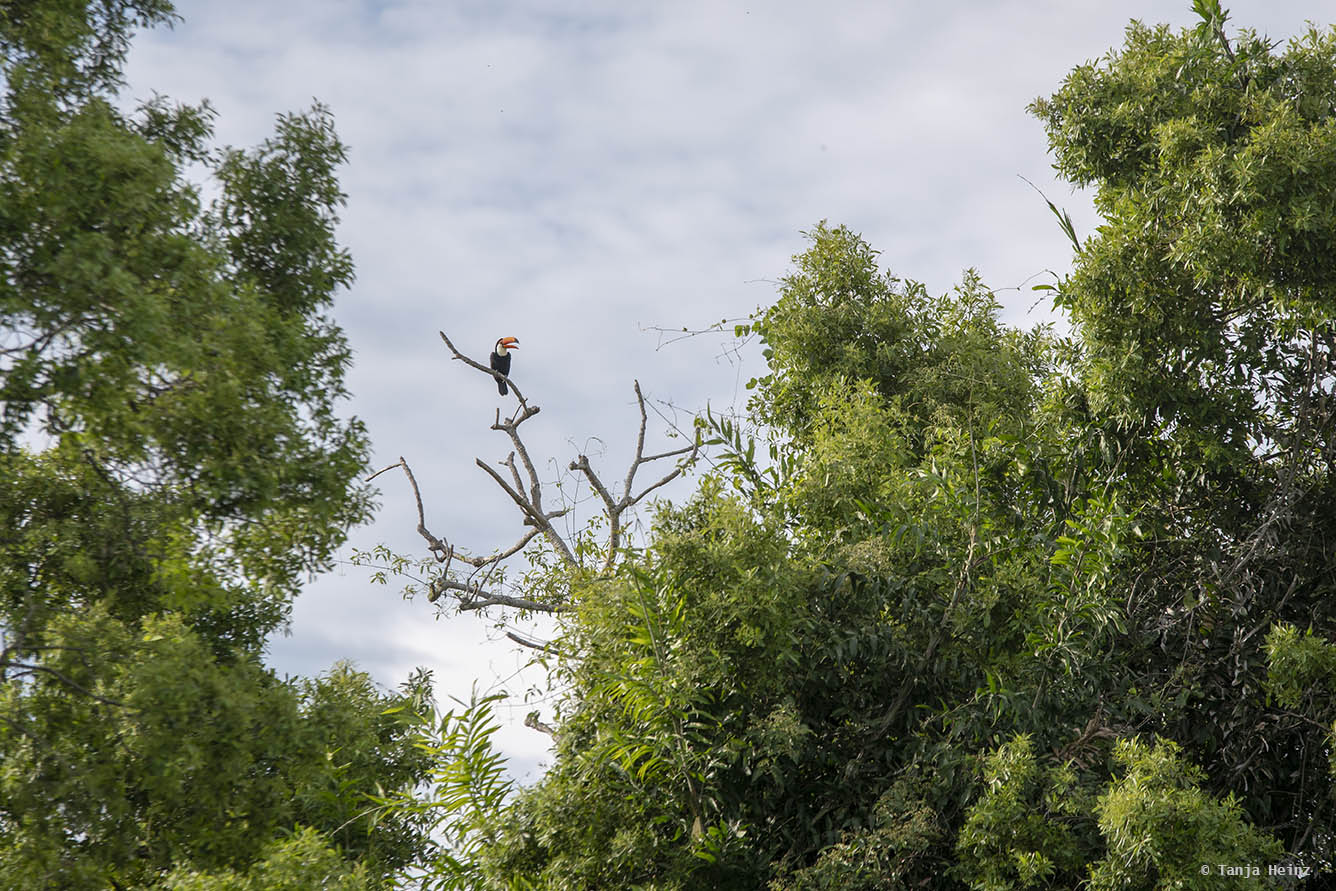
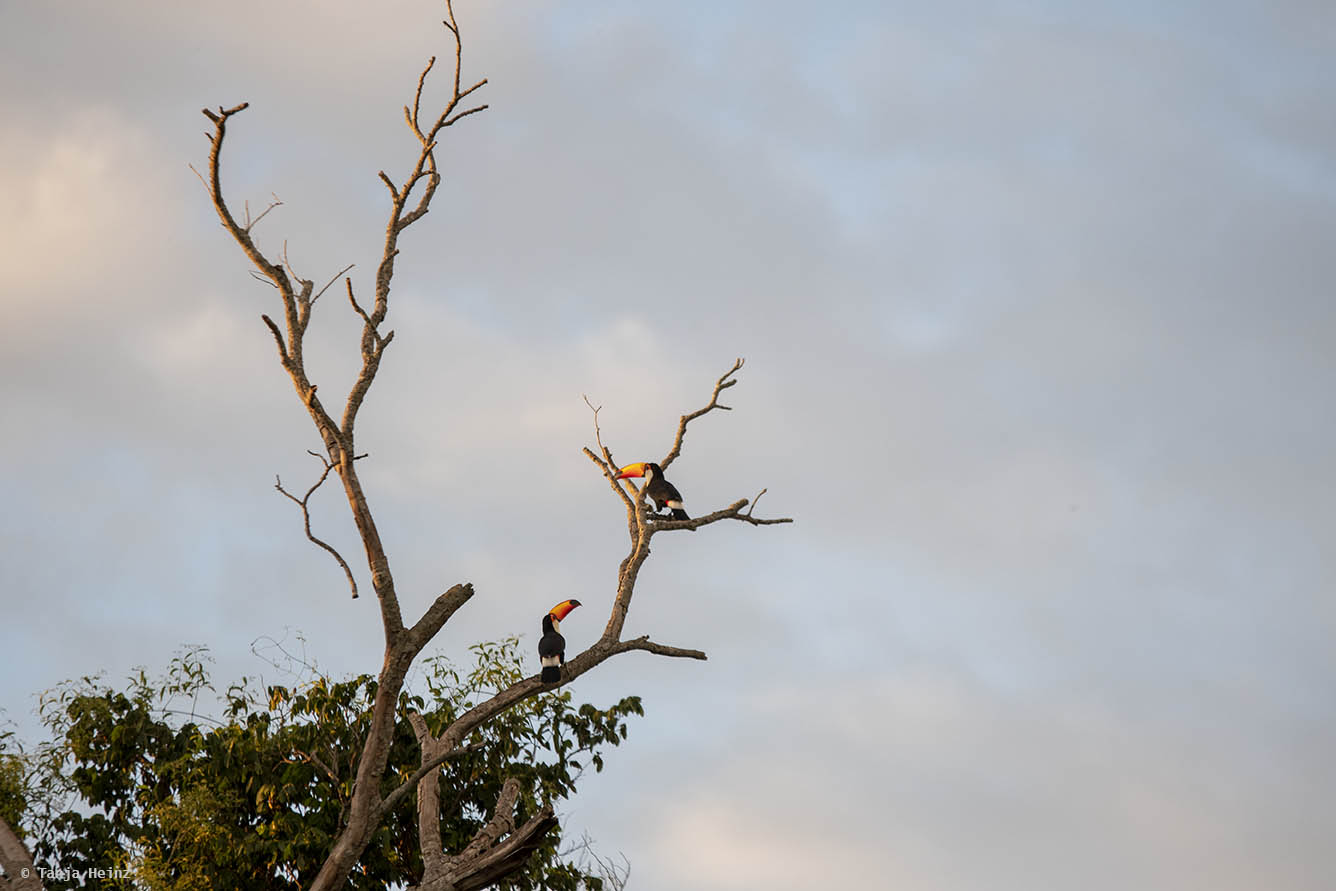
Nevertheless, it was getting dark and we had to head back. On our return trip we met some fishermen. And again we were accompanied by a beautiful rainbow in the background.
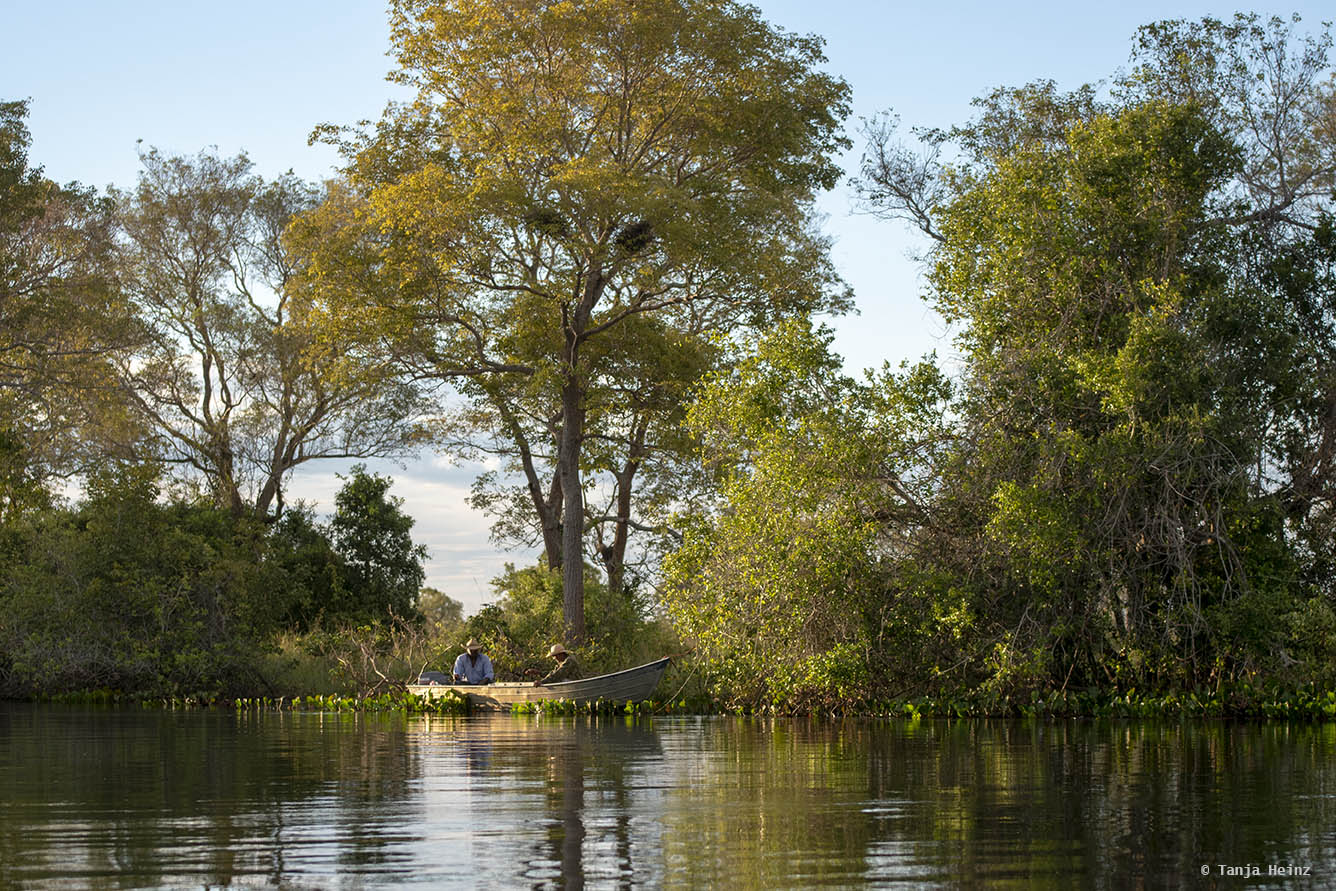
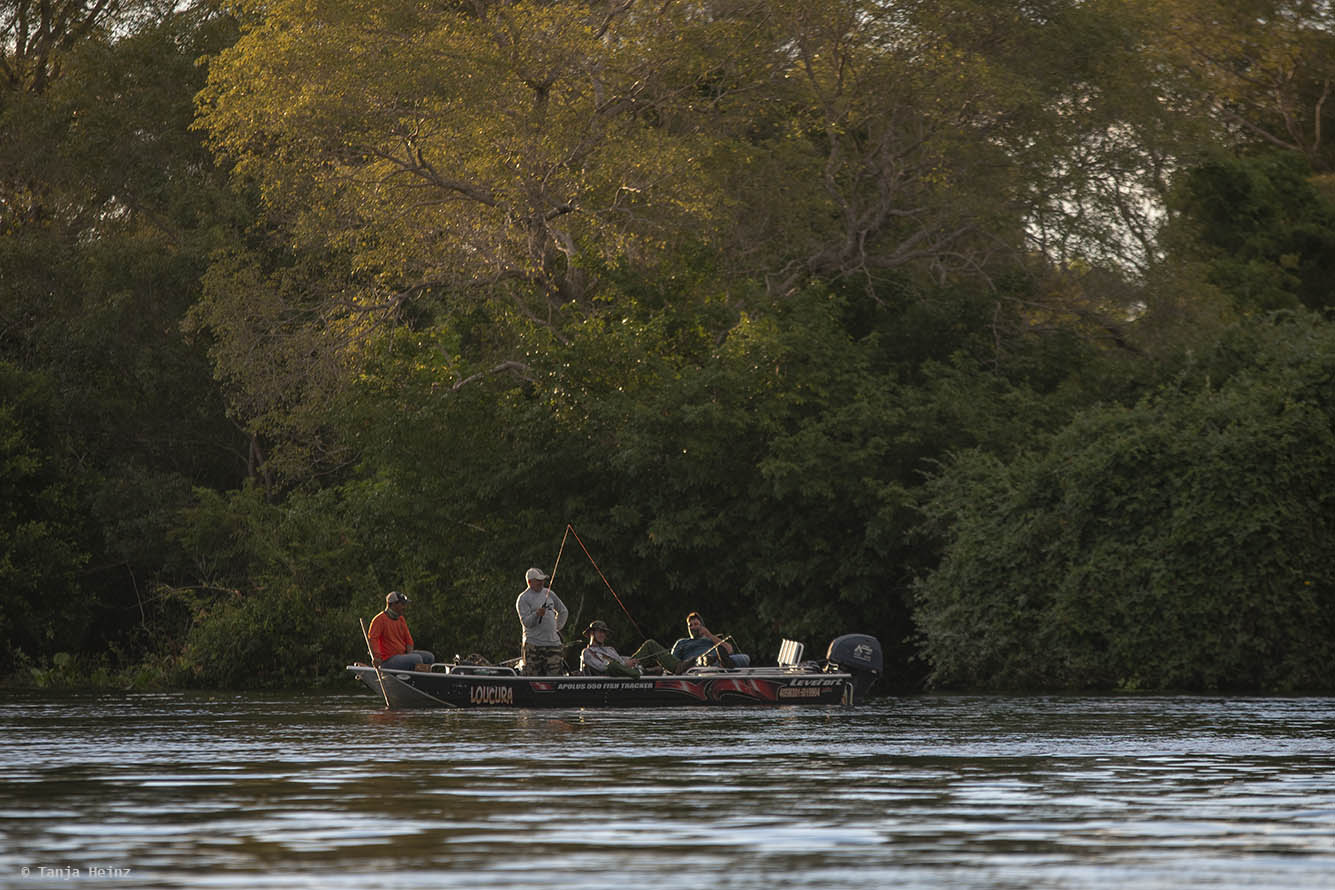
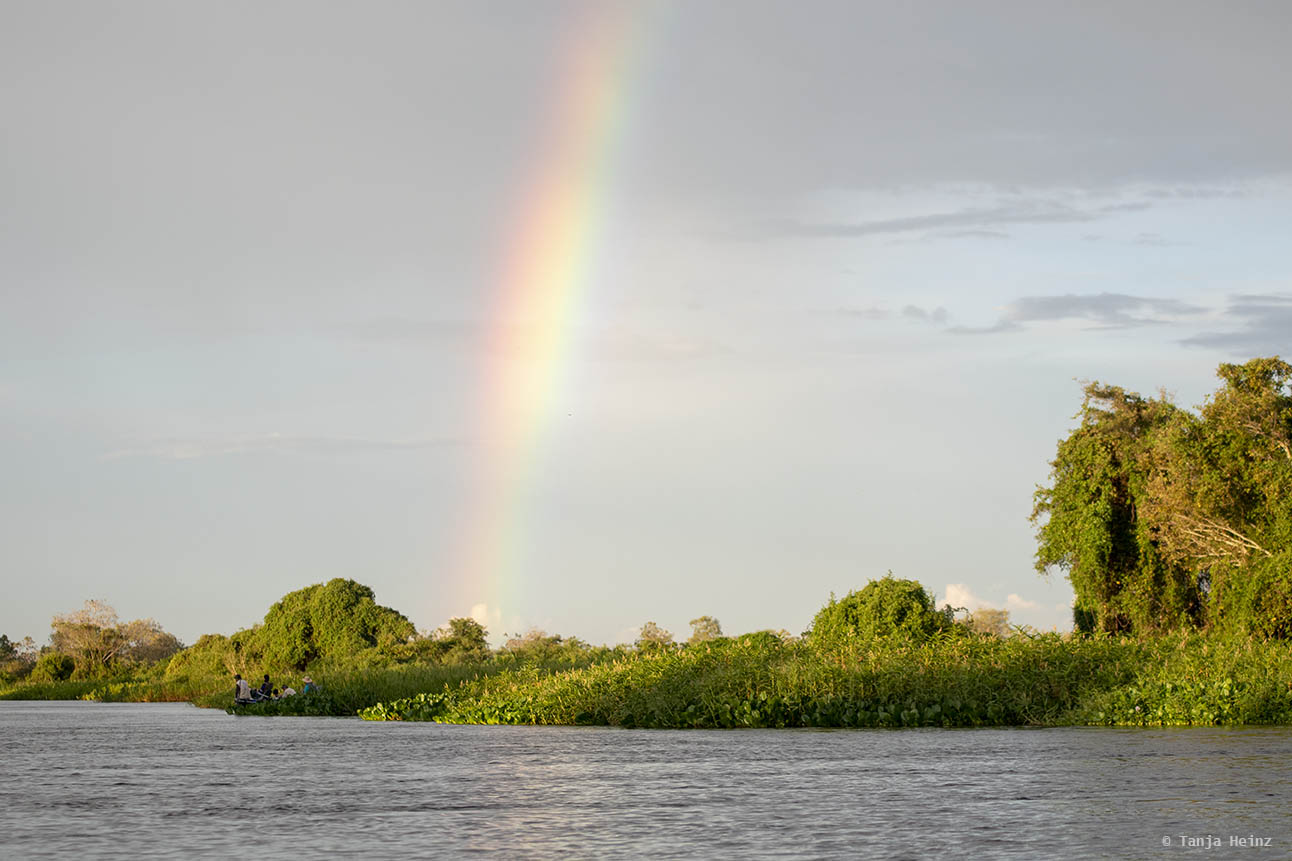
These were our first impressions of the Pantanal in Brazil on our first day.
A walk and more wild animals
On our first day we explored the Pantanal by boat. On our second day we joined a walking tour in order to find more wild animals. Actually, I did not really expect to spot a jaguar on our tour. Firstly, it was not the best season. Secondly, the walking tour was during the day. And thirdly, you need a lot of luck spotting an elusive cat like the jaguar. So I wasn’t really surprised not to see a jaguar. But a capybara or a giant anteater? It would have been great to see them. However – maybe you already guess it – we didn’t see them. Anyway, I also wished to spot some howler monkeys, as we were not lucky on our search in the Itatiaia National Park. Did we see them this time? Yes, we did.
However, it was almost at the end of a nice three-hour-walk through some forest. We passed some muddy areas and crossed a river.
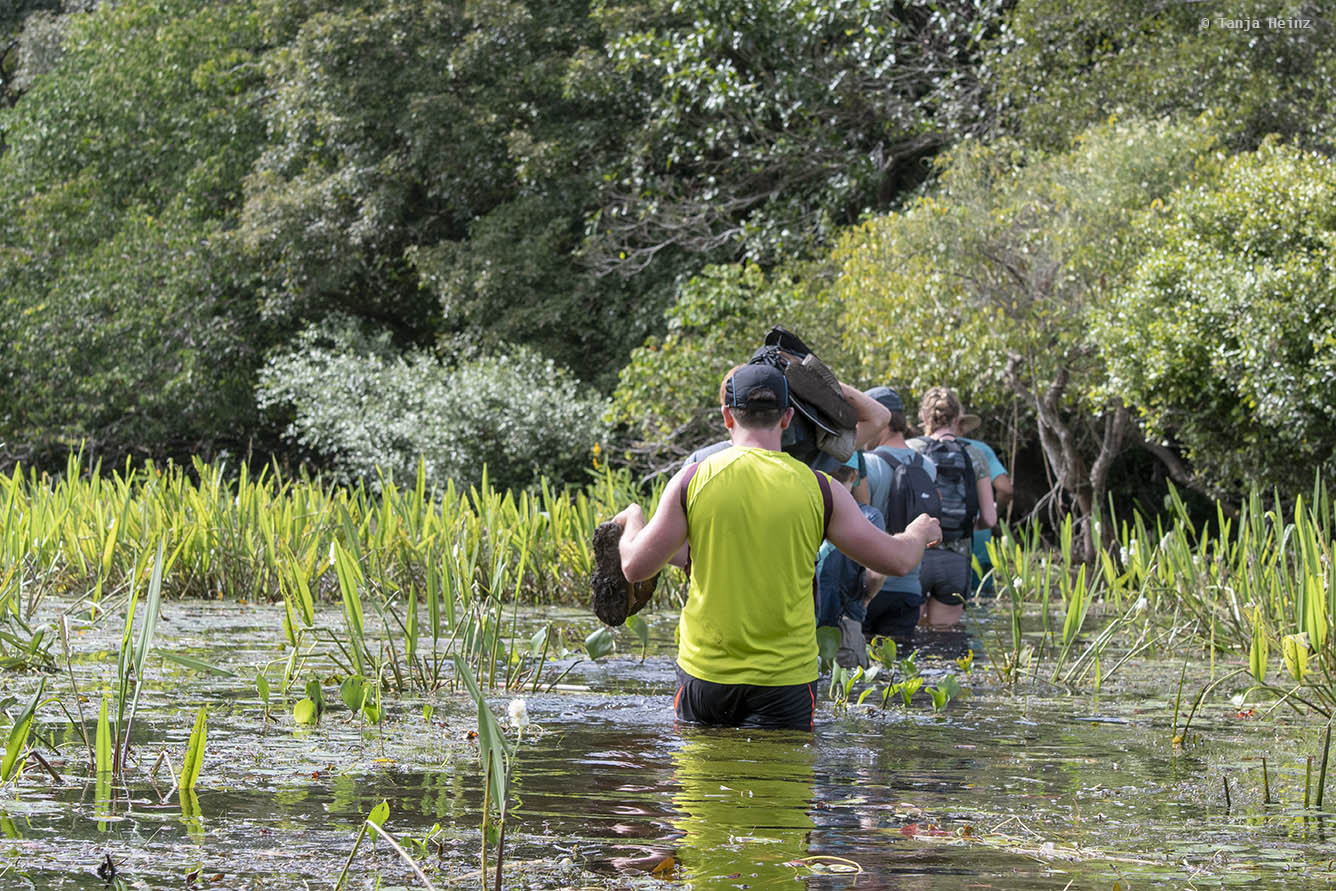
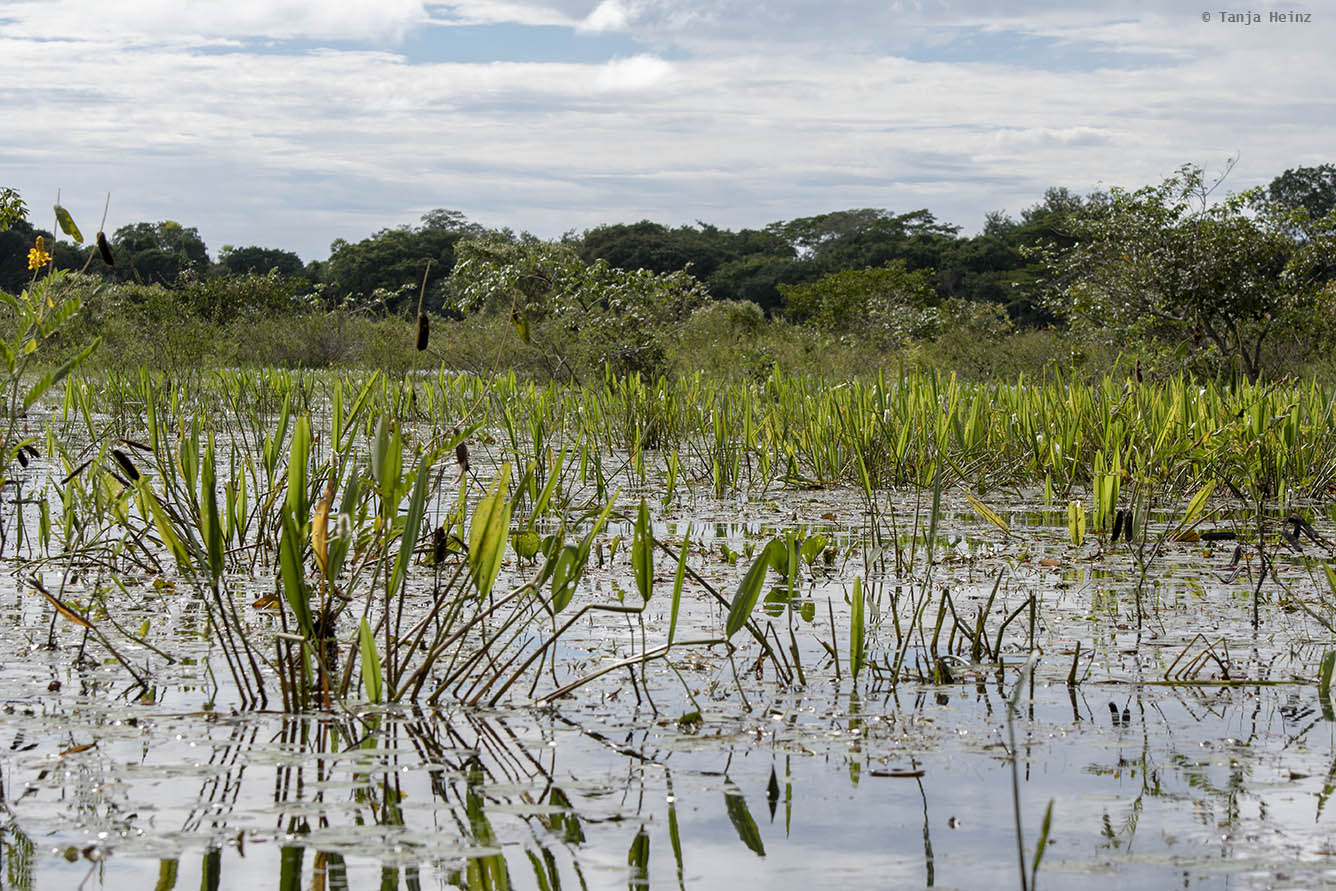
All of us were soaked, but we kept walking through the forest. And finally we heard some noises similar to those in the Itatiaia National Park. Howler Monkeys. I was more than happy to see them. It is not that I keep a list of animal species I wish to see. However, after seeing Golden lion tamarins, Southern muriquis, capuchin monkeys like Crested capuchins or black capuchins, maybe I became a little bit obsessed to see more monkey species in the wild. Anyway, we saw a female (yellow color) and a male (black color) howler monkey. The male was quite nervous. Was it because of us? No. There was another male around. Unfortunately, we couldn’t observe them. We stayed only about five minutes under the trees and then we had to leave again with the tour guide.
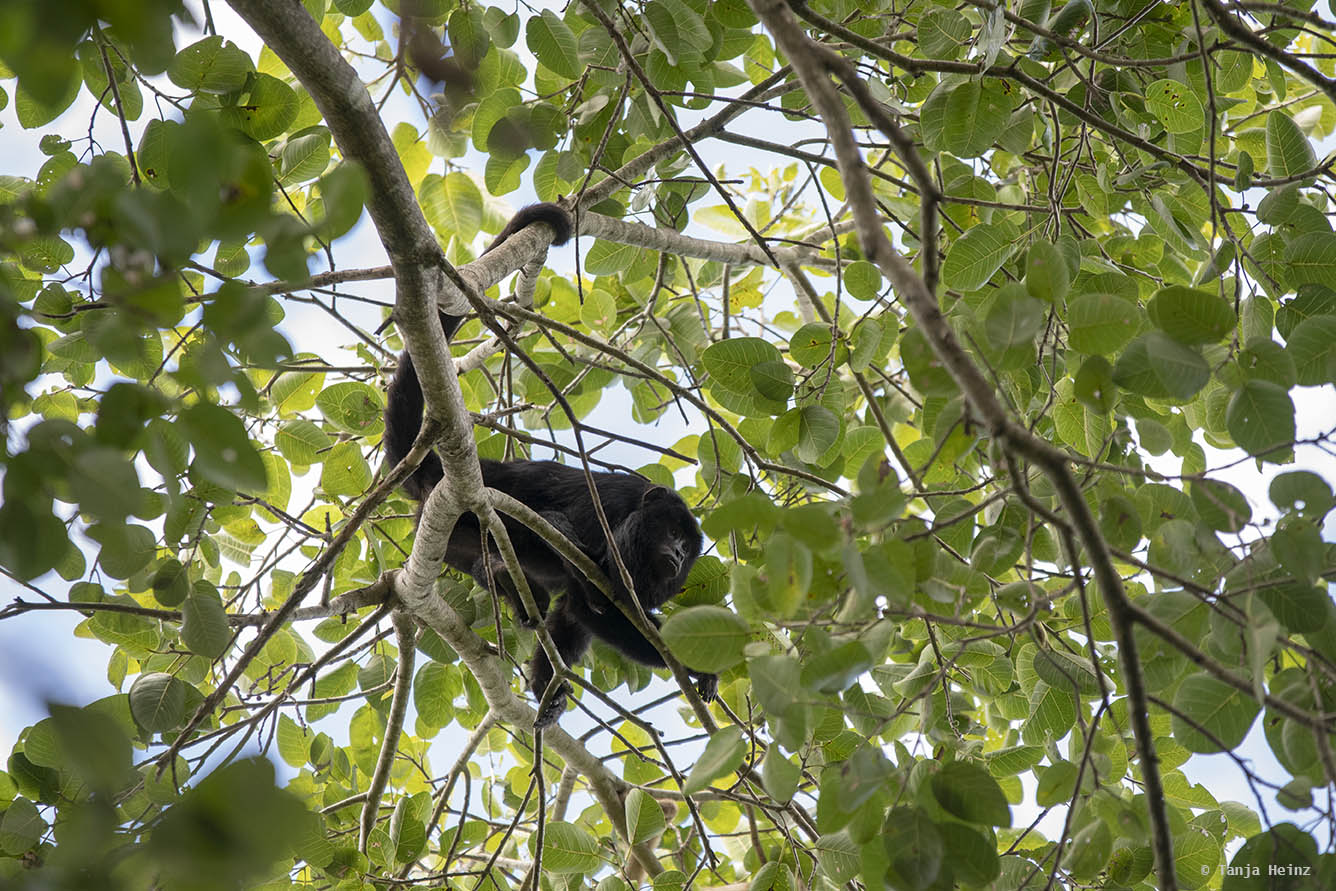
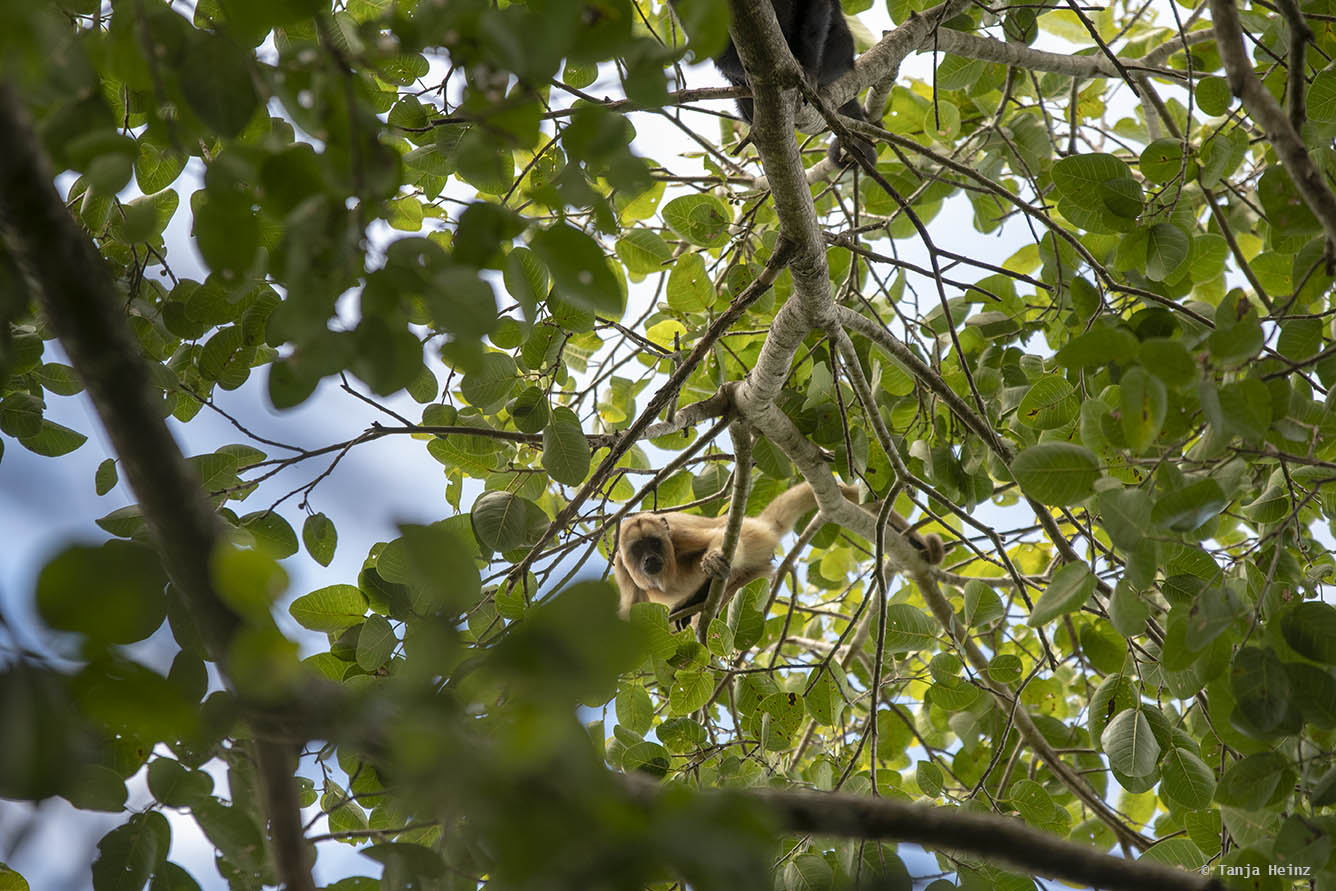
The programme was already planned. So we had to follow the guide. In the afternoon we would go horse riding.
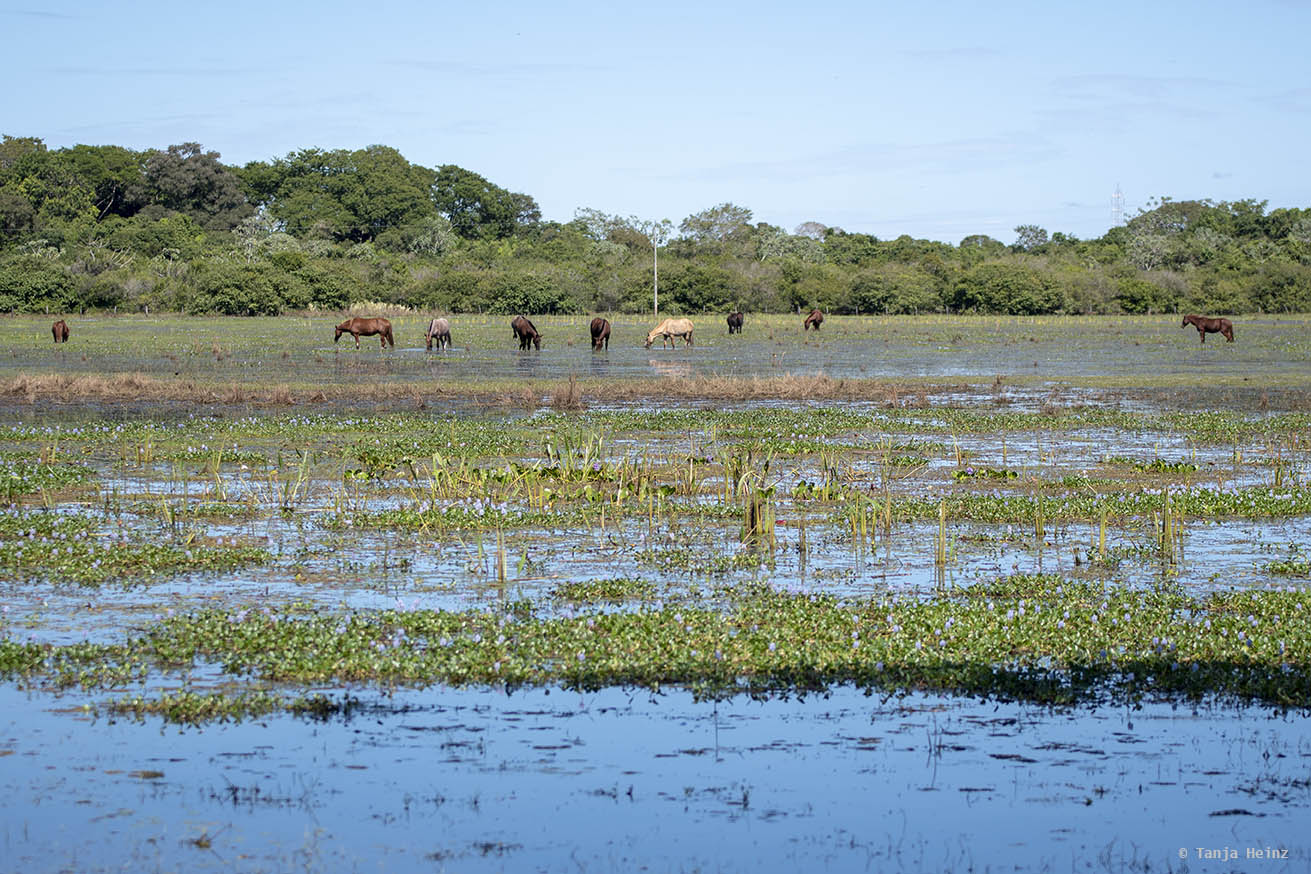
On our horse riding trip we went through the rivers by horse (where also venomous snakes live). I usually do not ride horses. So I’m not a good horse rider at all, but I managed not to fall from the horse. The horses are well trained to bring untrained tourists like me through the Pantanal. Honestly, I’m not sure what I should think about all this. I don’t know much about horses. Therefore, I’m unsure if it was a good decision to ride a horse in the Pantanal in Brazil. At least the horses did not look abused. But how was the training for them? I was torn.
As I did not take my camera with me, I cannot show you photographs of the horse riding trip. I neither took some photographs on our night walk safari, but I was lucky enough to witness a wonderful sunset on one evening close to our accommodation.
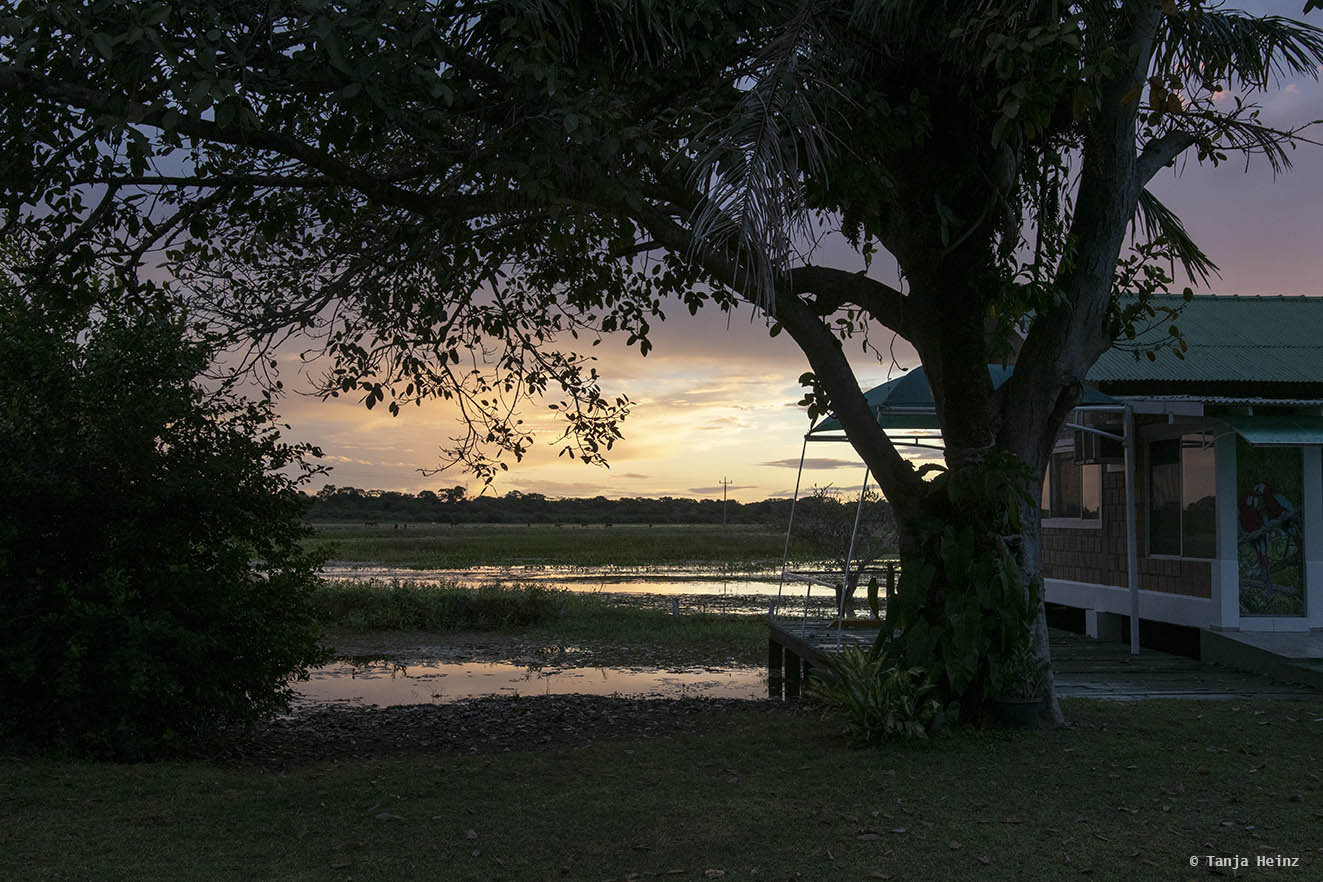
On the other side of the houses was a tree in the middle of the flooded area.
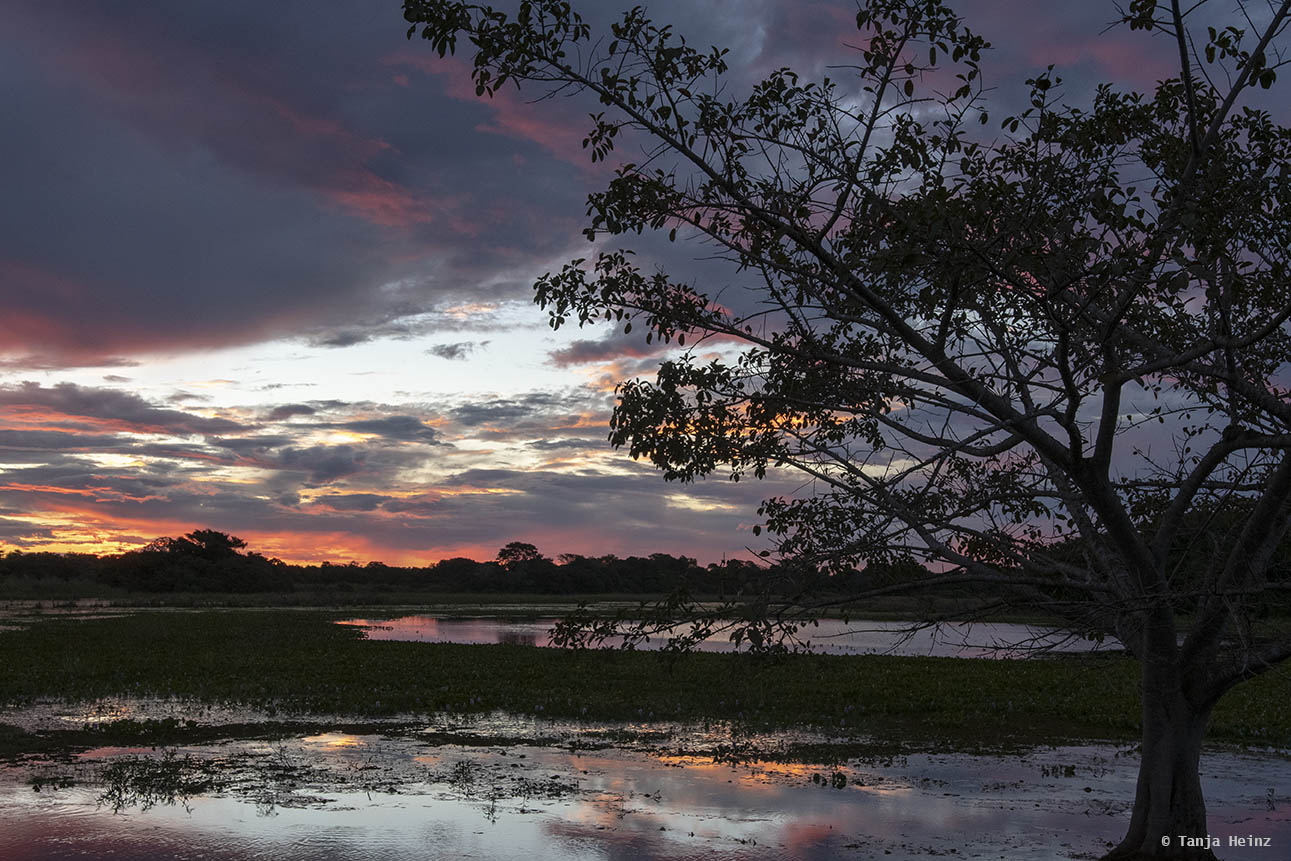
The colors were amazing and changing from minute to minute.
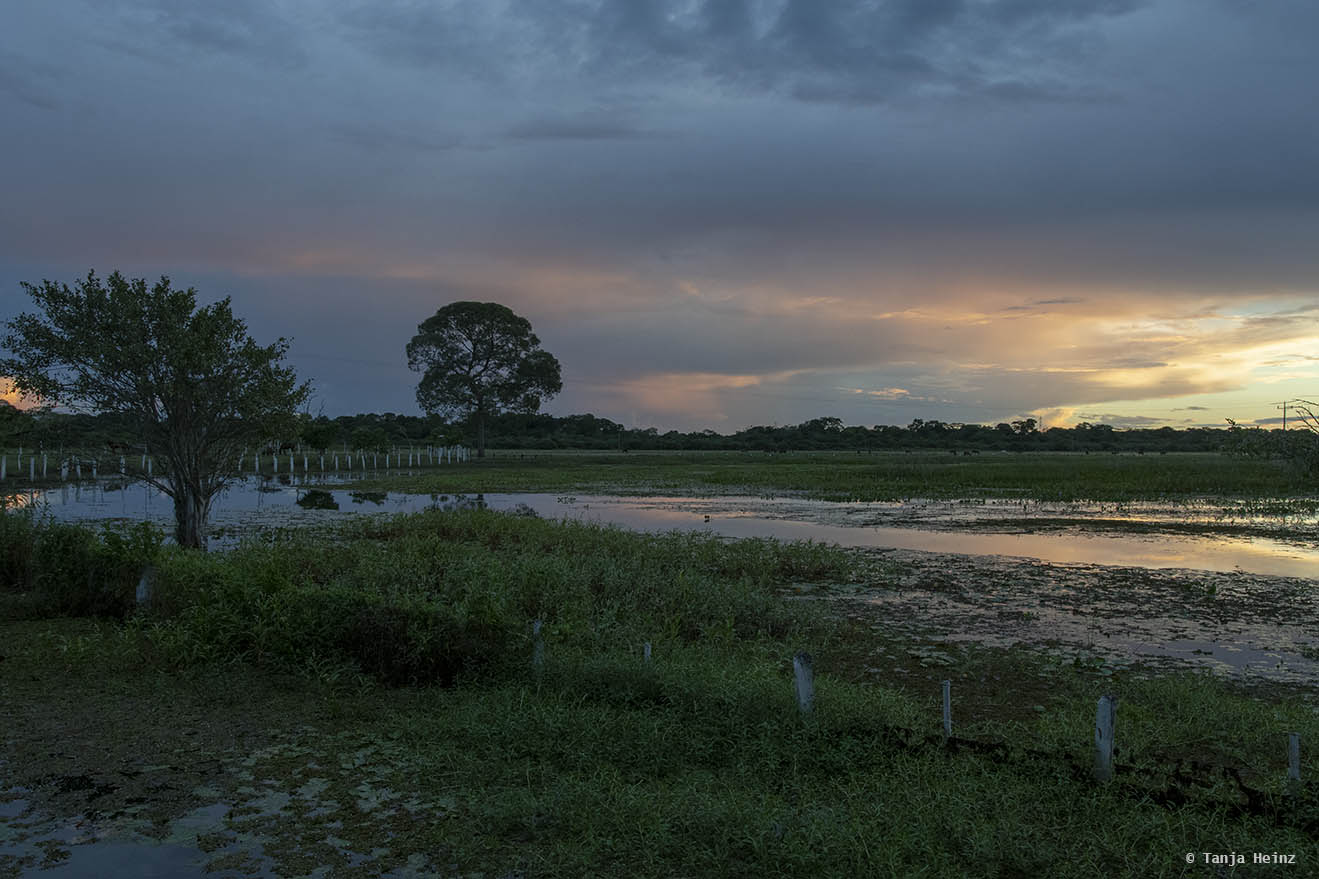
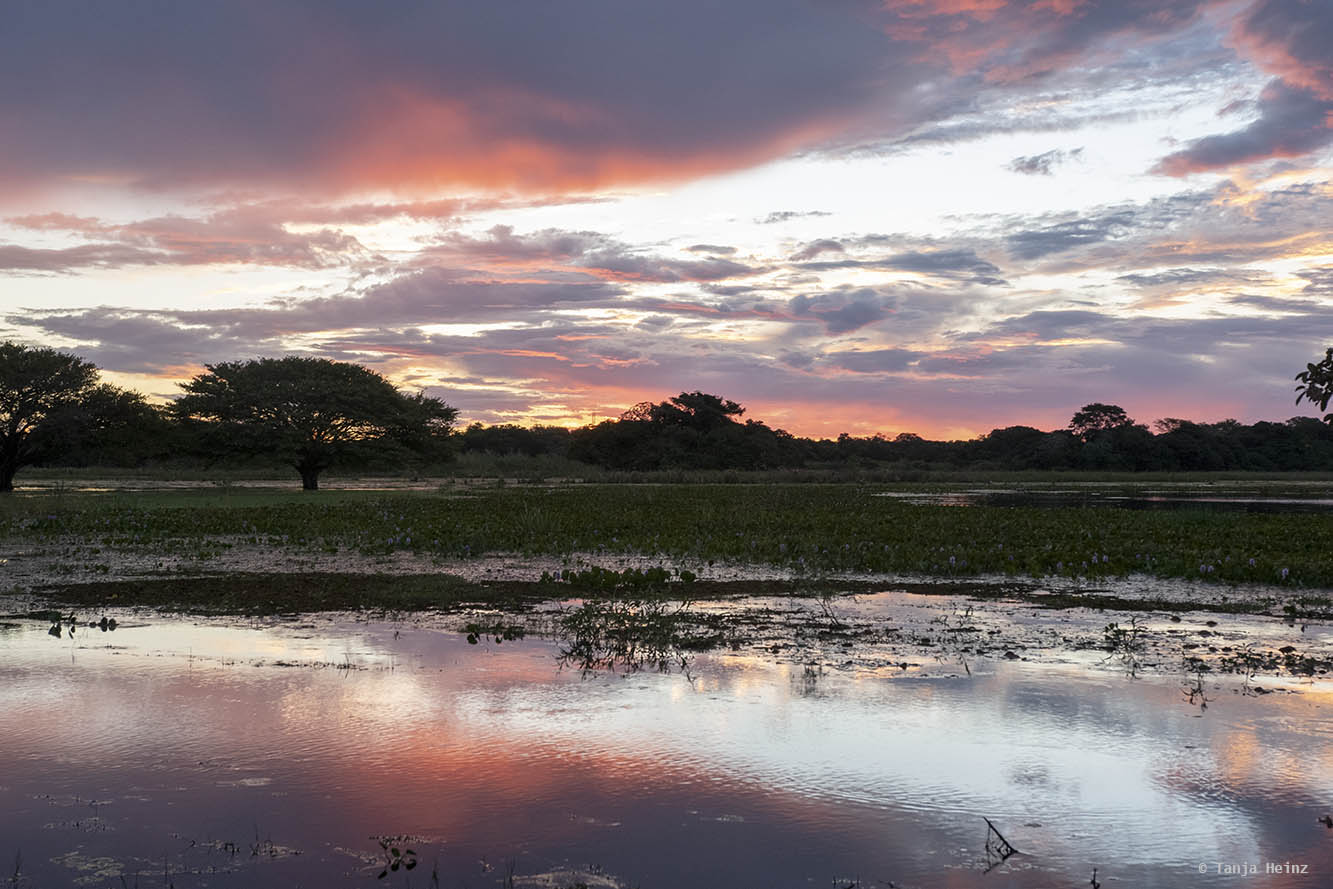
Although I did not see all animals I wished to see, we still could spot some interesting animals on either our walking tour, safari by car or around the Fazenda. In the next two paragraphs you will read more about the animals we saw on the tour.
Wildlife in the Pantanal
In this and in the following paragraph I will show you more about wild animals that live in the Pantanal in Brazil. As we saw such a great variety of different birds, I will focus in this paragraph only on wildlife, that means, mostly on mammals, but also one reptile. And in the next paragraph I will write only about birds we encountered.
Yacaré caiman (Caiman yacare) Least concern
The Yacaré caiman is a very typical reptile in the Pantanal and distributed across the center of South America like Bolivia, Brazil, Paraguay, and Argentina. It is endemic to this region, and thus, does not occur in any other place on Earth. As it lives in the center of South America, this caiman is restricted to inland freshwater. The Yacaré caiman was one of the first animals I saw on the boat tour. However, it was not our only encounter. Both on our walking tour and on a night safari we met some of them.
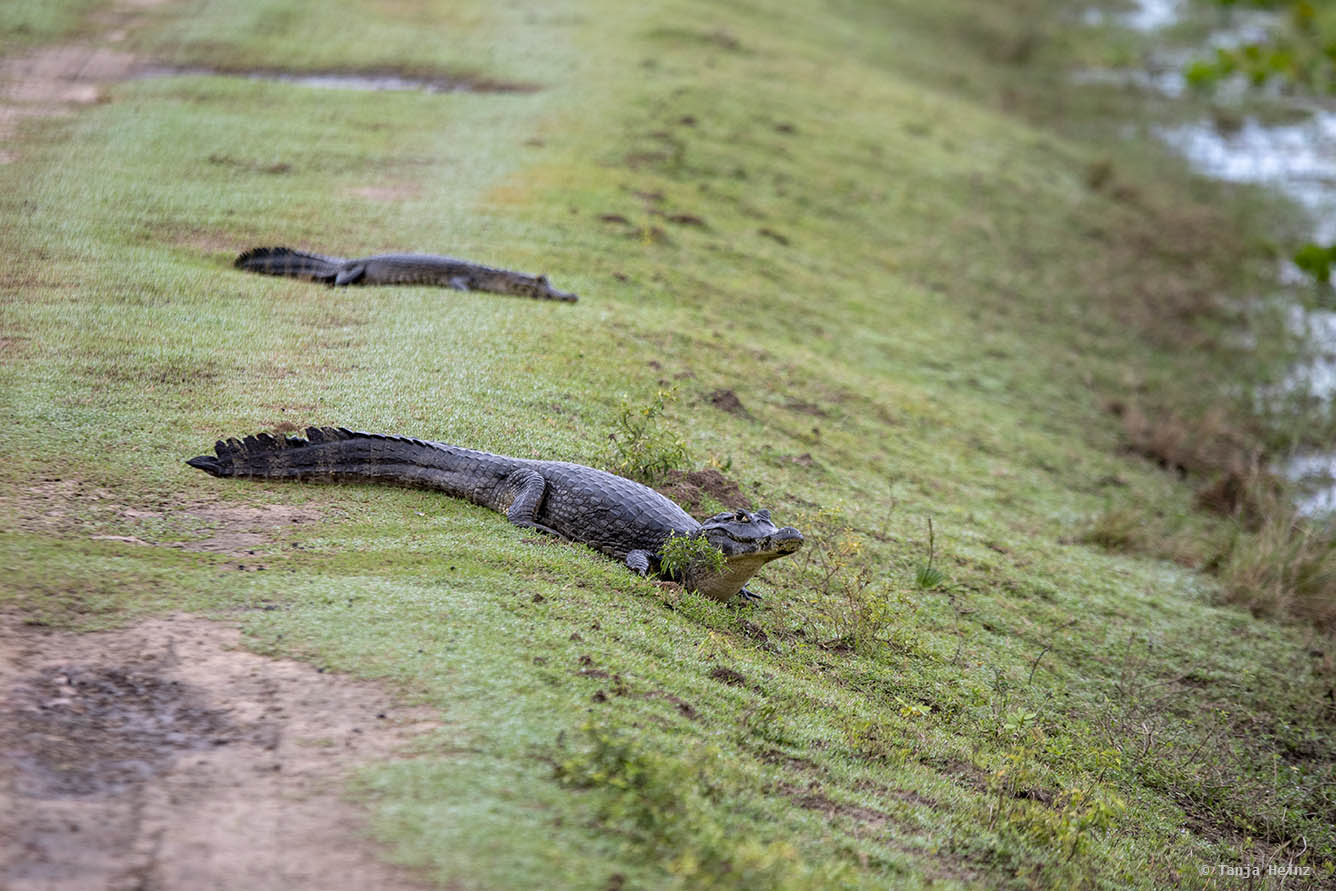
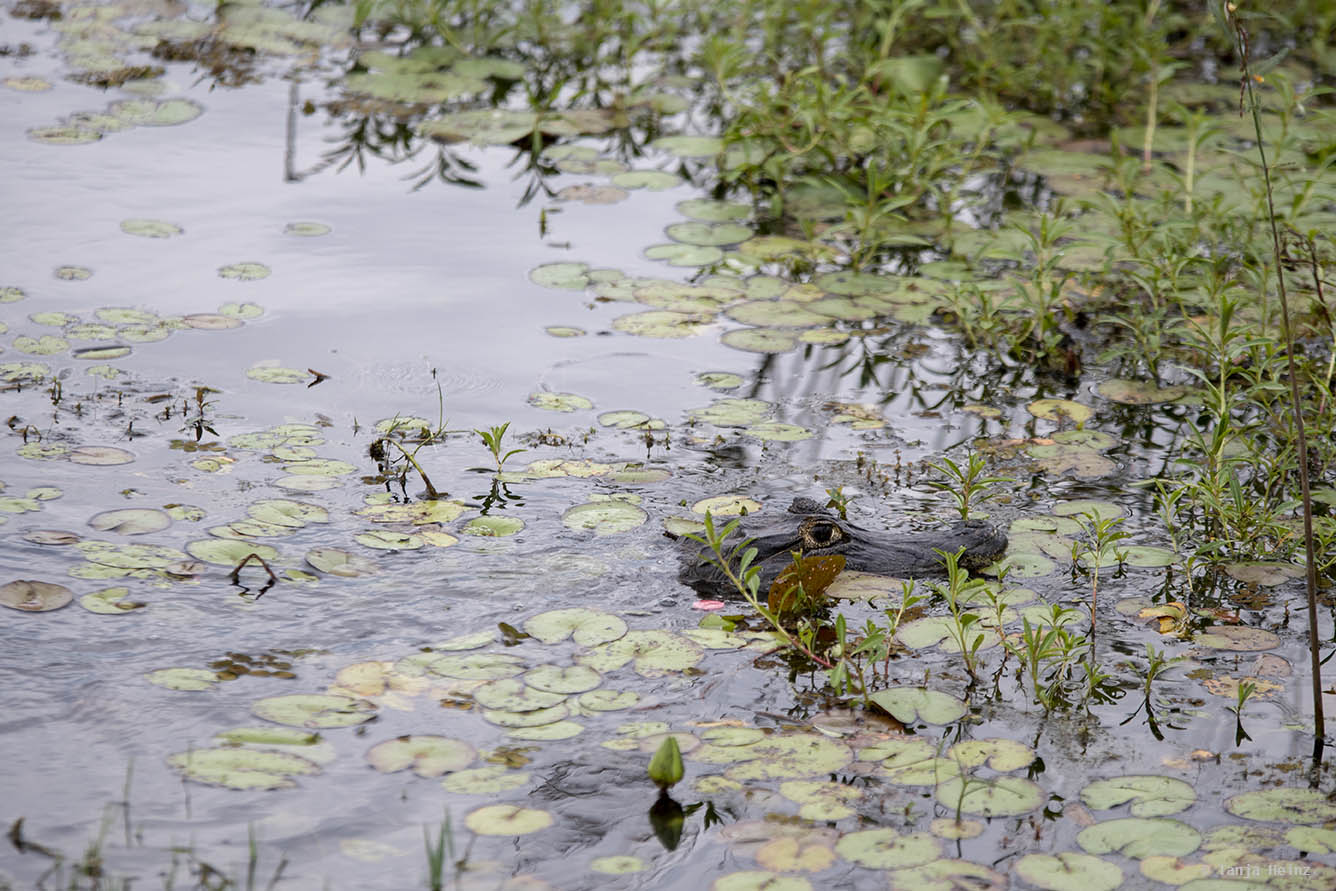
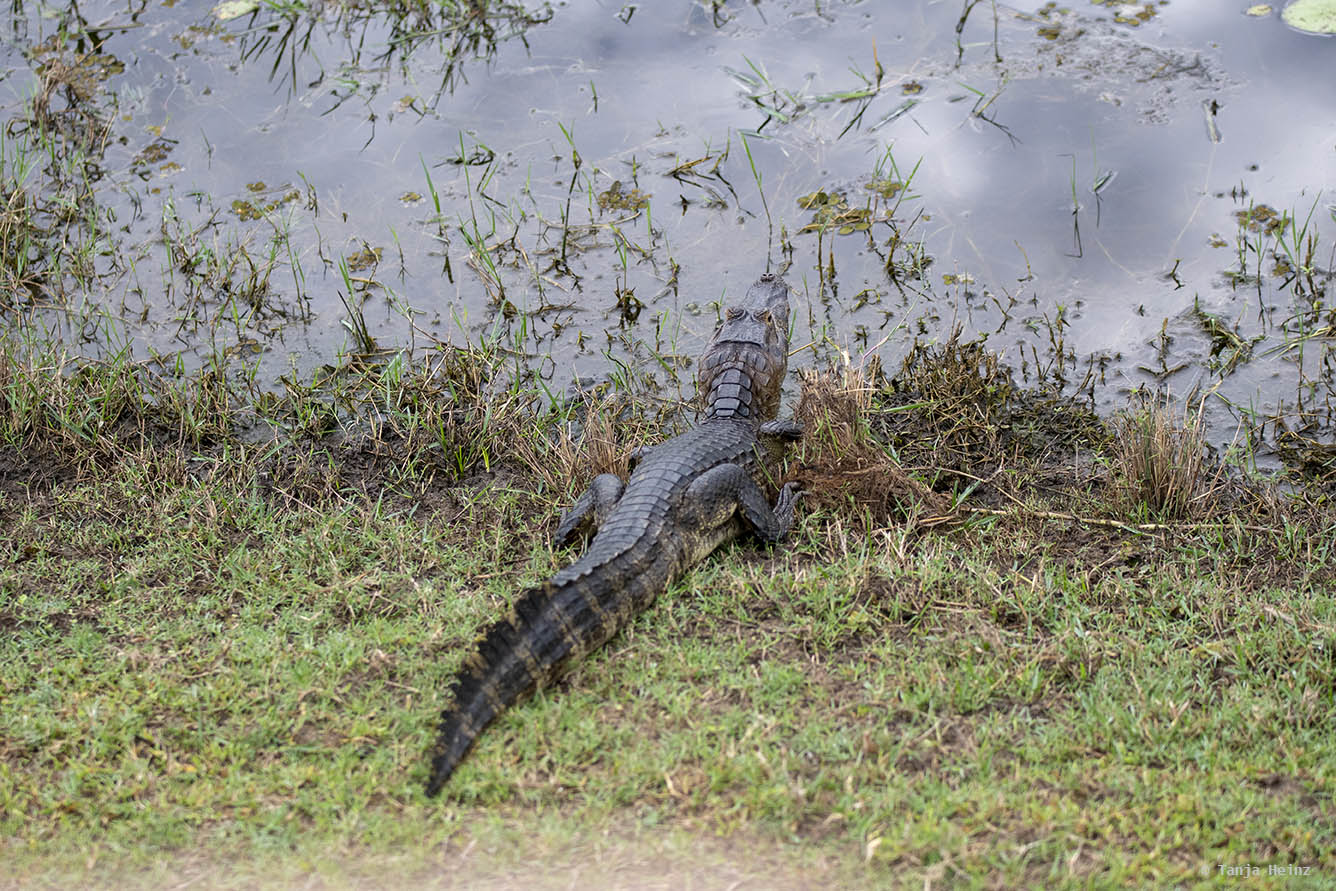
South American coati (Nasua nasua) Least concern
South American coatis are also very typical animals of central South America. They occur in several countries including Brazil. Their distribution, however, is wider when compared to Yacaré caimans, but according to the IUCN the population seems to be in decline. For me it was not the first time to spot South American coatis in the wild. I had seen them already at the Iguaçu Falls. In the Pantanal we saw them just for a few seconds. Therefore, this was a quite different South American coati encounter when compared to the one at the Iguaçu National Park.
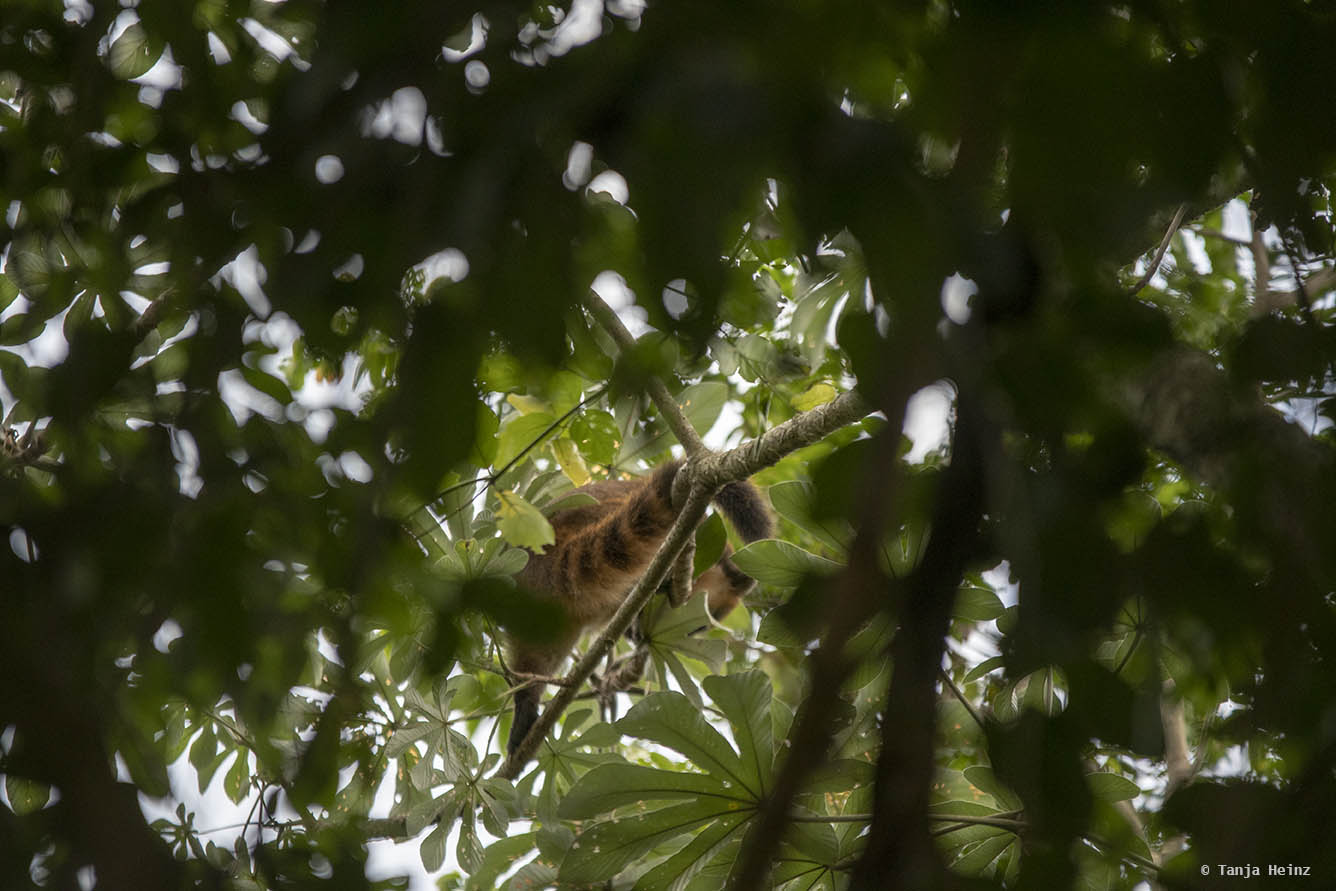
Crab-eating fox (Cerdocyon thous) Least concern
Another special animal encounter in the Pantanal in Brazil was the one with a crab-eating fox. Like the South American coatis, the Crab-eating fox was fleeing when it sensed our safari vehicle. Crab-eating foxes live in different habitats like forests, savannas, but also wetlands like the Pantanal. They are also endemic to South America and occur not only in Brazil, but also in neighboring countries. As the crab-eating fox was fleeing, I could observe only its back.
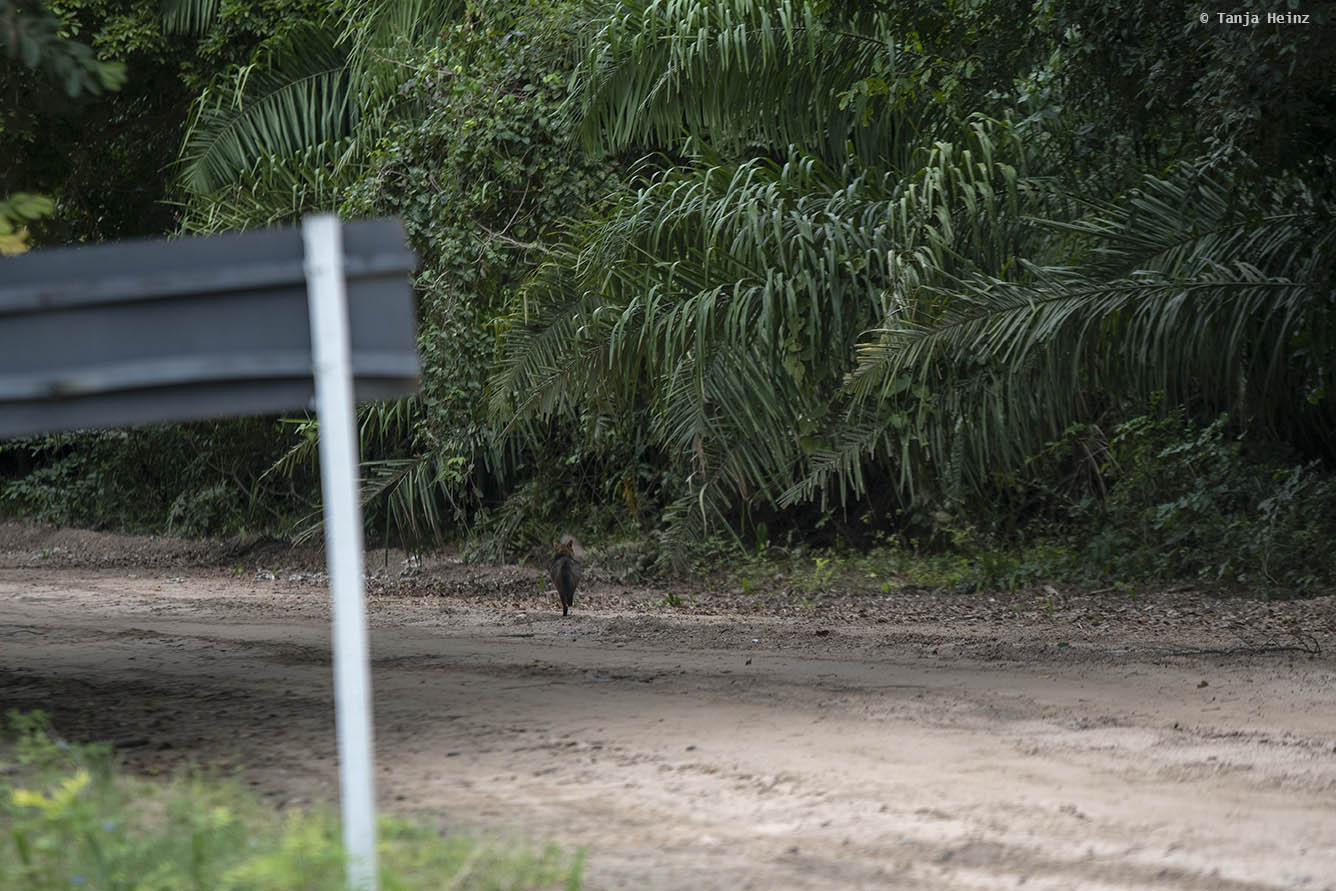
Black-and-gold howler monkey (Alouatta caraya) Least concern
As mentioned above we observed some black and gold howler monkeys on our walk through a forest in the Pantanal. Up in the tree they were making some noise. That means, only the male. They are named for their vocalizations which is very characteristic for this species and all other howler monkeys. Black-and-gold howler monkeys prefer forests and savannas. Although they are not in risk of extinction, their population seems to be in decline. One of their main threats is habitat loss.

Gray brocket (Mazama gouazoubira) Least concern
After one of our safaris by car we spotted a gray brocket close to the Fazenda São João. Gray brockets are also known as brown brockets and typically live in forests, savannas and wetlands like the Pantanal. Their distribution is restricted to central South America. They are not endangered, but their numbers are decreasing. Habitat loss is a common threat for many animal species including gray brockets.
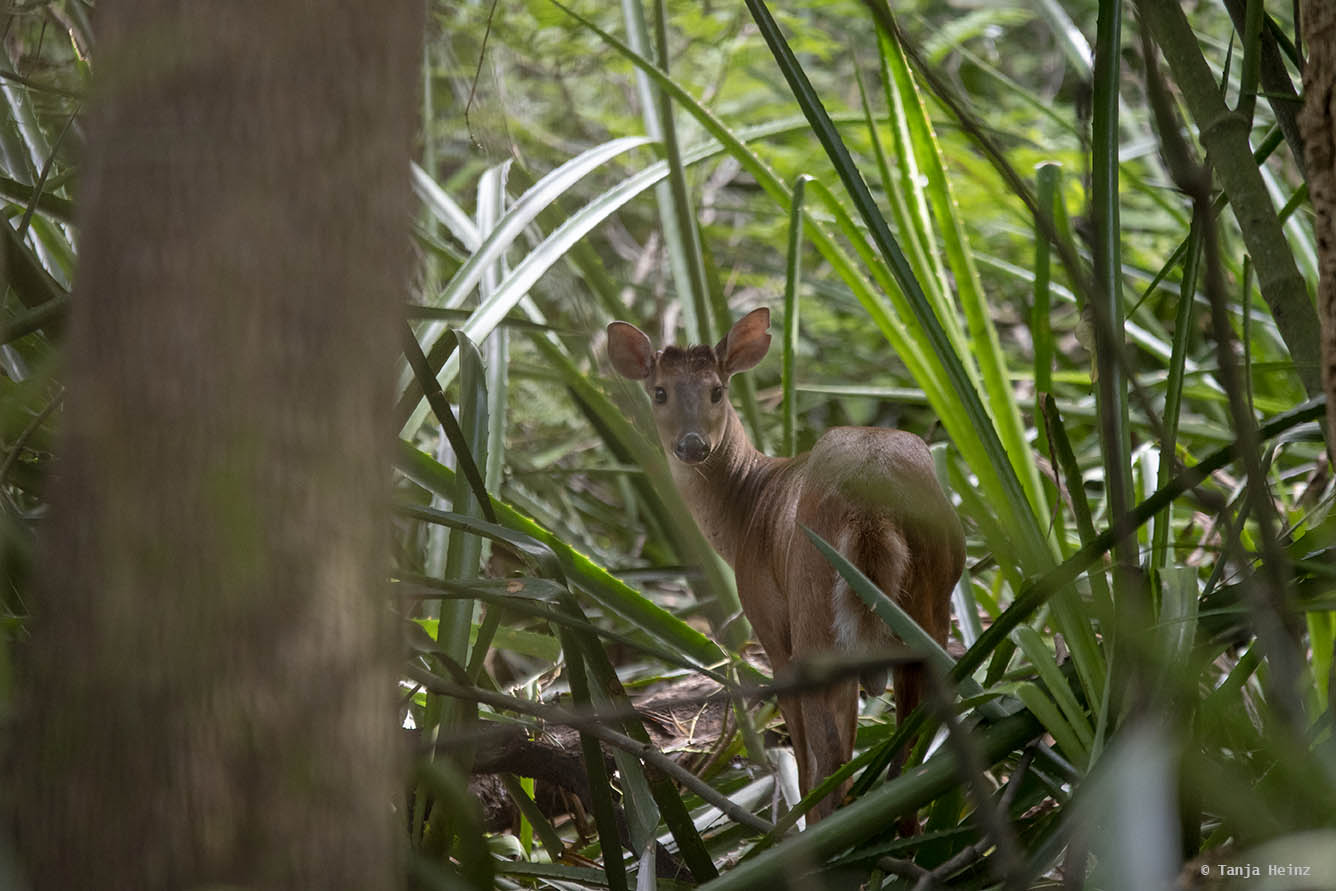
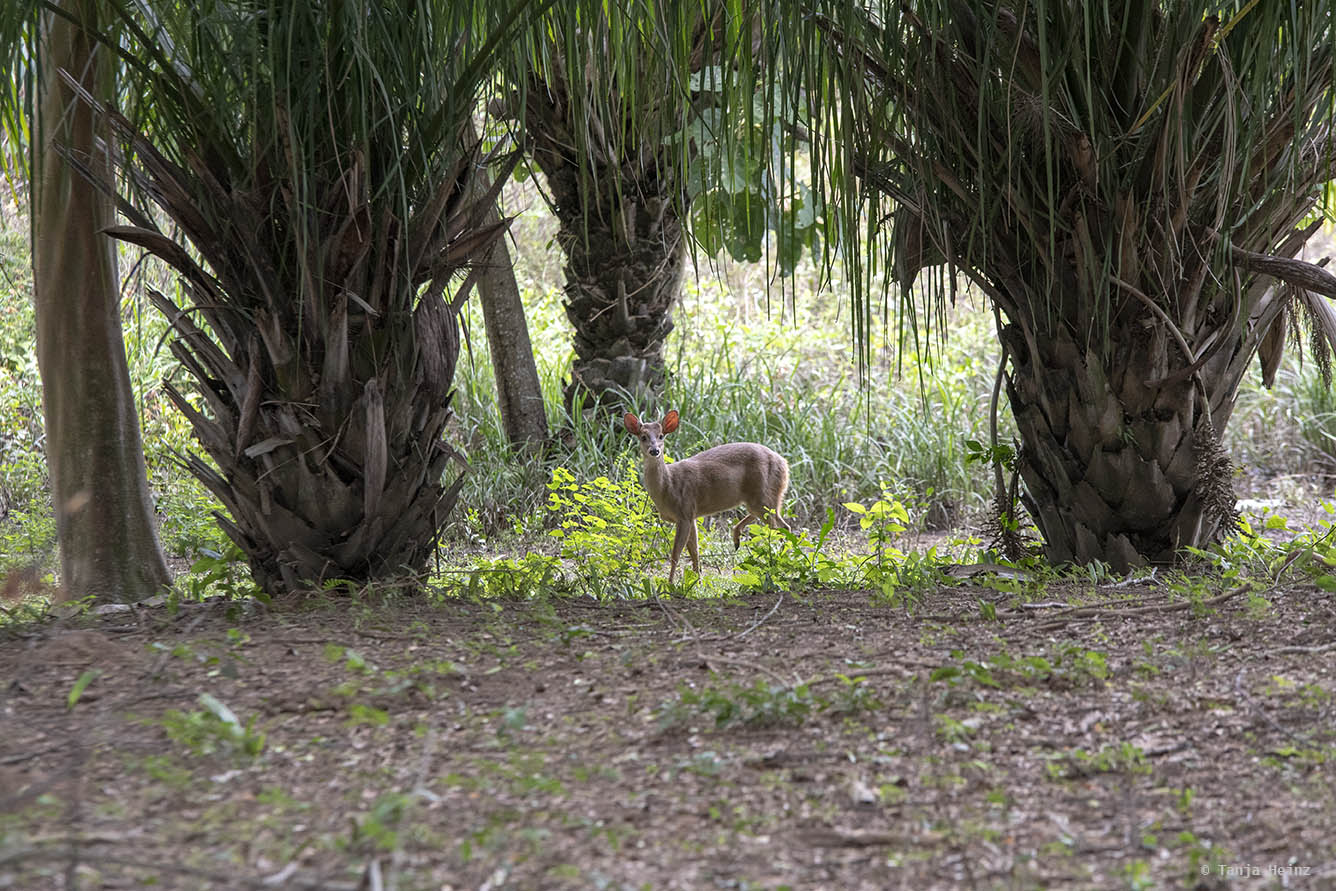
White-lipped peccary (Tayassu pecari) Vulnerable
White-lipped peccaries are pig-liked animals restricted to the Americas. They are “vulnerable” according to the IUCN and the population trend seems to indicate a decrease. They typically live in forests, grasslands and savannas. They were quietly grazing when we passed with our safari car. We observed them a minute and continued with the safari.
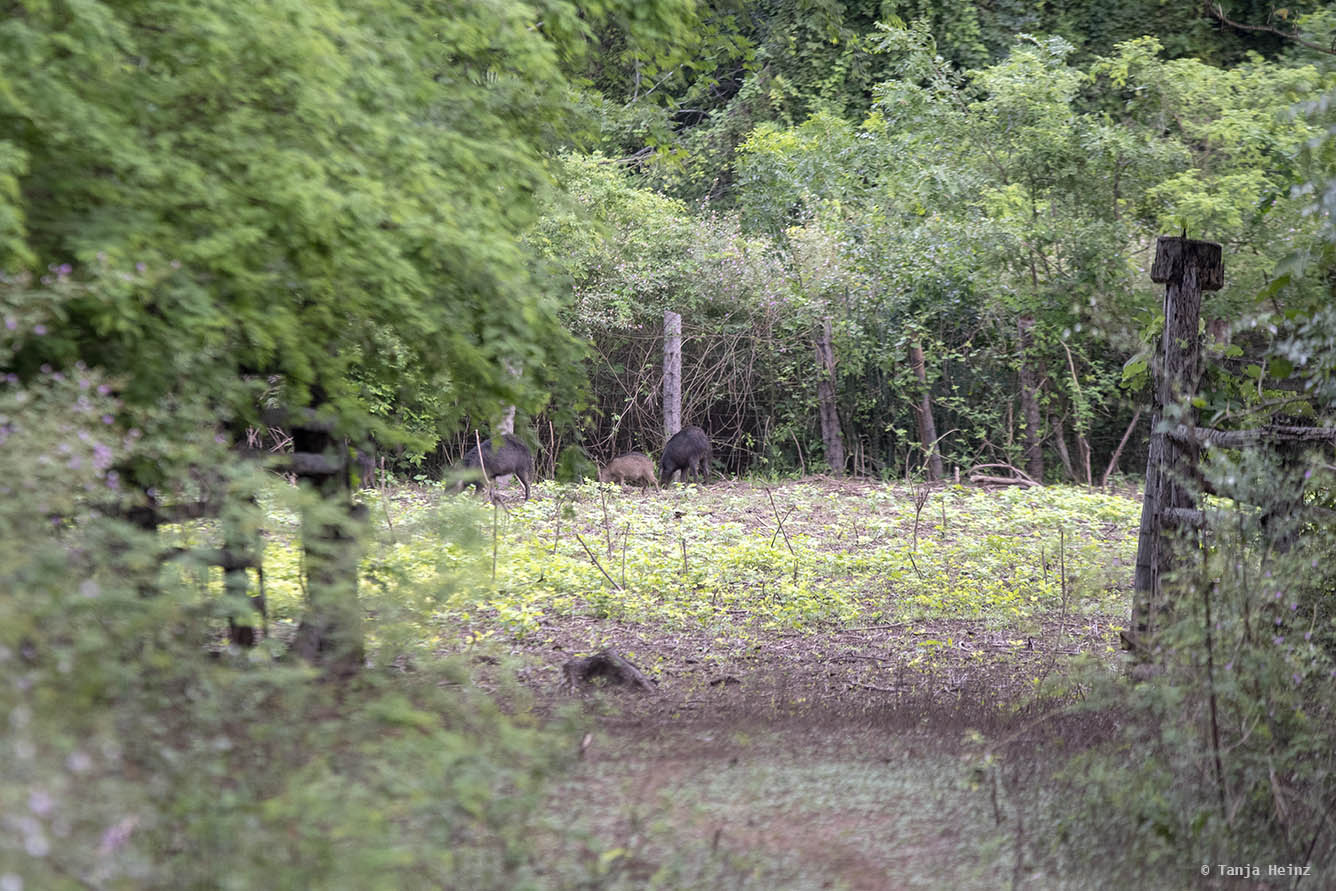
Wild boar (Sus scrofa) Least concern
Wild boars naturally occur in Europe and Asia, but they were introduced in many other parts of the world including Brazil. In some parts of the world they were very successful, as they are omnivorous and very adaptable to different environments. Thus, in some regions they even became a pest species. On our last day in the Pantanal we stopped at a small farm where some domesticated wild boars were living. They could roam about in an area without any fences. We observed a fight of two males. Although I grew up on a farm, it was the first time in my life that I observed two male pigs fighting.
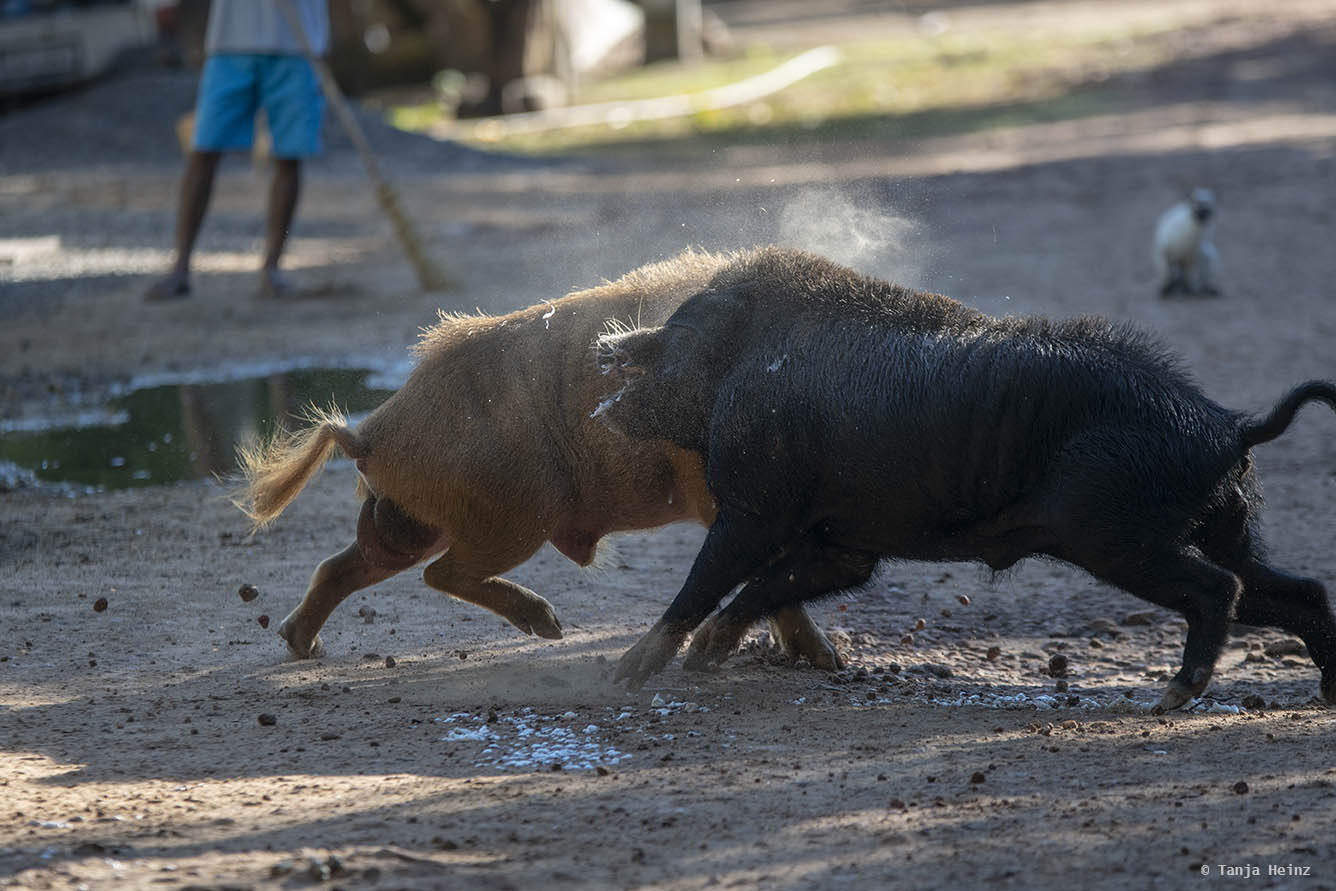
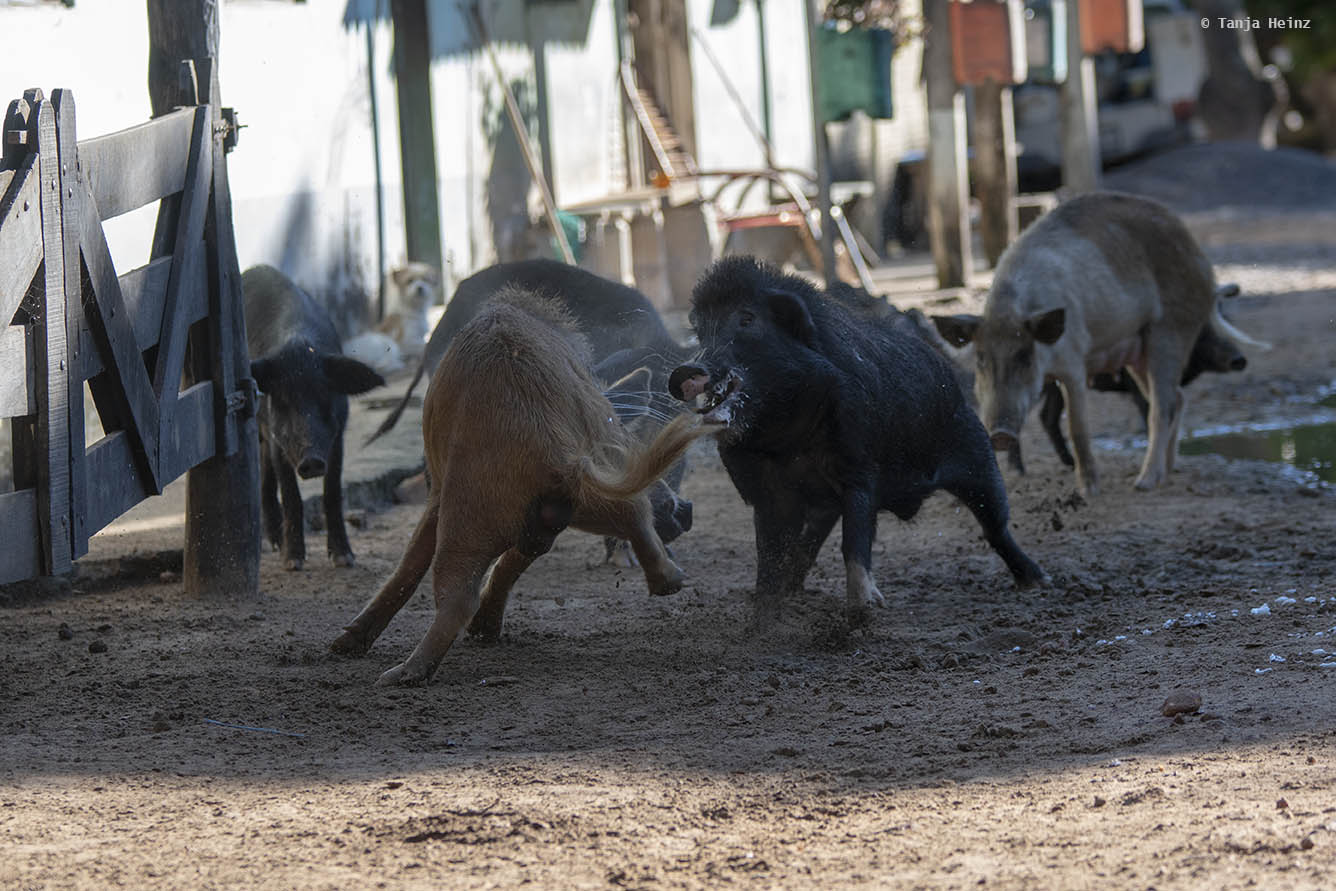
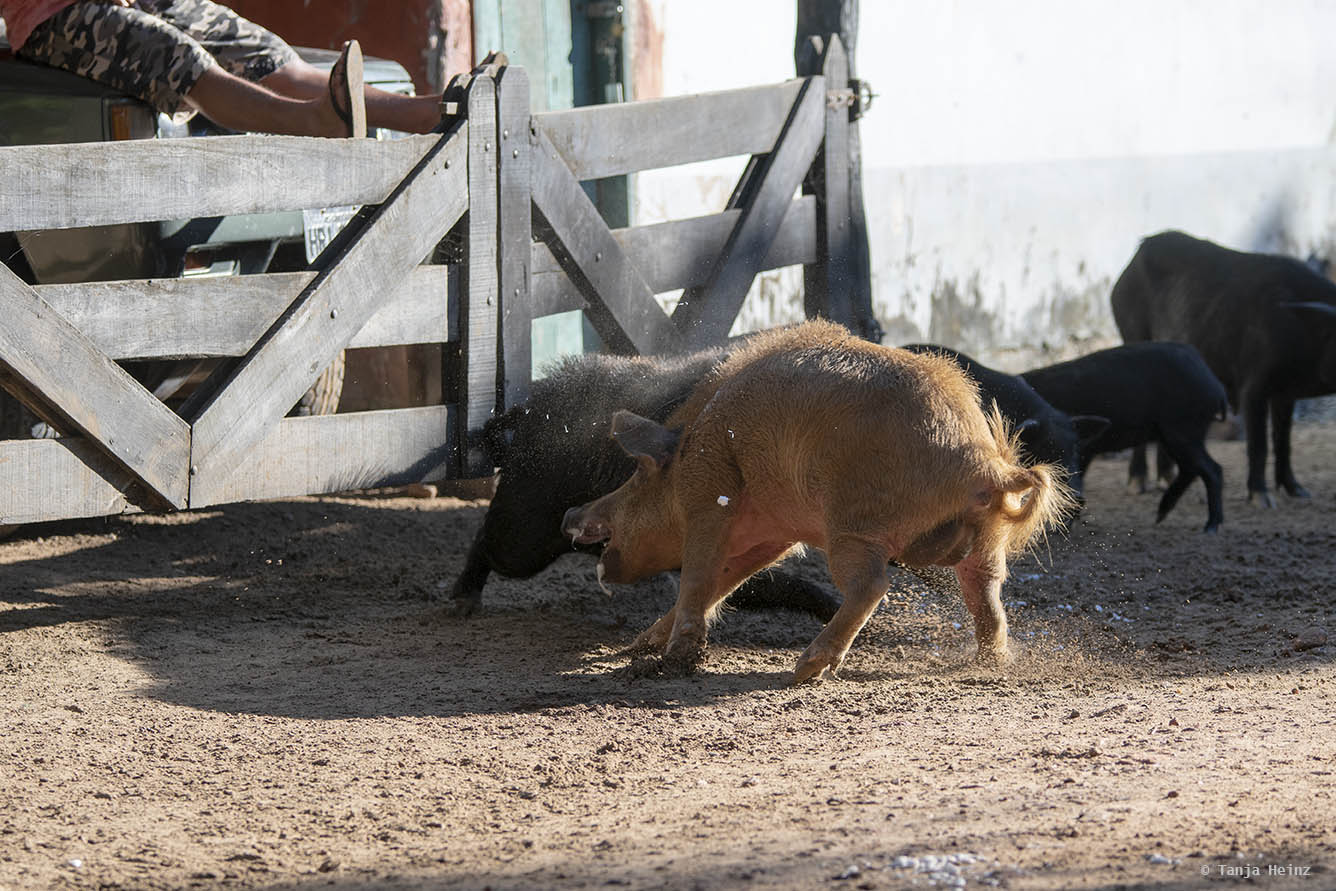

It was quite interesting observing the two of them. While they were fighting, the other wild boars around did not care much about it. After their fight everything seemed to be as usual. But who won?
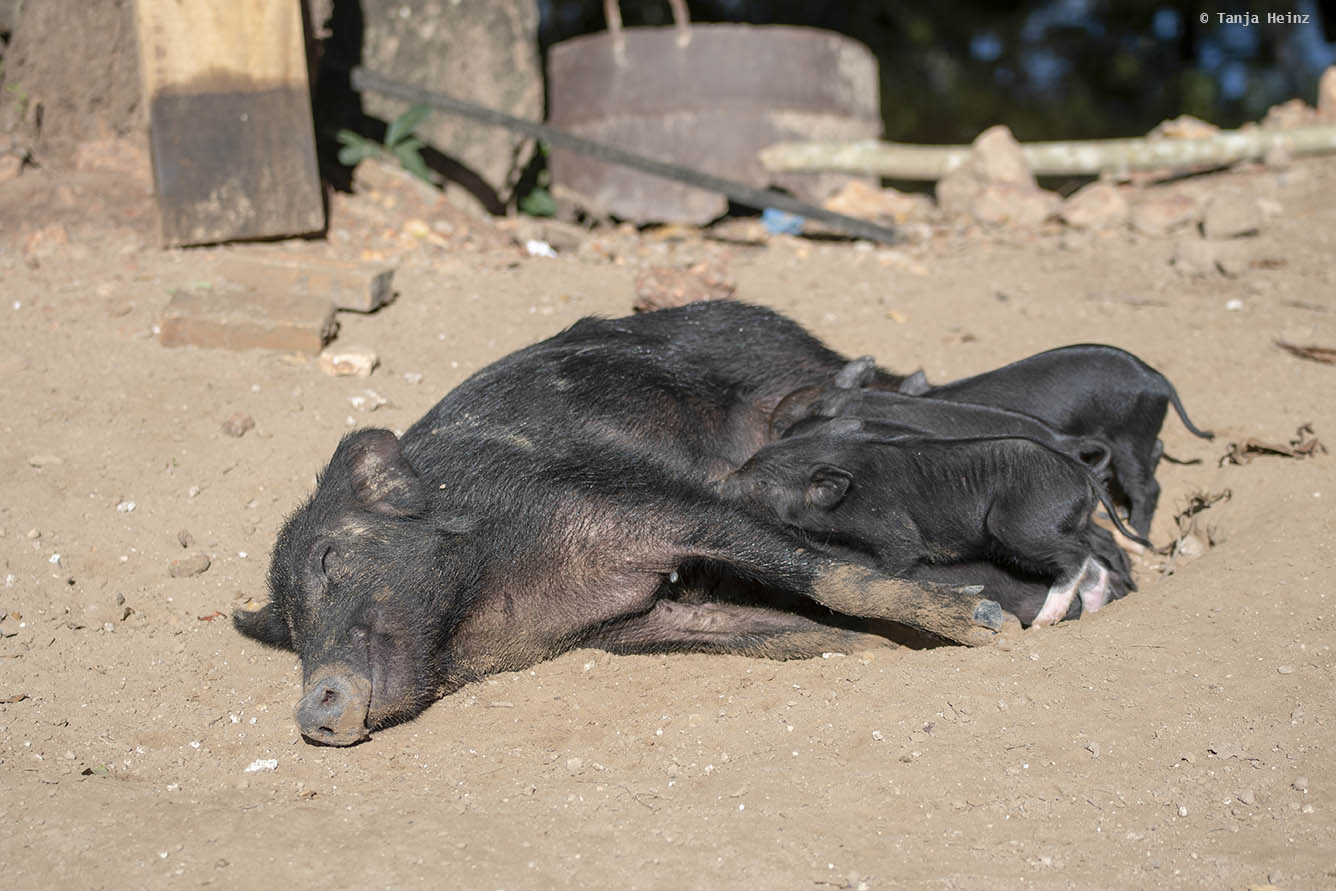
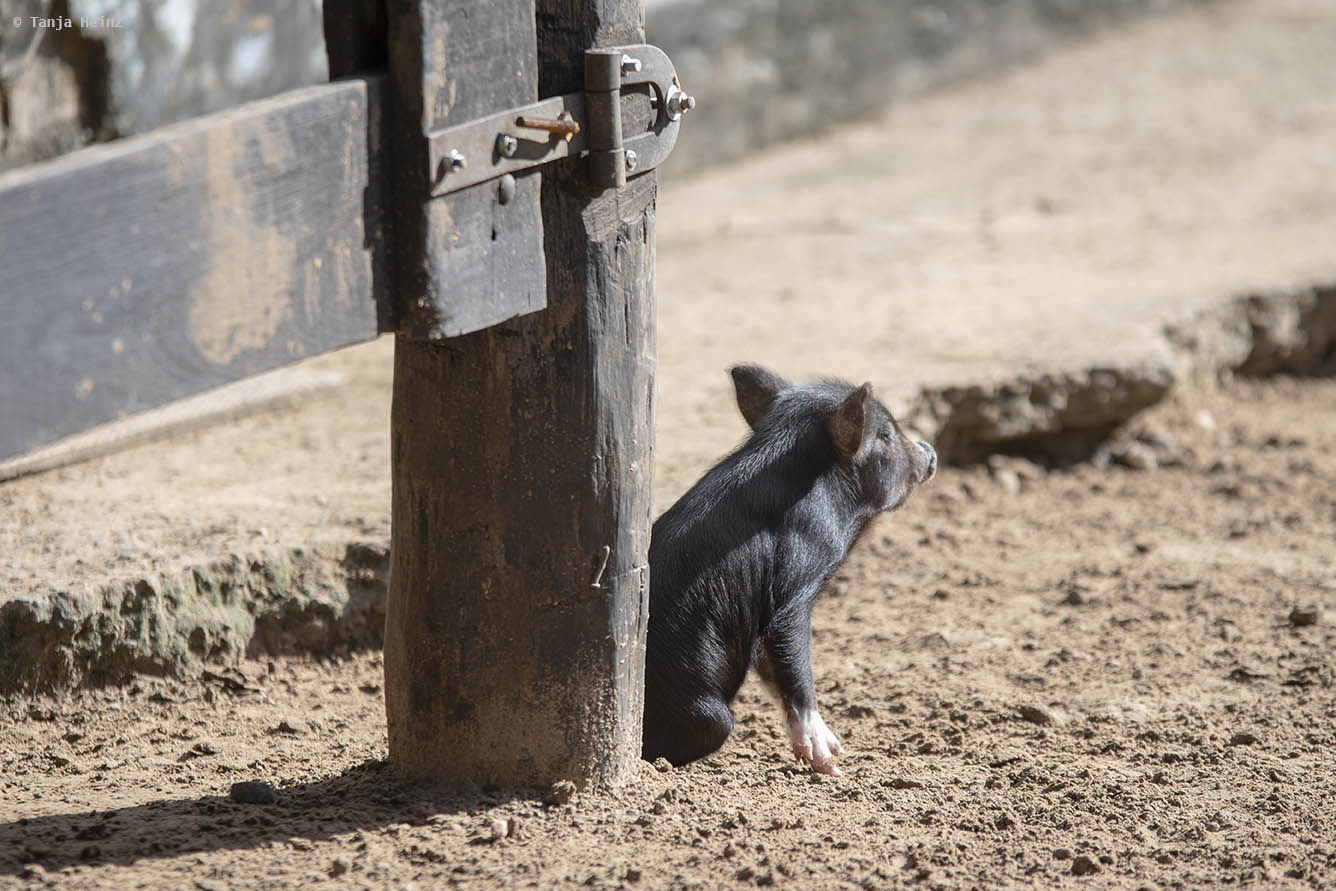
We stopped at this farm on our last day as there was a river close-by where “we” could fish. I personally do not like fishing at all. It was kind of contradictory for me. On one side we wanted to observe wild animals and on the other side we should take fishes out of the river to eat. But this is another topic… However, most tour participants joined the fishing activity. I did not join, and luckily, three more of us, neither.
Capybara (Hydrochoerus hydrochaeris) Least concern
In general we saw many different animals on our tour. Of course, due to the season and as you need luck to spot wildlife, the probability to see all typical animals of the Pantanal is not that high in April like in other months. Luckily, on our journey back to another Fazenda, where a taxi driver was waiting for us to bring us back to Campo Grande, we spotted some capybaras on the side of the road. Of course, I was so happy to see them. But according to their behavior, we definitely disturbed them. When they saw the safari car full of people, the capybaras stood up and left their resting place. The car stopped for a minute, but finally we left them alone again.
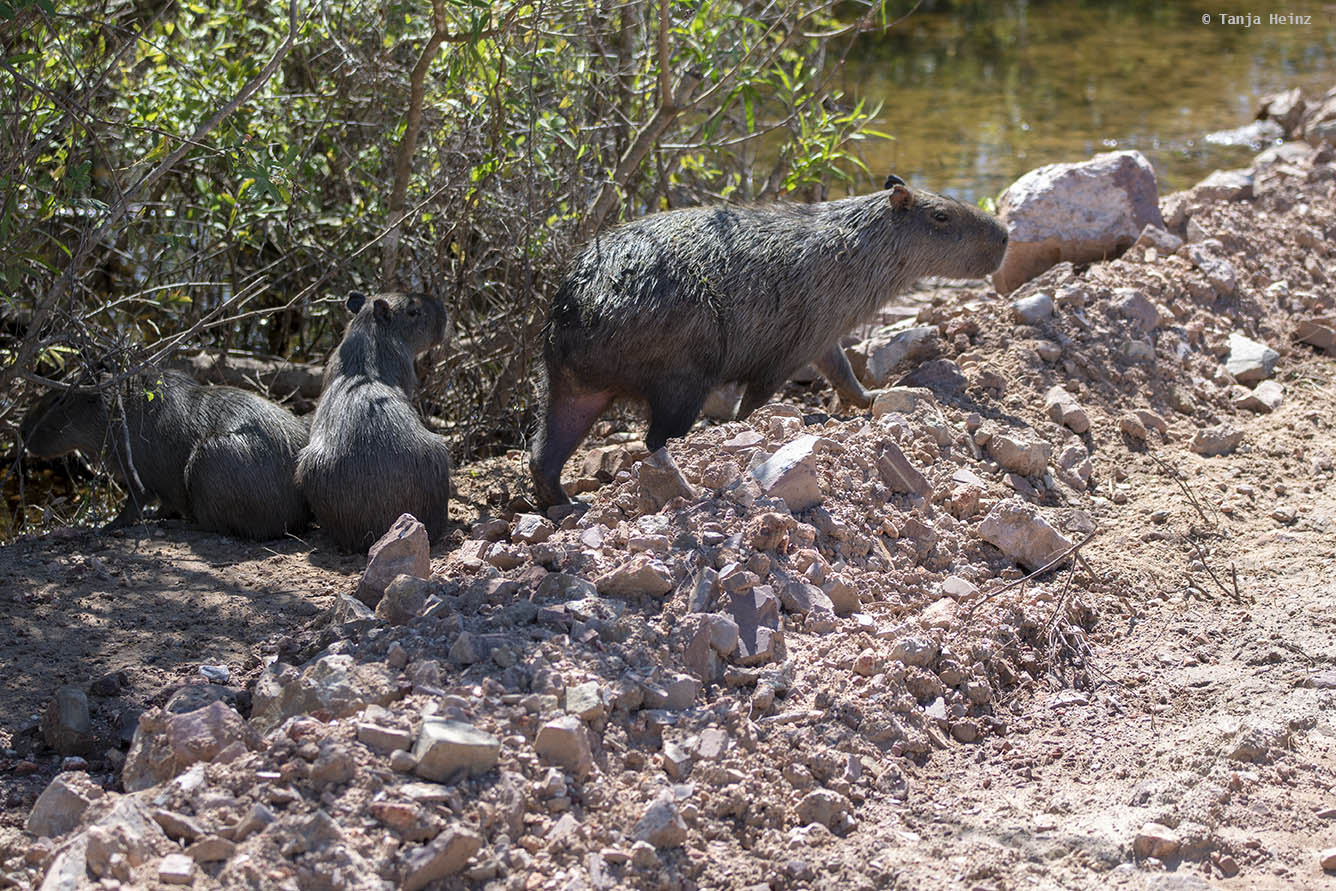
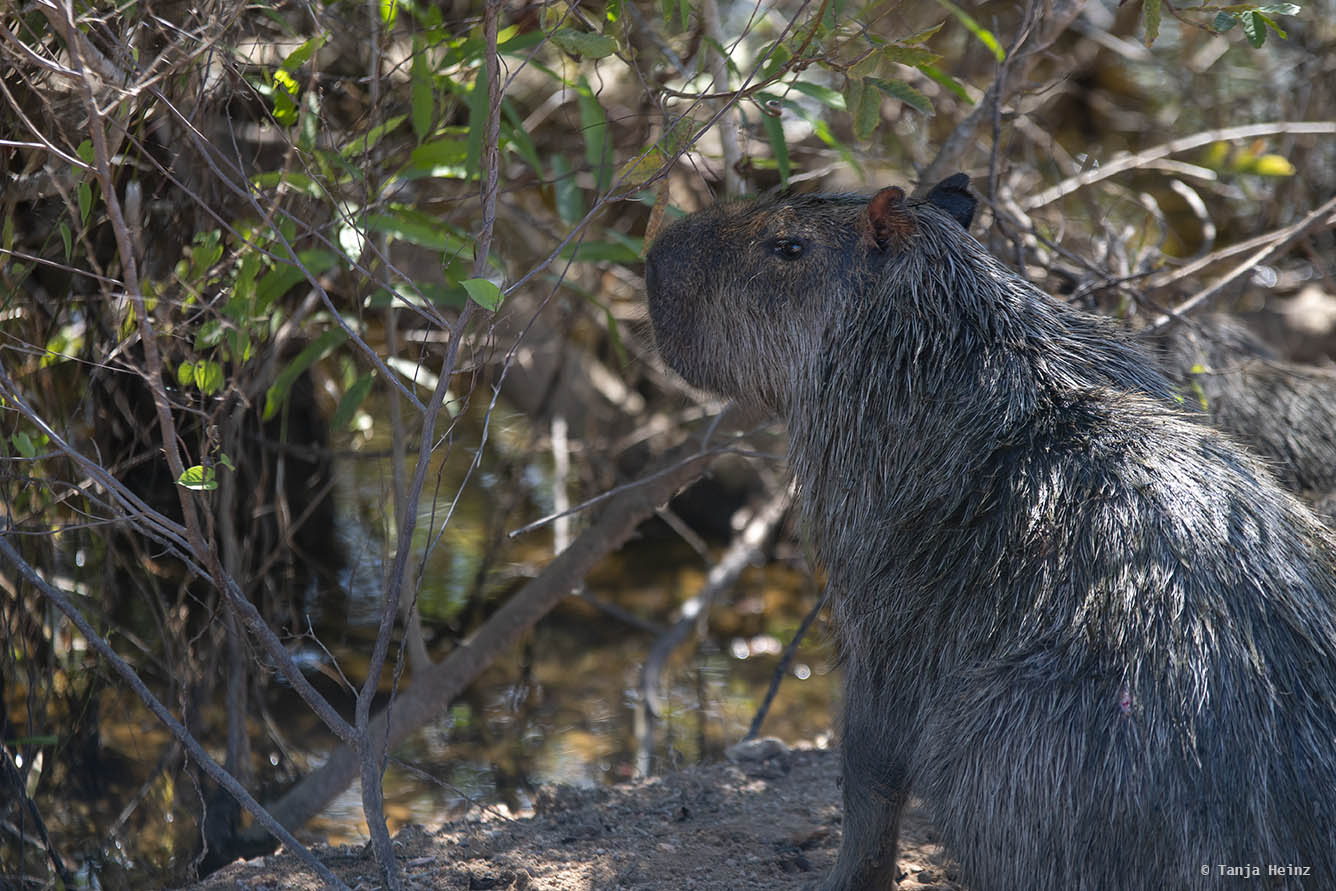
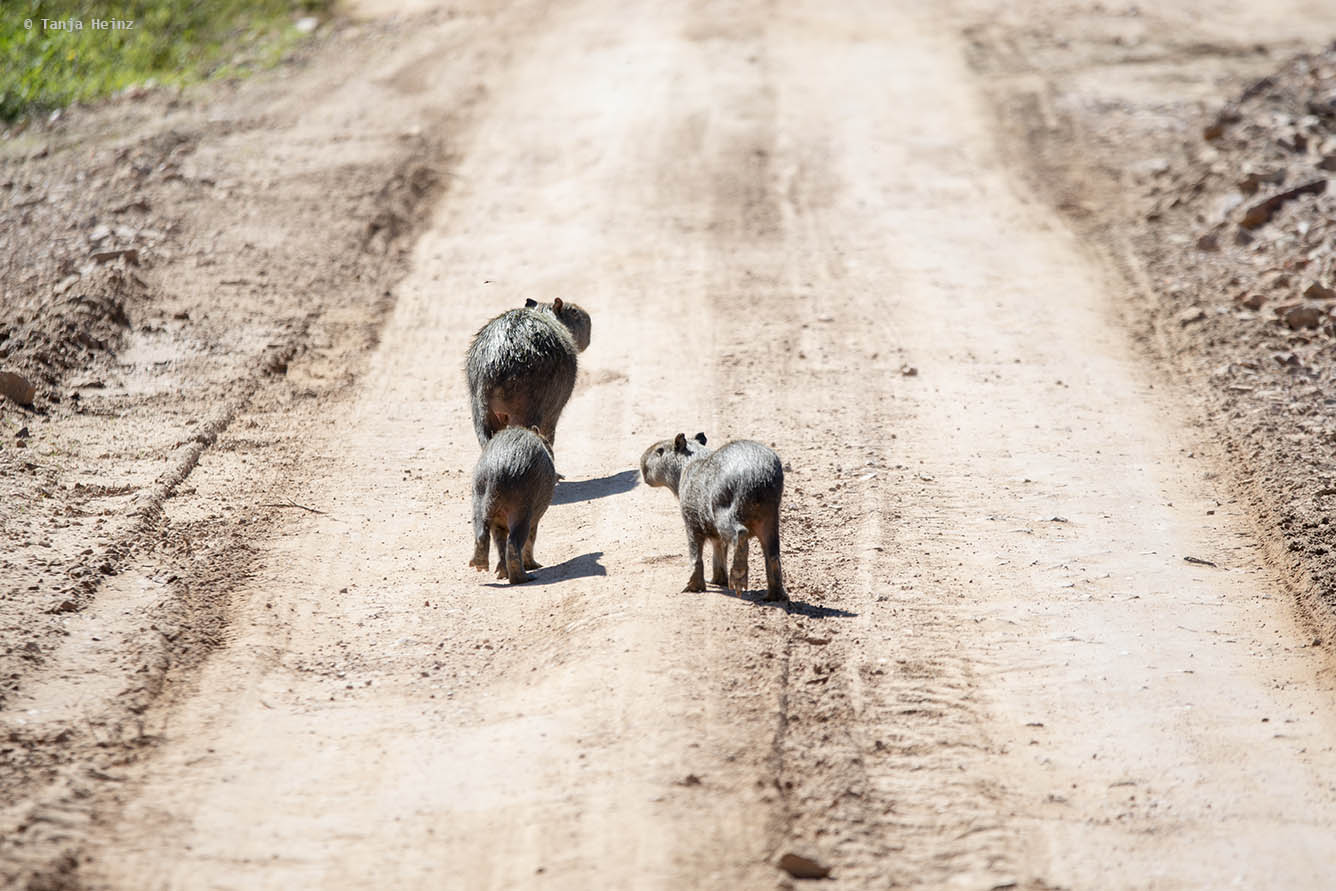
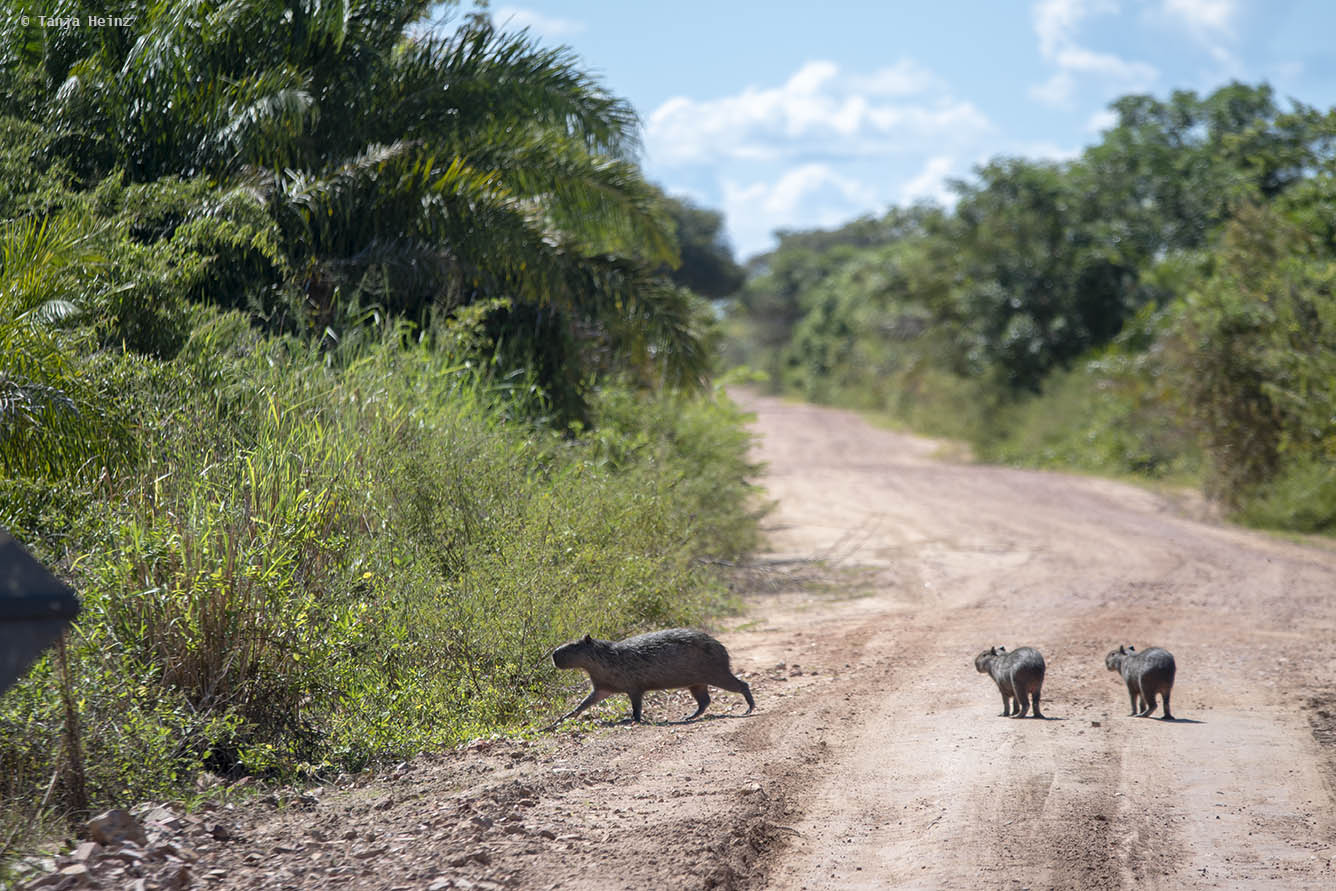
Birdlife in the Pantanal
Compared to mammals, we definitely spotted more different bird species in the Pantanal in Brazil. We observed some birds several times, like for example ringed kingfishers, toco toucans or cattle tyrants. Just to name a few. In this paragraph I will present all bird species we saw on our tour in the Pantanal.
Kingfishers (Alcedinidae)
Although we met several times kingfishers, in total, we observed only two species. On one hand we spotted Amazon kingfishers (Chloroceryle amazona), and on the other hand ringed kingfishers (Megaceryle torquata). In one occasion, we even saw both species perching on the same branch of a tree (left: Amazon kingfischer, right: ringed kingfisher). Both Amazon kingfishers and ringed kingfishers are of “least concern” according to the IUCN. The population of ringed kingfishers is apparently even increasing.
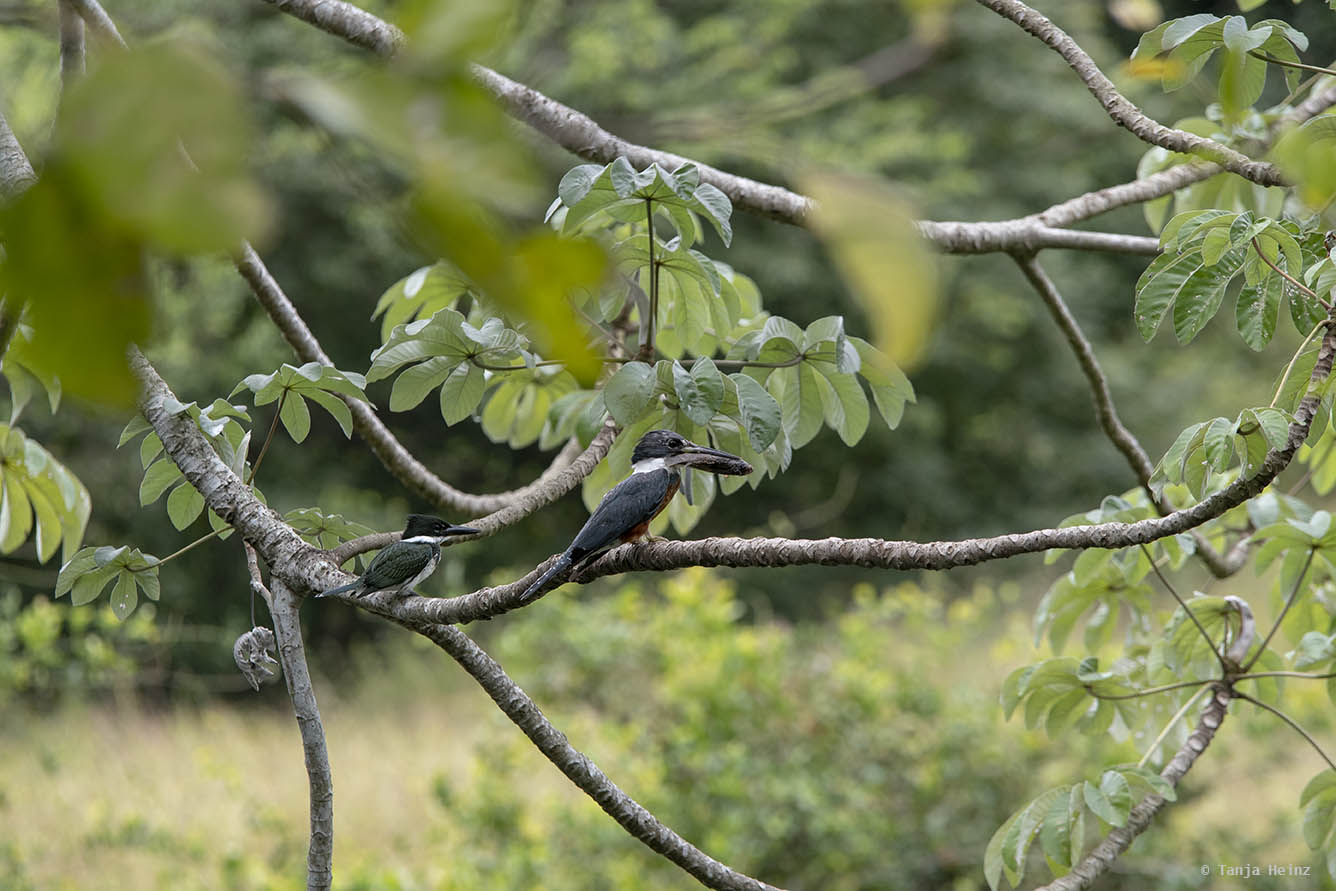
True parrots (Psittacidae)
One bird species I really wished to see was the hyacinth macaw (Anodorhynchus hyacinthinus). As you can see on the following birds, I was lucky. With its blue feathers and its yellow rings around its eyes, the parrot is easy to identify. According to our tour guide, hyacinth macaws are very abundant. However, according to the IUCN these parrots are “vulnerable“ (the next category is “endangered”) and the populations seem to be in decline. One major threat is illegal trade.
Anyway, on one morning I left the breakfast area early to explore the surroundings of the Fazenda on my own. I saw some hyacinth macaws close to the Fazenda. I could quietly observe them at their feeding area, although some of them preferred to stay in the trees.
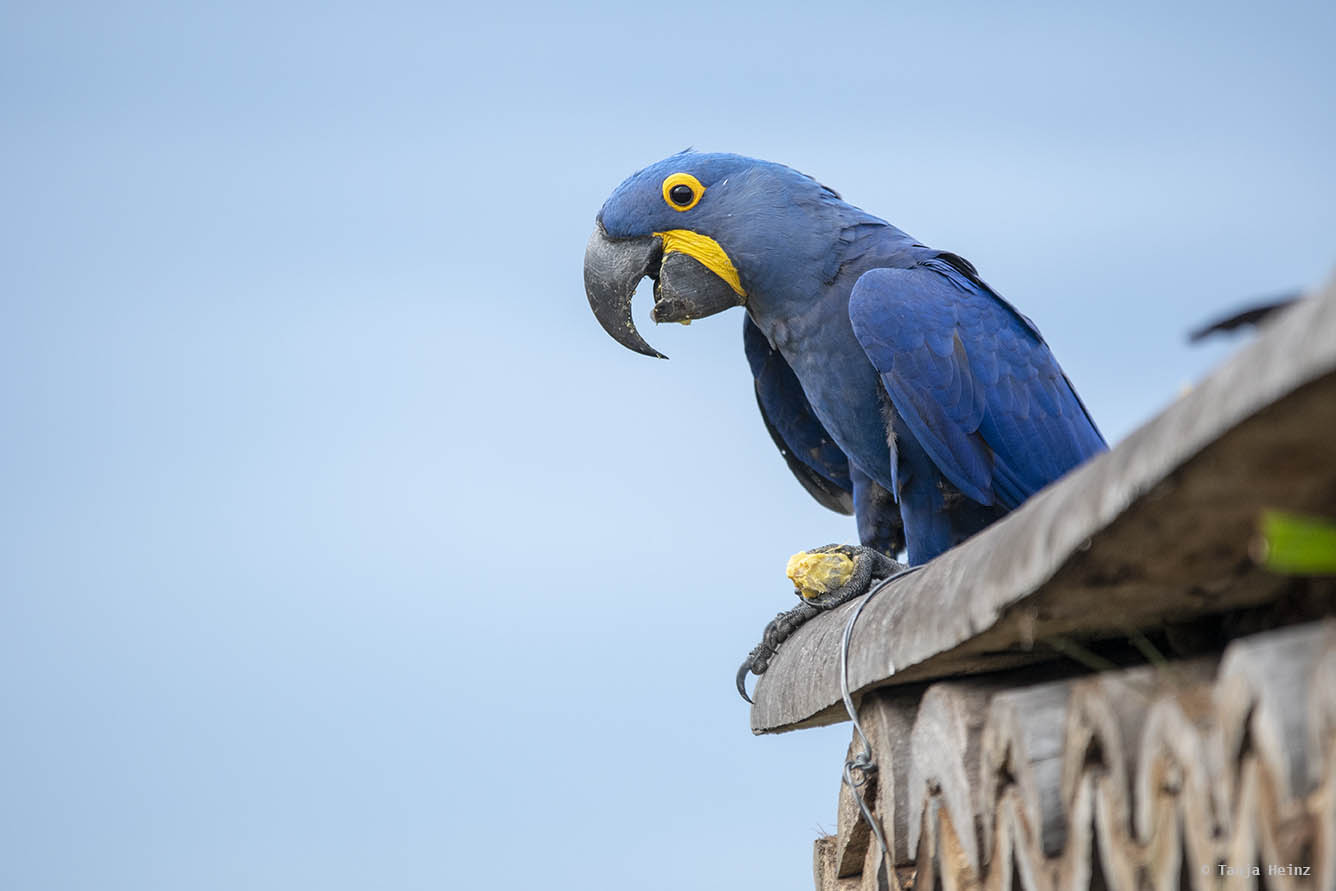
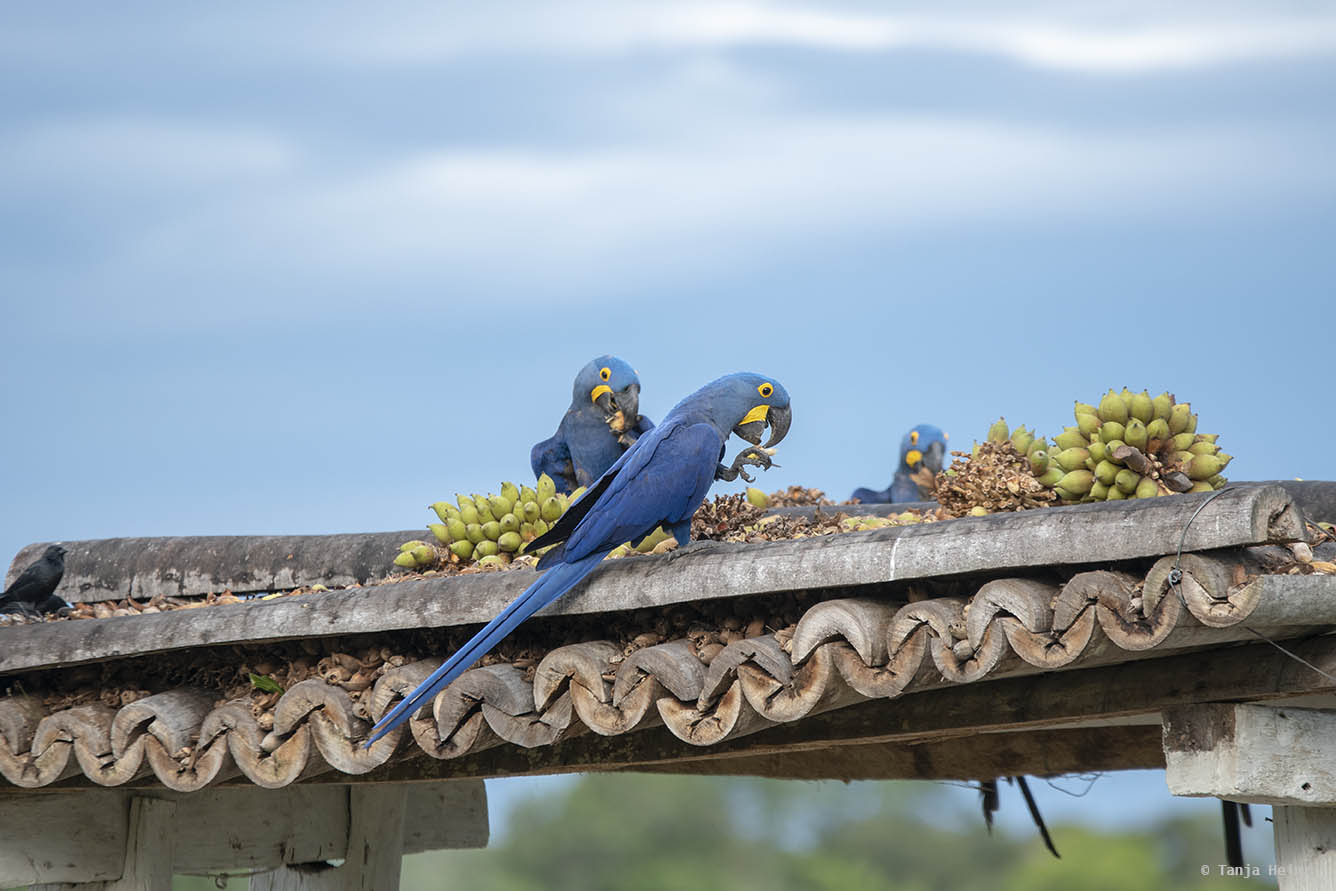
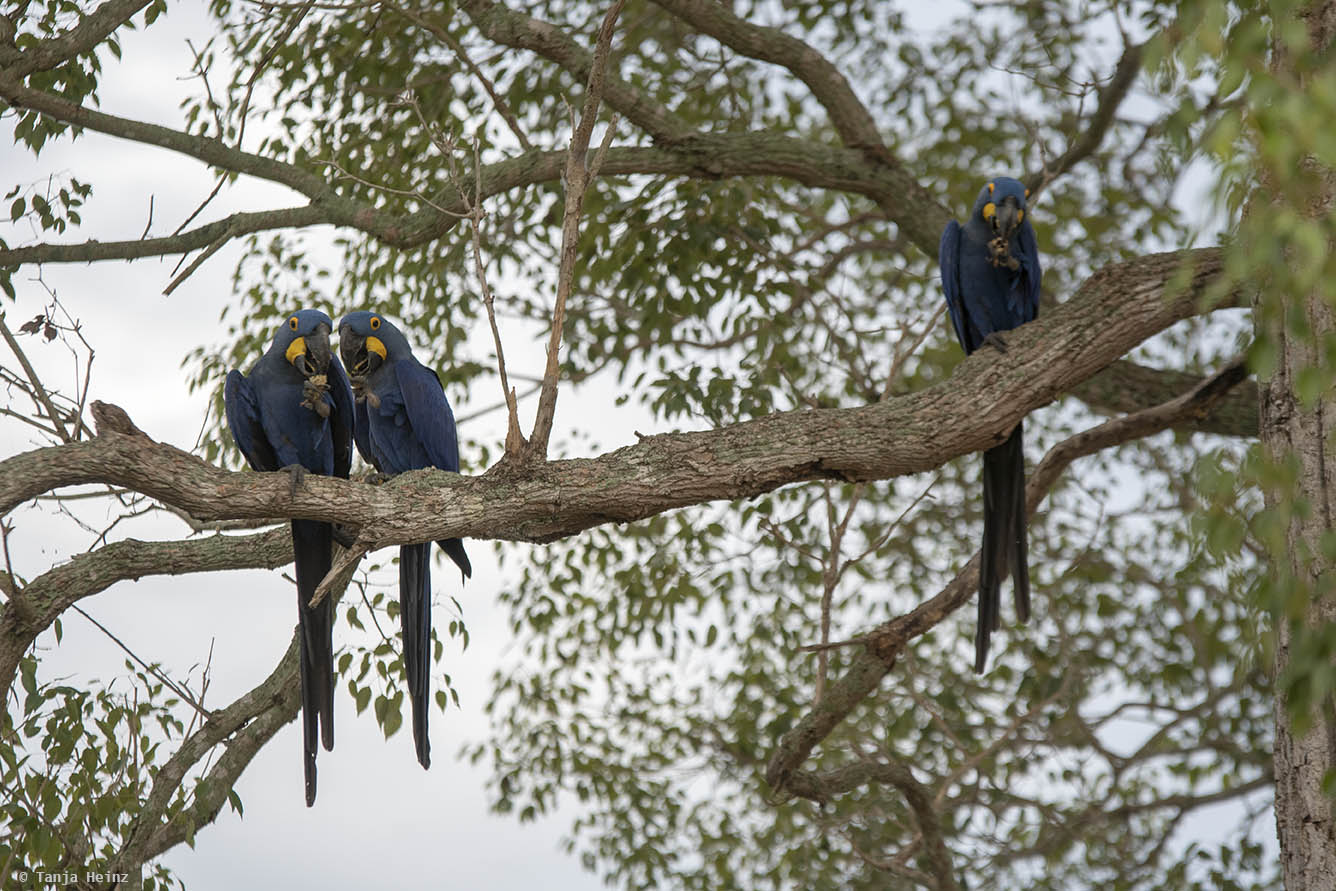
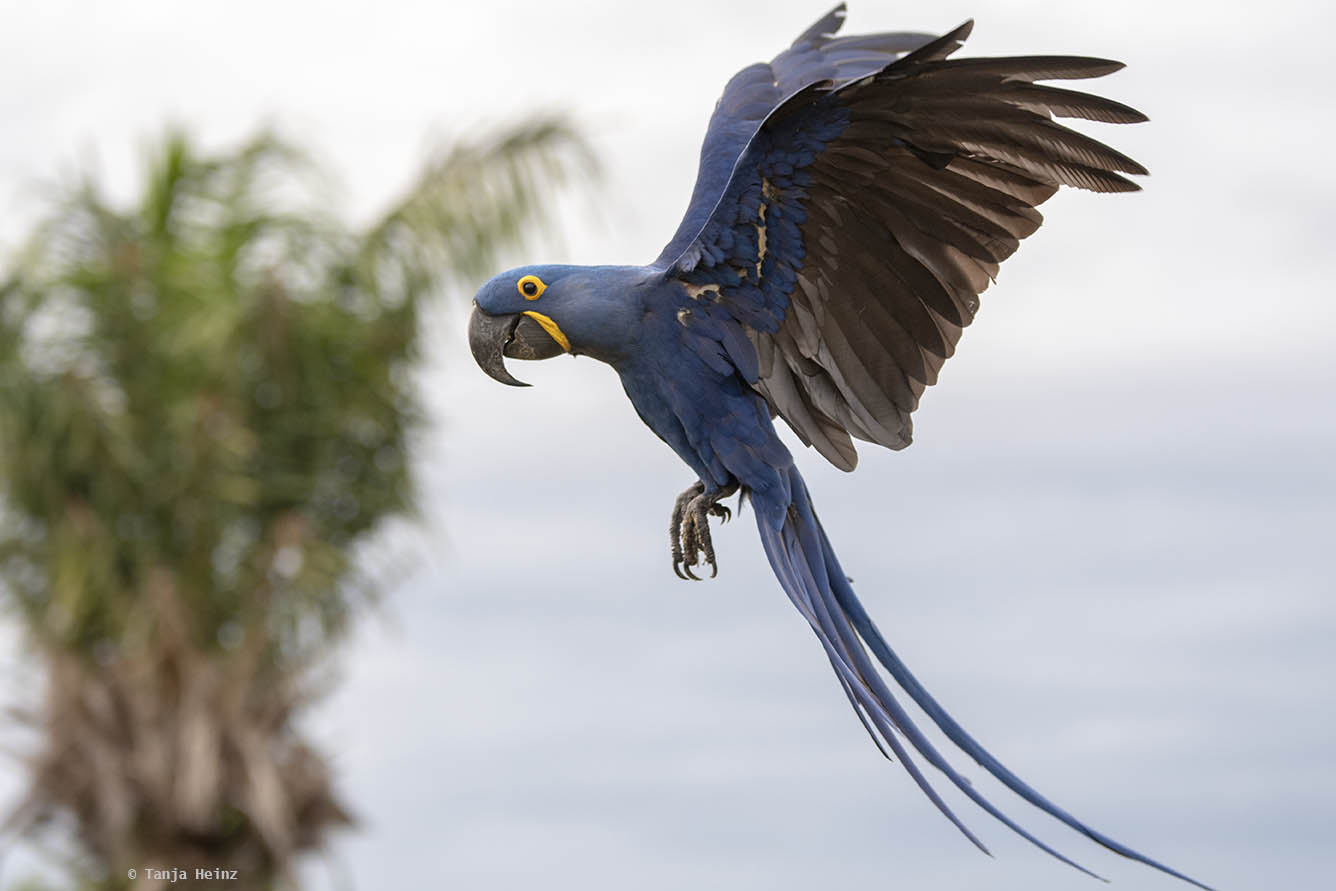
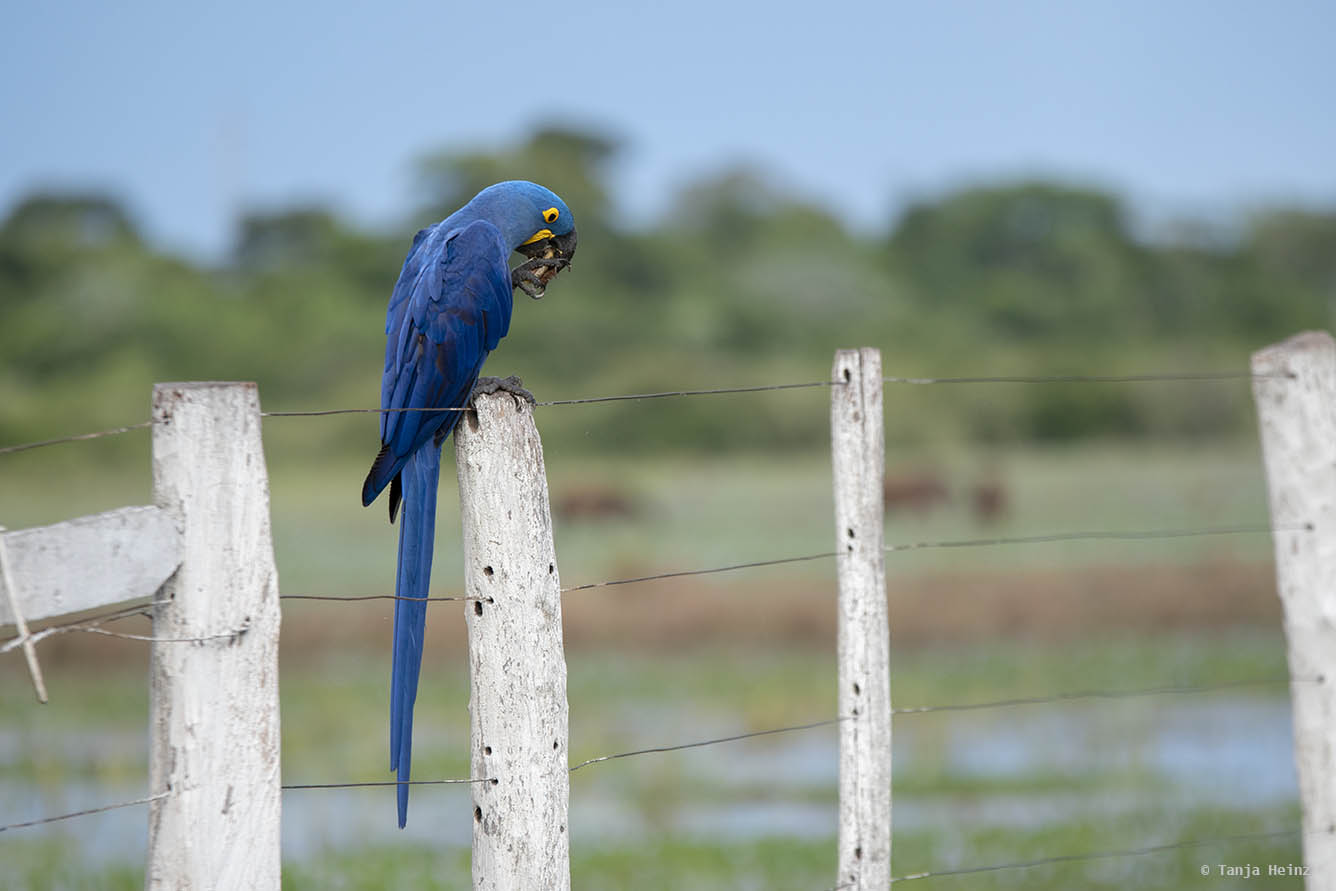
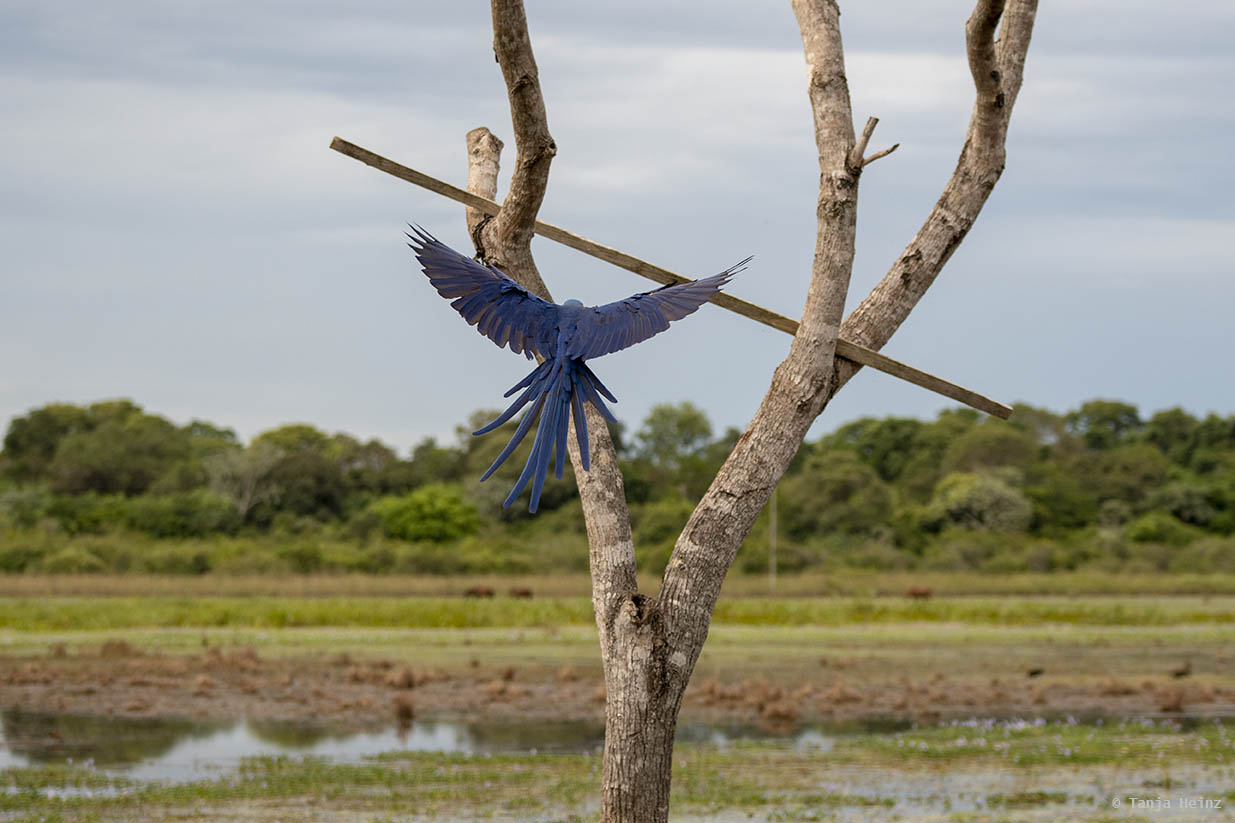
Close to our accommodation on the Fazenda we could also observe every day various couples of monk parakeets (Myiopsitta monachus). It was a pleasure for me to observe these wonderful parrots. In contrast to hyacinth macaws, monk parakeets are apparently indeed abundant as they are listed as “least concern” according to the IUCN and their populations seem to be further growing. Around the Fazenda we observed numerous couples building on their nests. By the way, the monk parakeets and the hyacinth macaws were the only two parrots we observed on our tour.
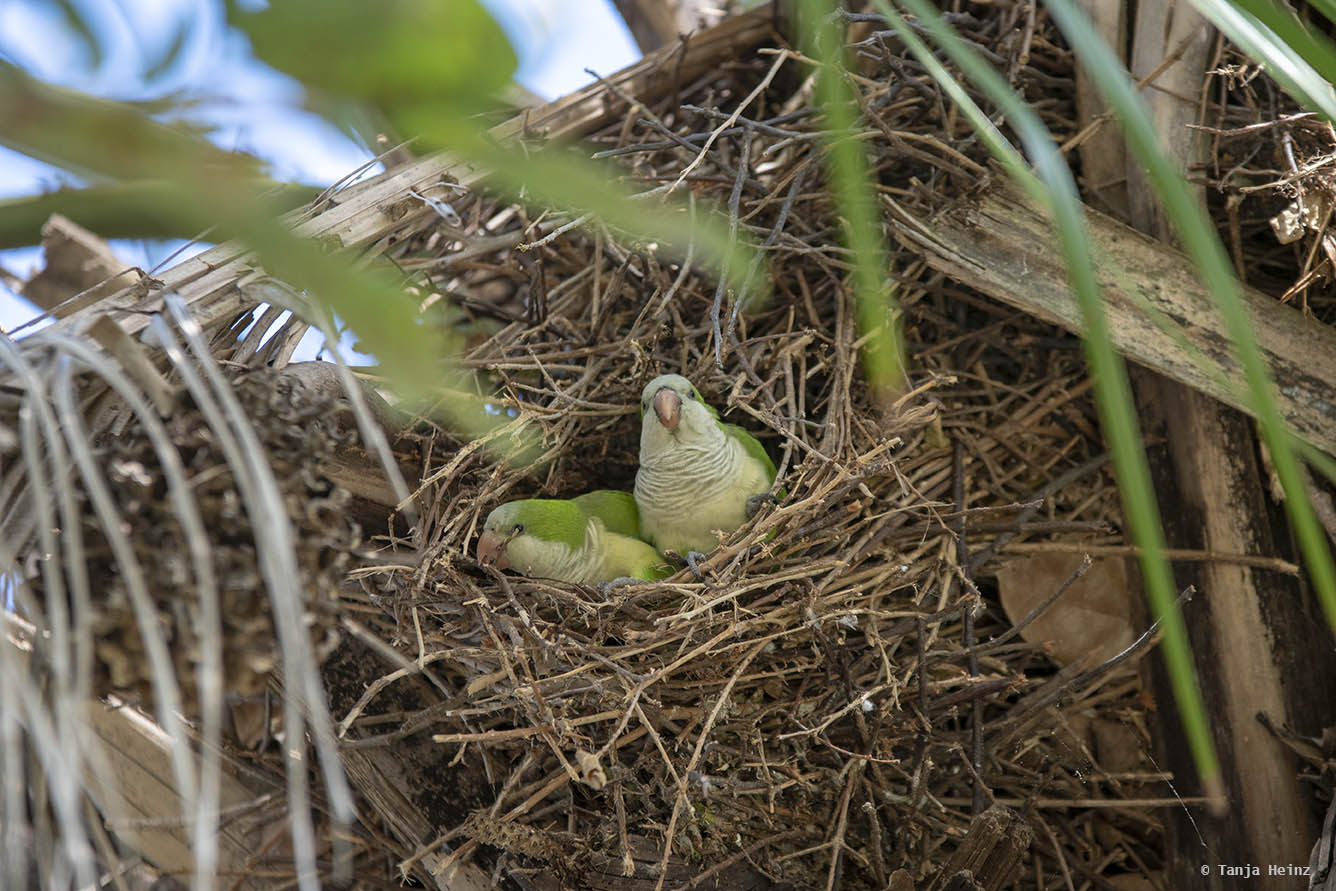

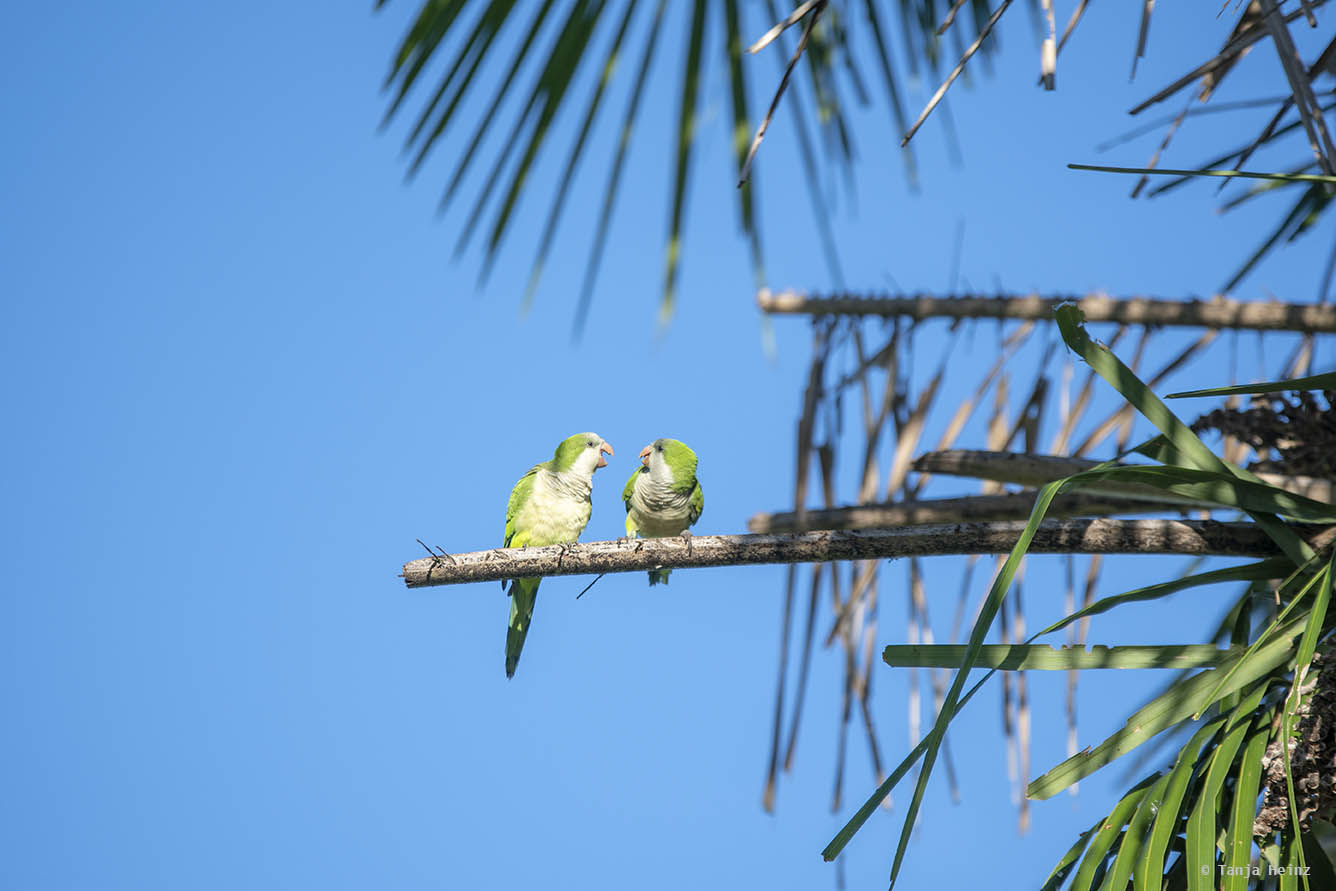
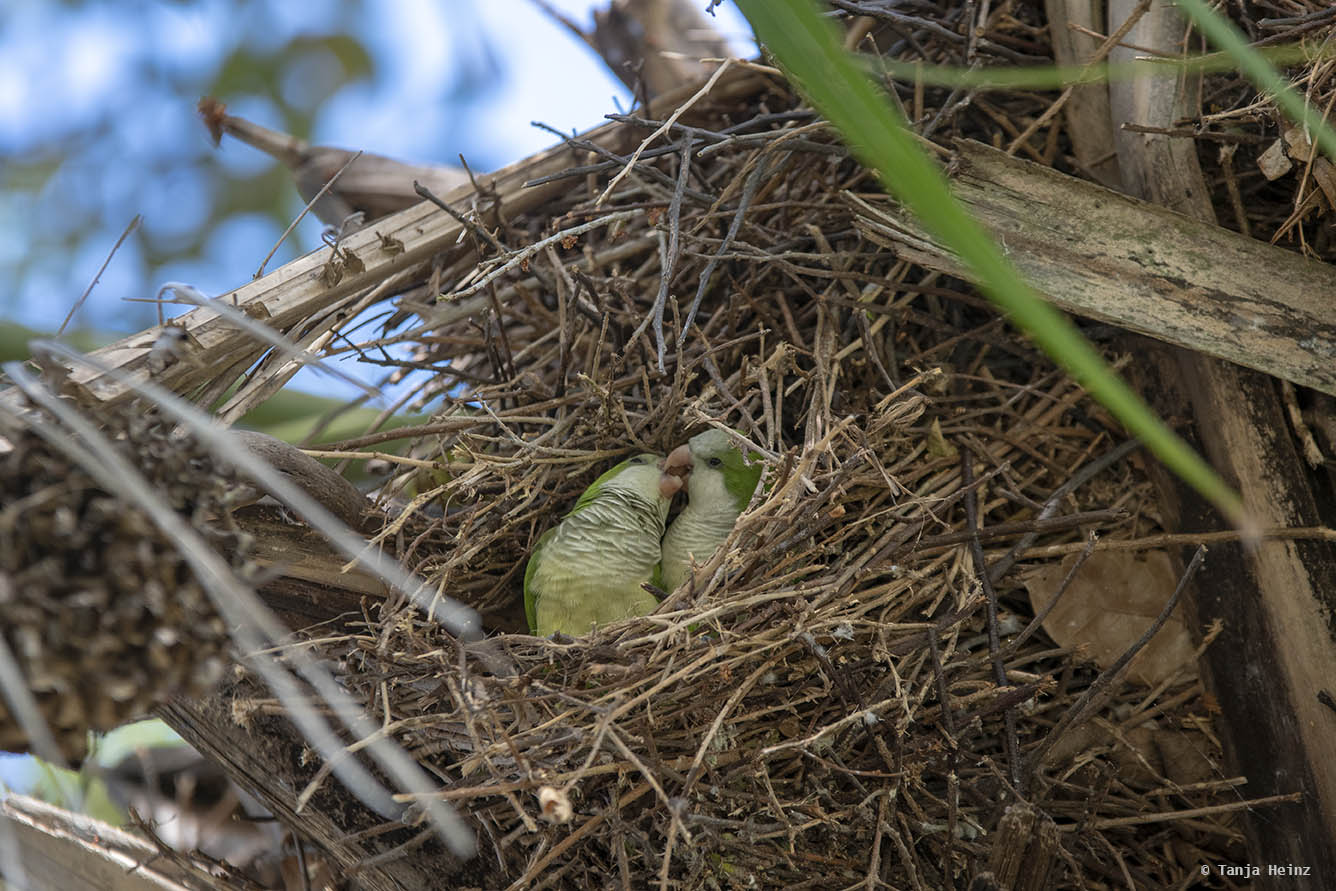
Antbirds (Thamnophilidae)
Although antbirds are very diverse and there are more than 200 different species of them distributed across Central and South America, I observed only one antbird in the Pantanal. To be more precisely, we observed a barred antshrike (Thamnophilus doliatus). They occur in northern South America, but also in Central America.
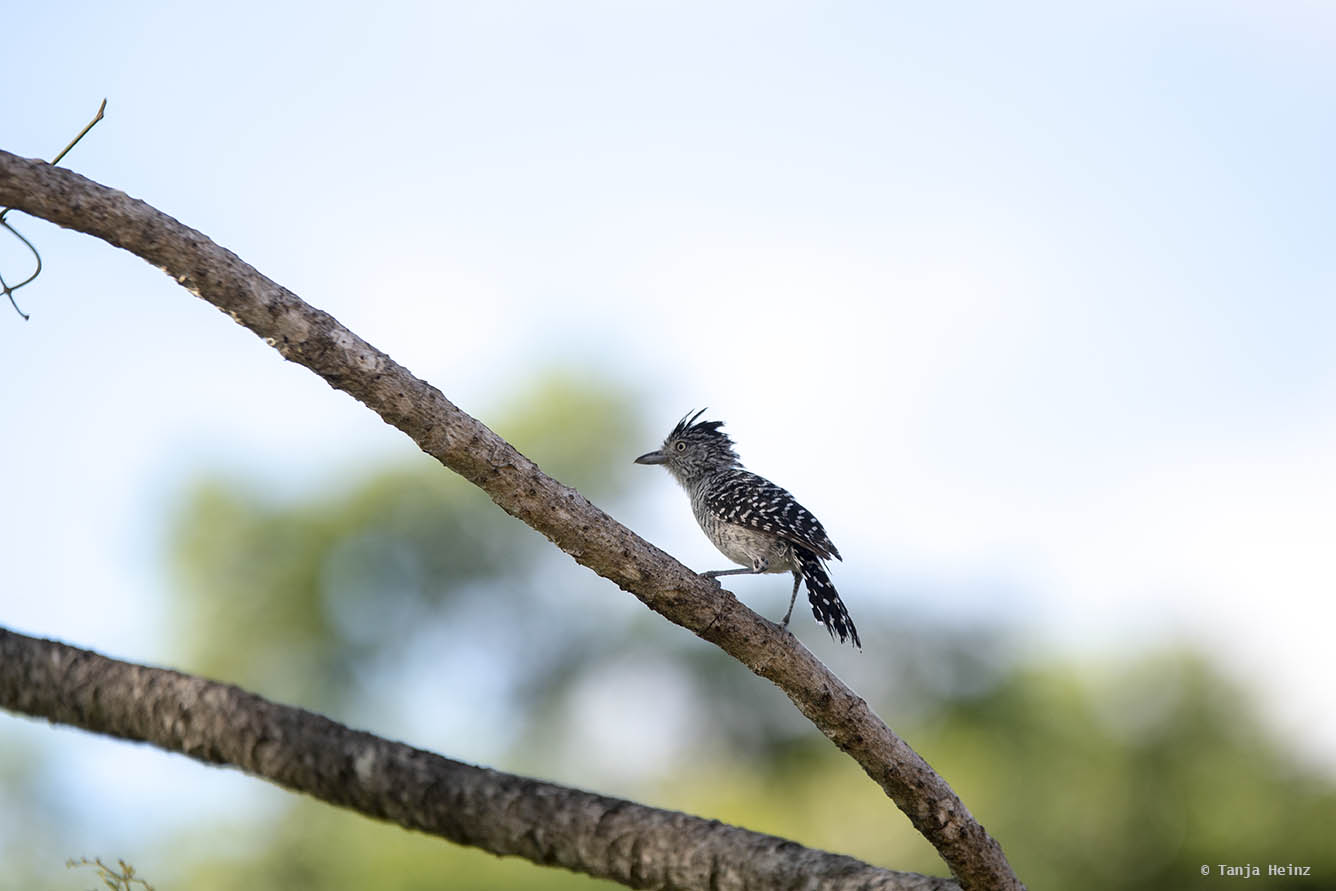
Herons and egrets (Ardeidae)
As mentioned, you can observe many herons and egrets in the Pantanal. We saw especially many birds of this family on our boat tour. We saw capped heron (Pilherodius pileatus), great egrets (Ardea alba), rufescent tiger herons (Tigrisoma lineatum) and a cocoi heron (Ardea cocoi). Later we observed a snowy egret (Egretta thula) close to the Fazenda which you can see on the photograph.
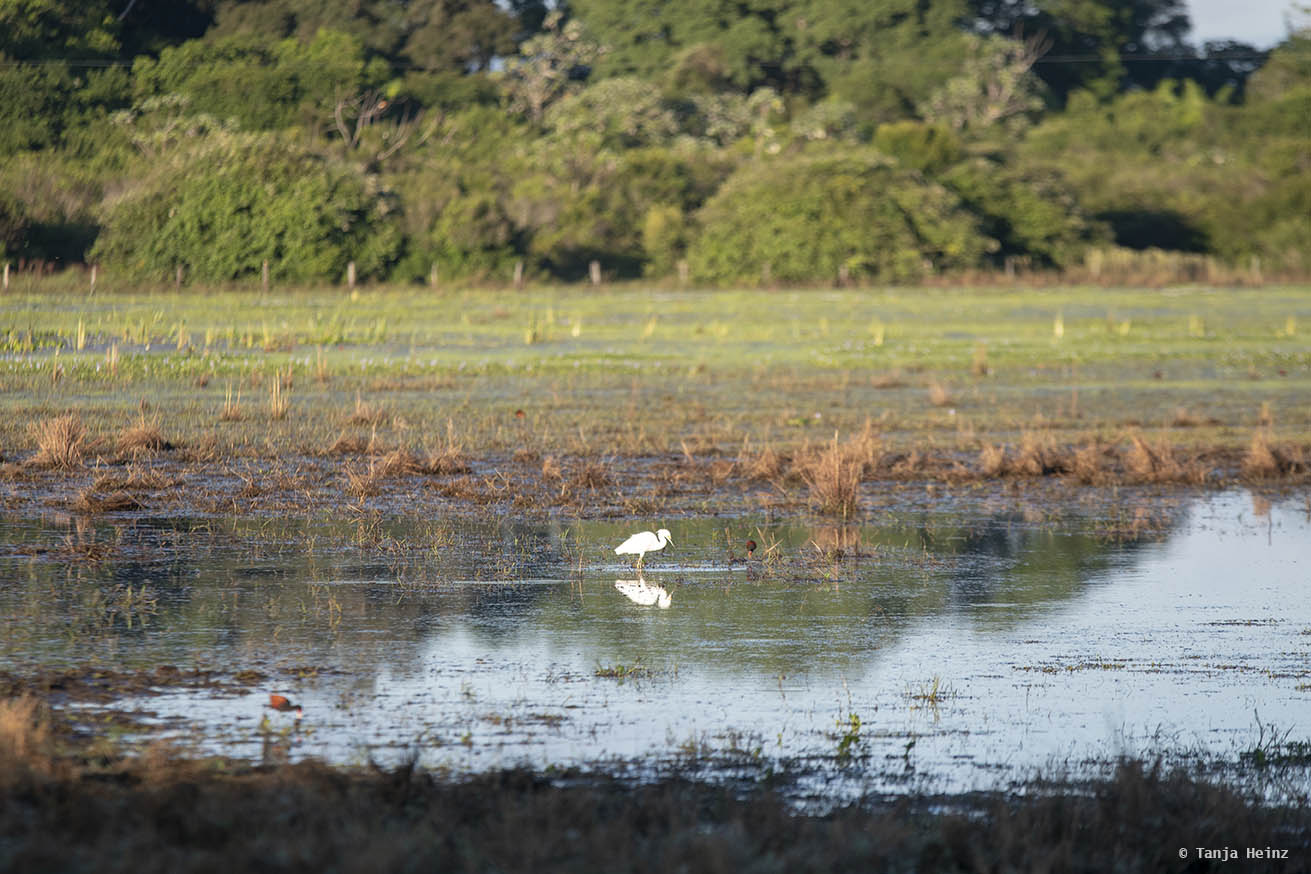
Water birds (Anatidae)
One of the first birds we saw in the Pantanal was a muscovy duck (Cairina moschata). It was actually just before our boat tour on the first day. Muscovy ducks are of “least concern“, however, its populations are in decline.
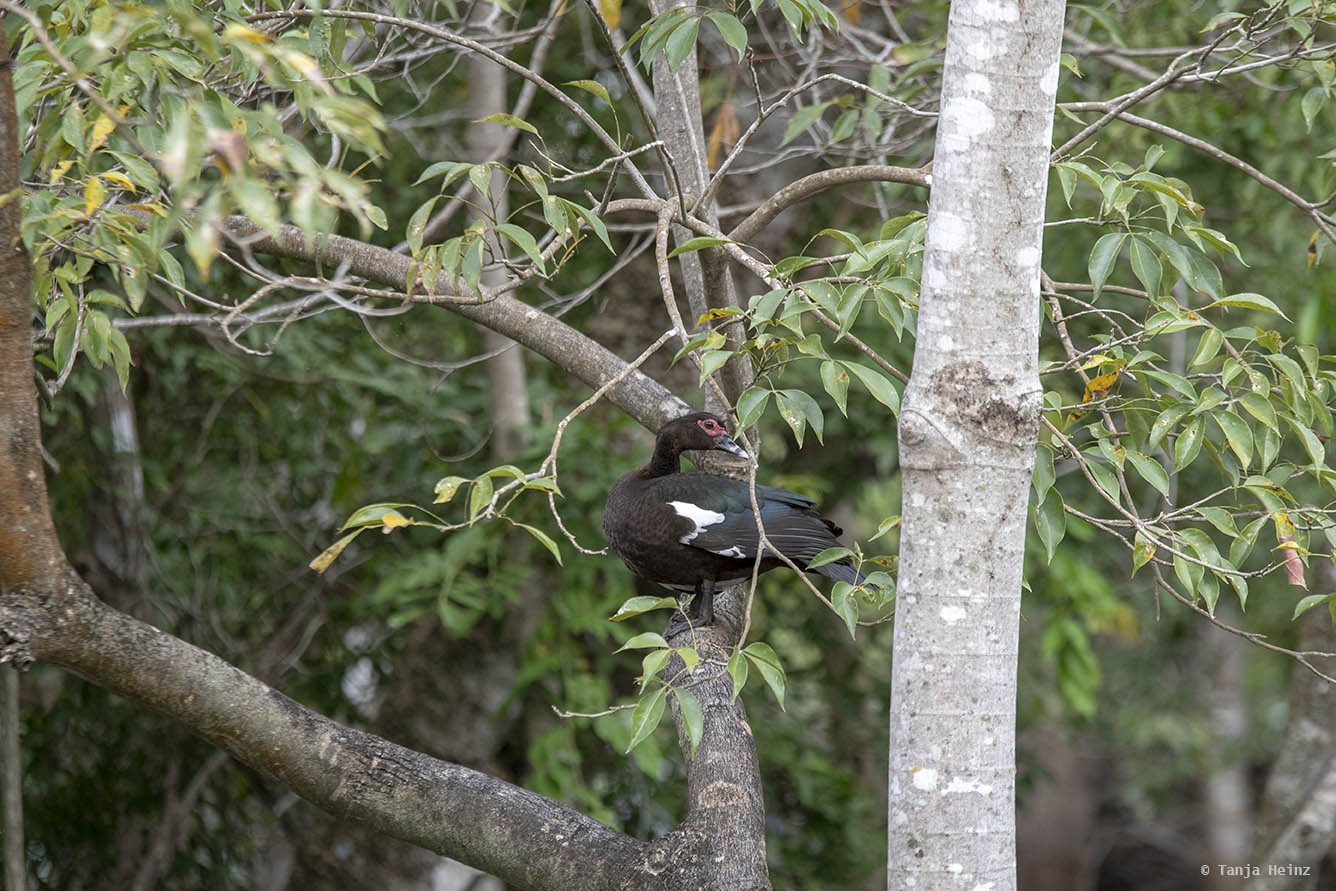
Tyrant flycatchers (Tyrannidae)
Another bird I spotted just before the boat tour and close to the muscovy duck, was a great kiskadee (Pitangus sulphuratus). Great kiskadees are quite abundant in Brazil and their populations seem to grow. Great kiskadees were one of the first birds I spotted in Brazil. I saw them in Mariana, close to Ouro Preto. It was not the only tyrant flycatcher I saw in the Pantanal. The other species‘ name was cattle tyrant (Machetornis rixosa). They were quite abundant close to the Fazenda, and apparently, their populations are stable (above: great kiskadee, below: cattle tyrant).
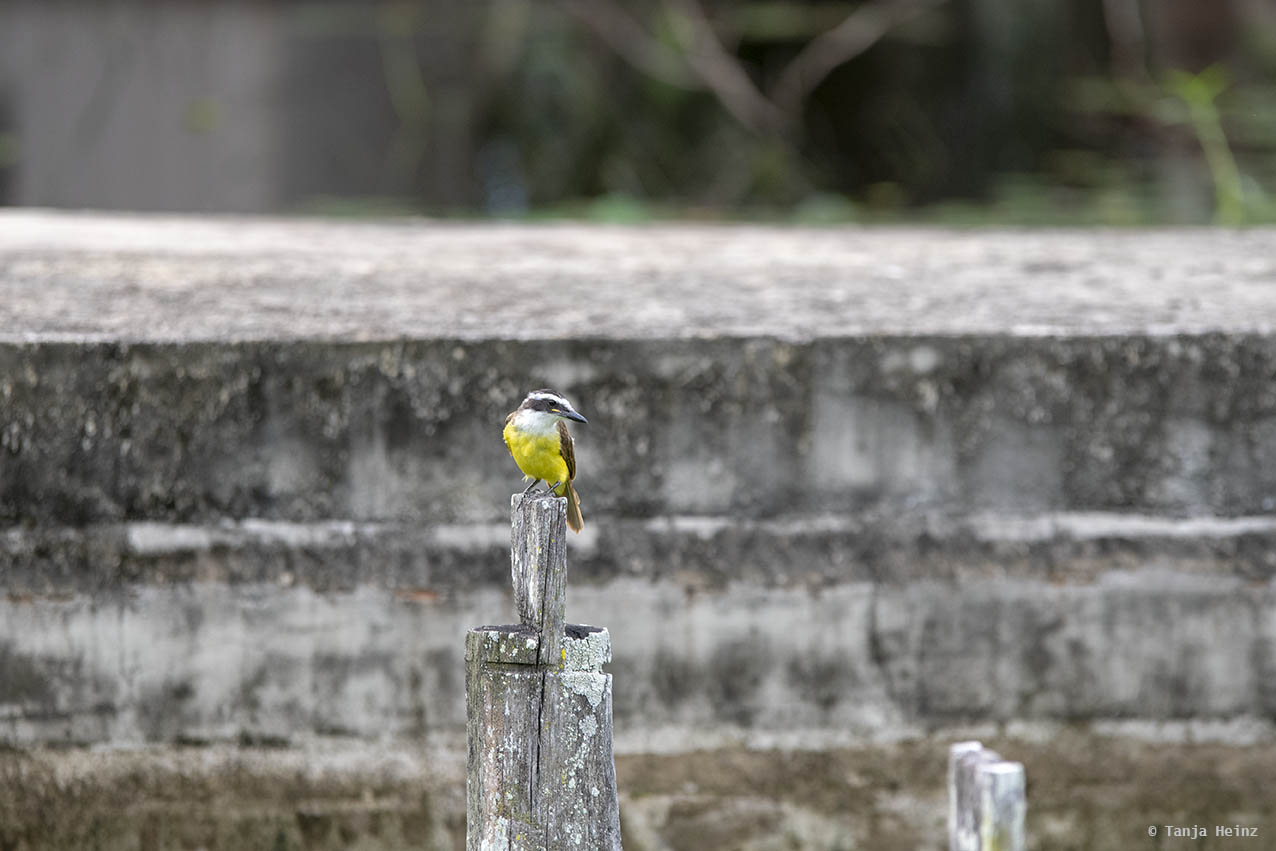
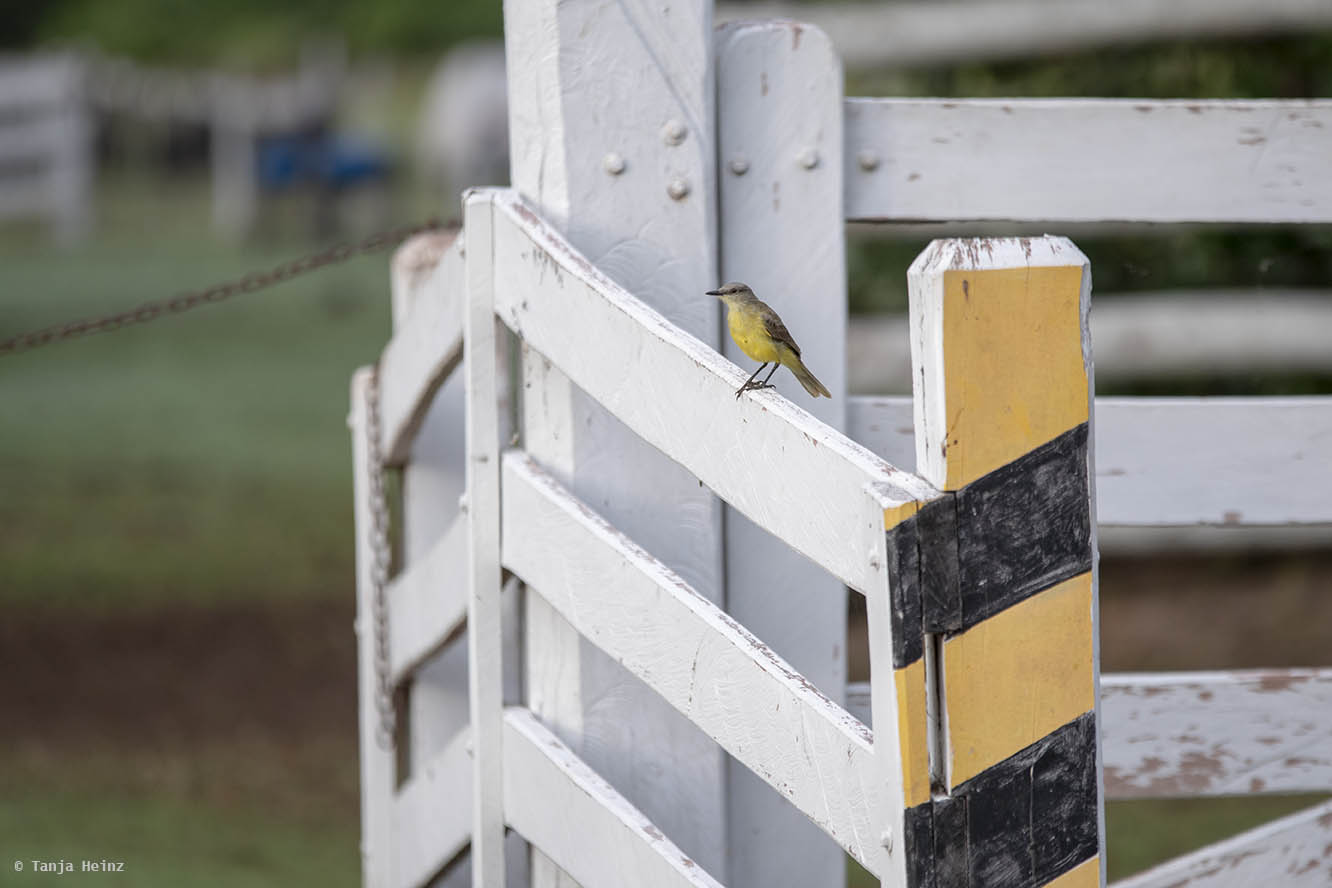
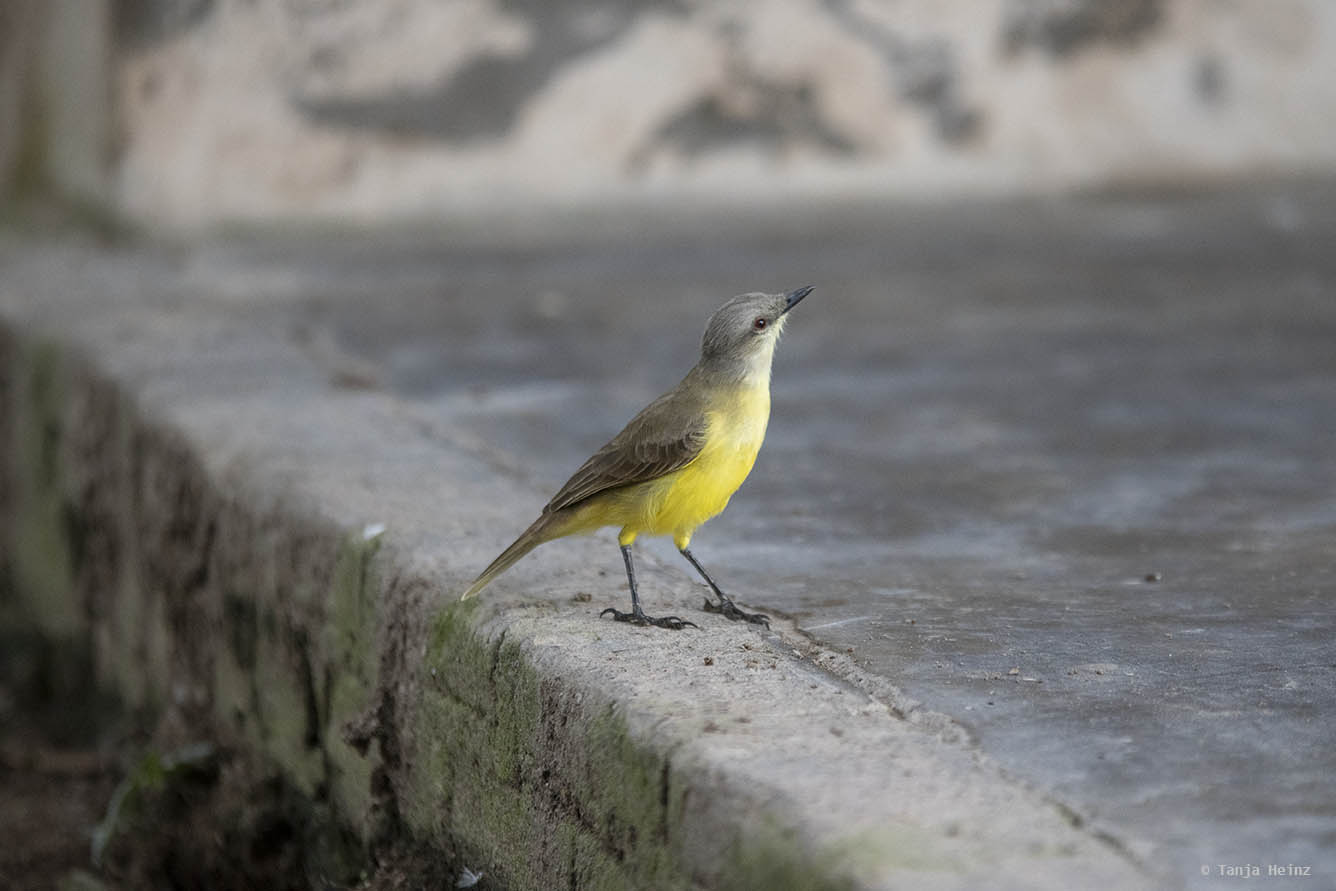
Ovenbirds (Furnariidae)
I encountered one species of the ovenbird family quite frequently close to the Fazenda. I met this bird species, namely, rufous horneros (Furnarius rufus) already in Itaúnas and was impressed by their nest building abilities. In the Pantanal we observed again rufous horneros including one of them just in front of its nest. Another ovenbird, namely a grey-crested cacholote (Pseudoseisura unirufa), was just close to the great kiskadee we observed just before the boat tour (above: rufous hornero, below: grey-crested cacholote)
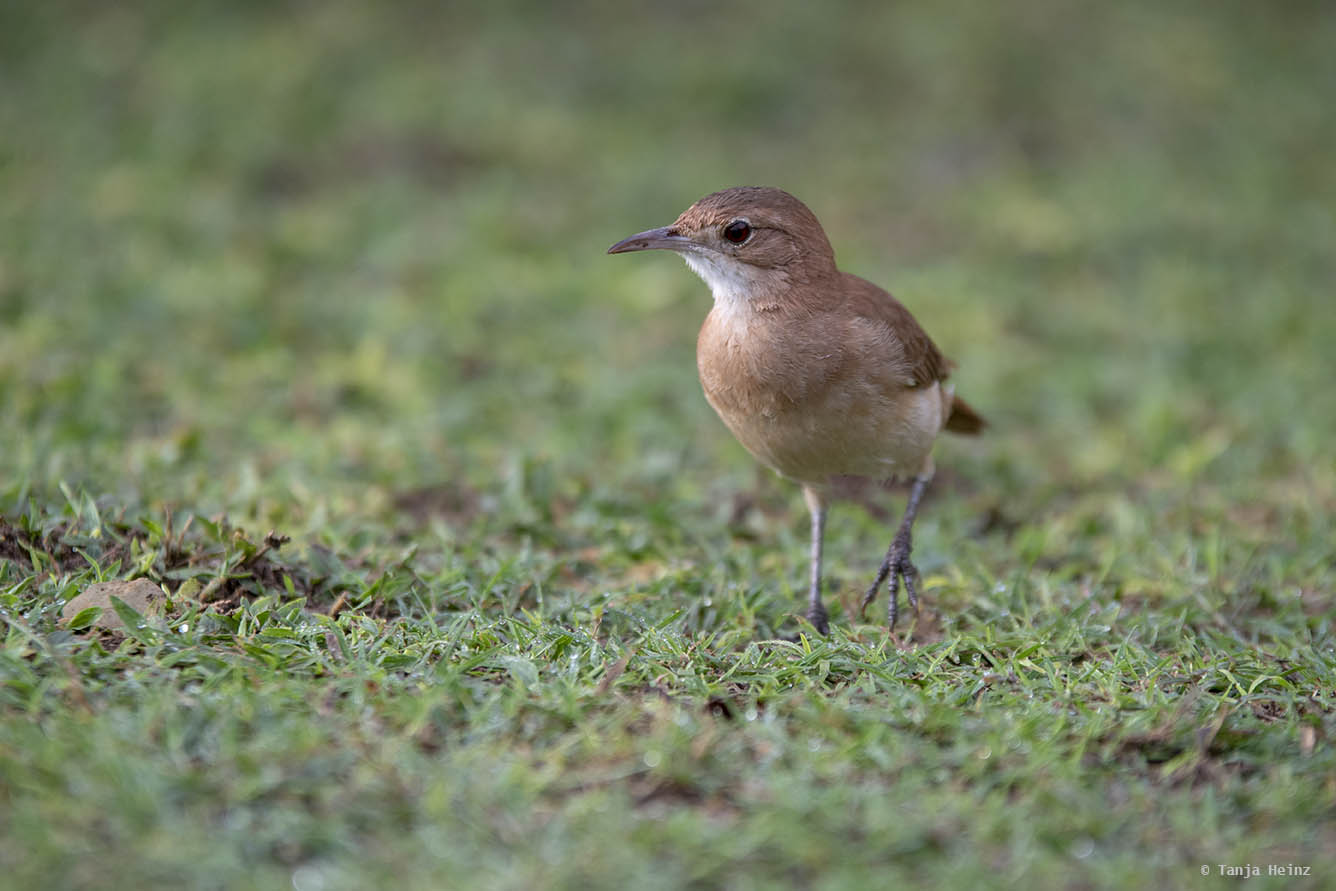
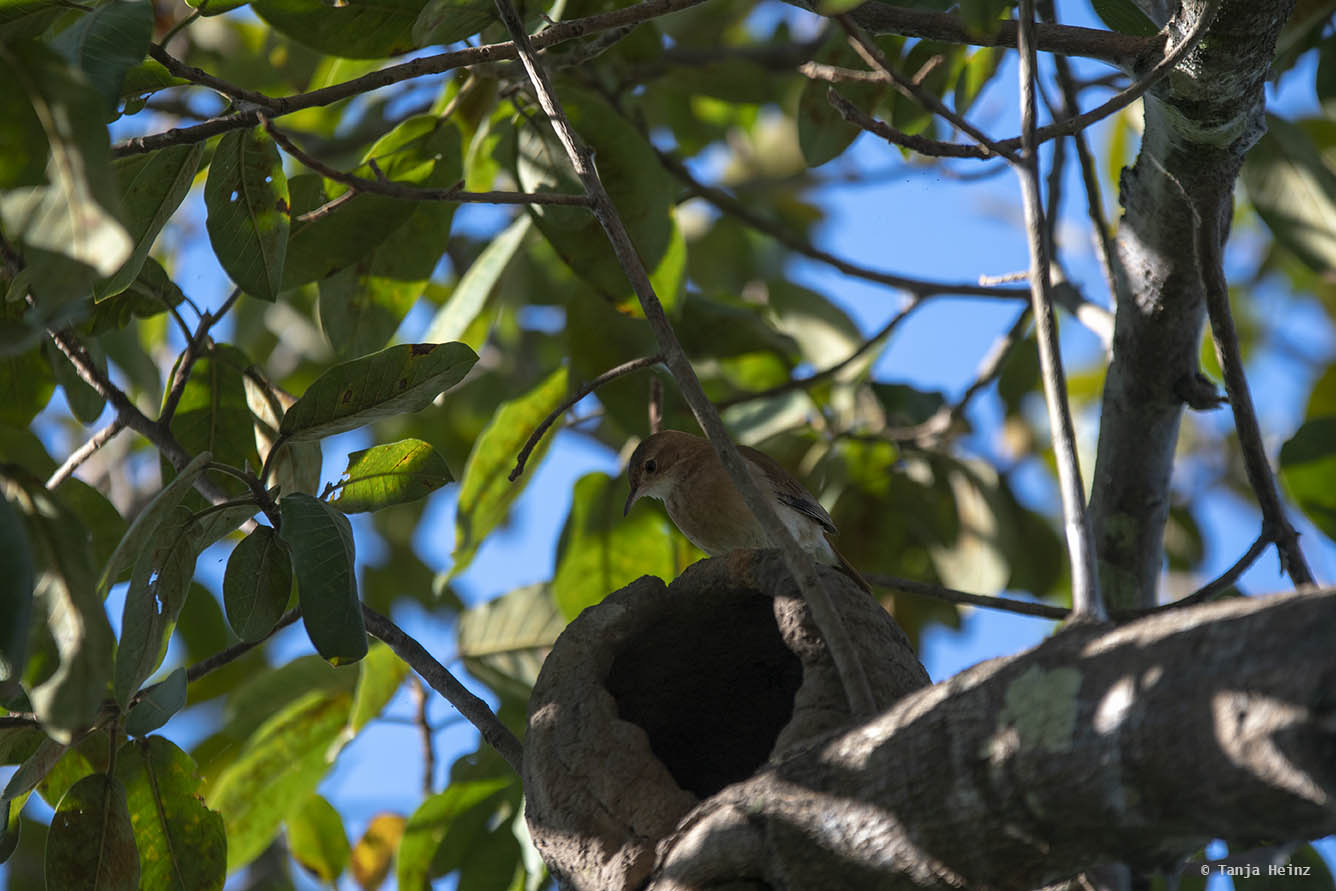
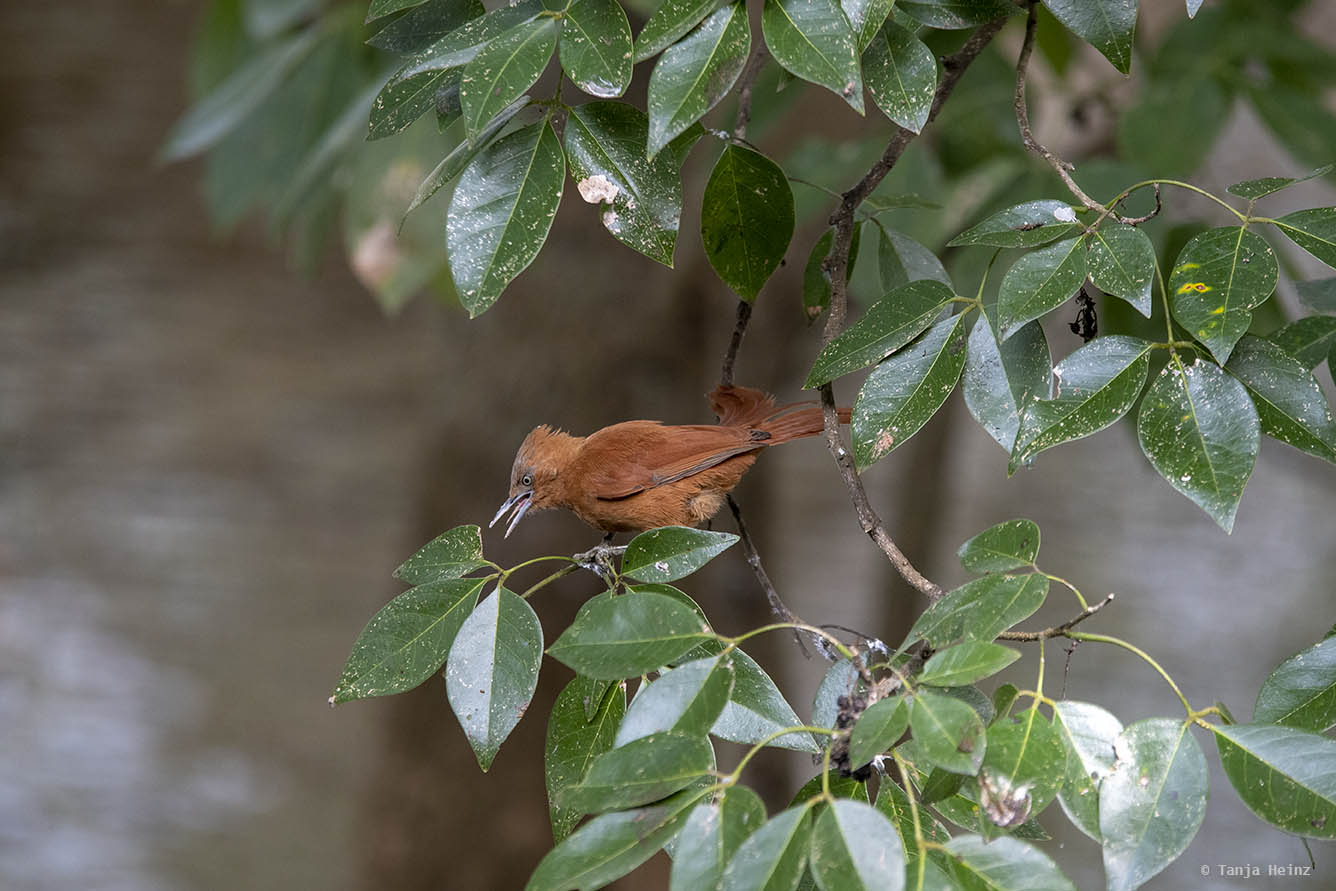
Guineafowls (Numididae)
Besides all those cattle tyrants, rufous horneros and monk parakeets, farmers kept helmeted guineafowls (Numida meleagris) on the Fazenda. Actually, helmeted guineafowls are native to Africa, but they were introduced into Brazil and other South American countries.
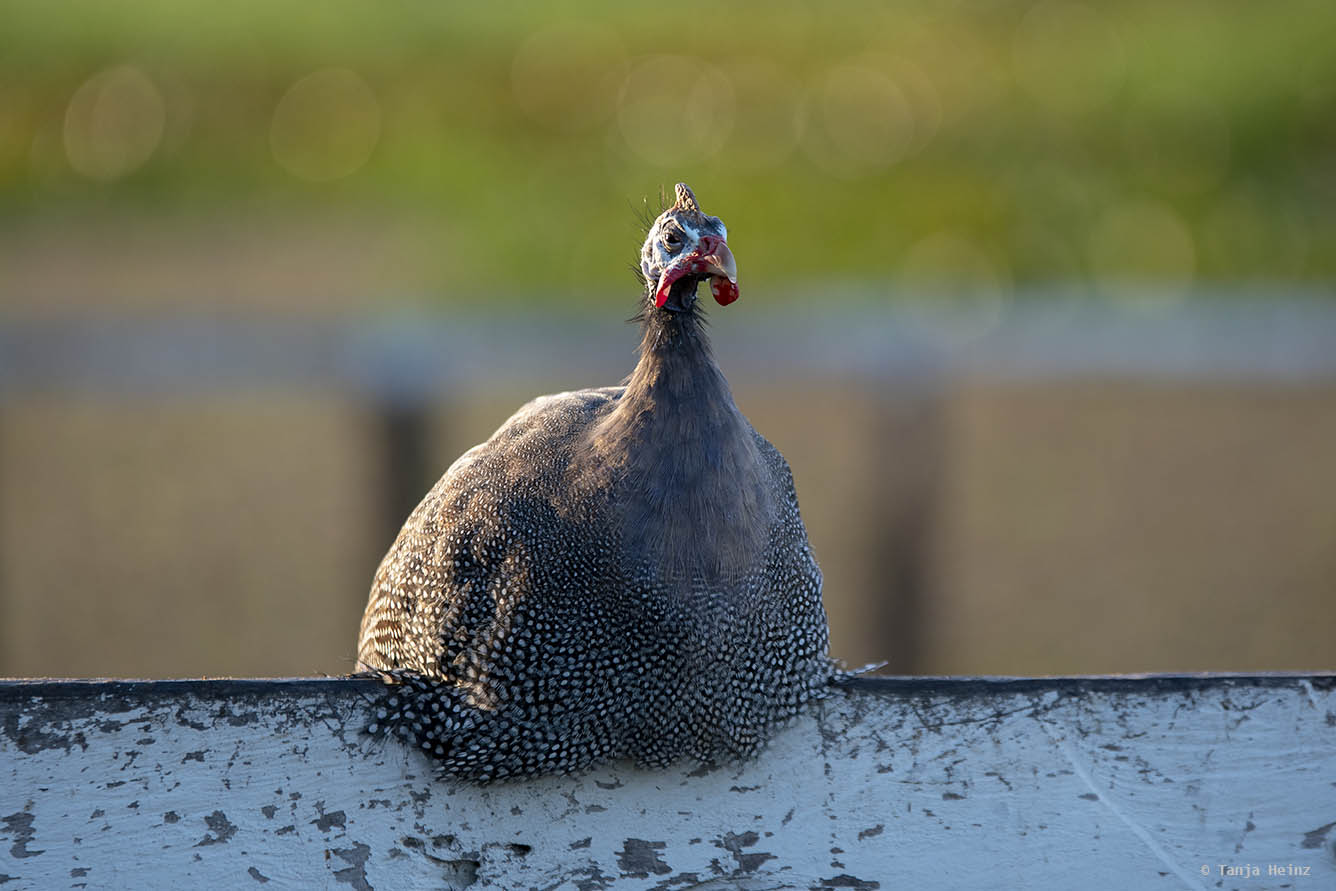
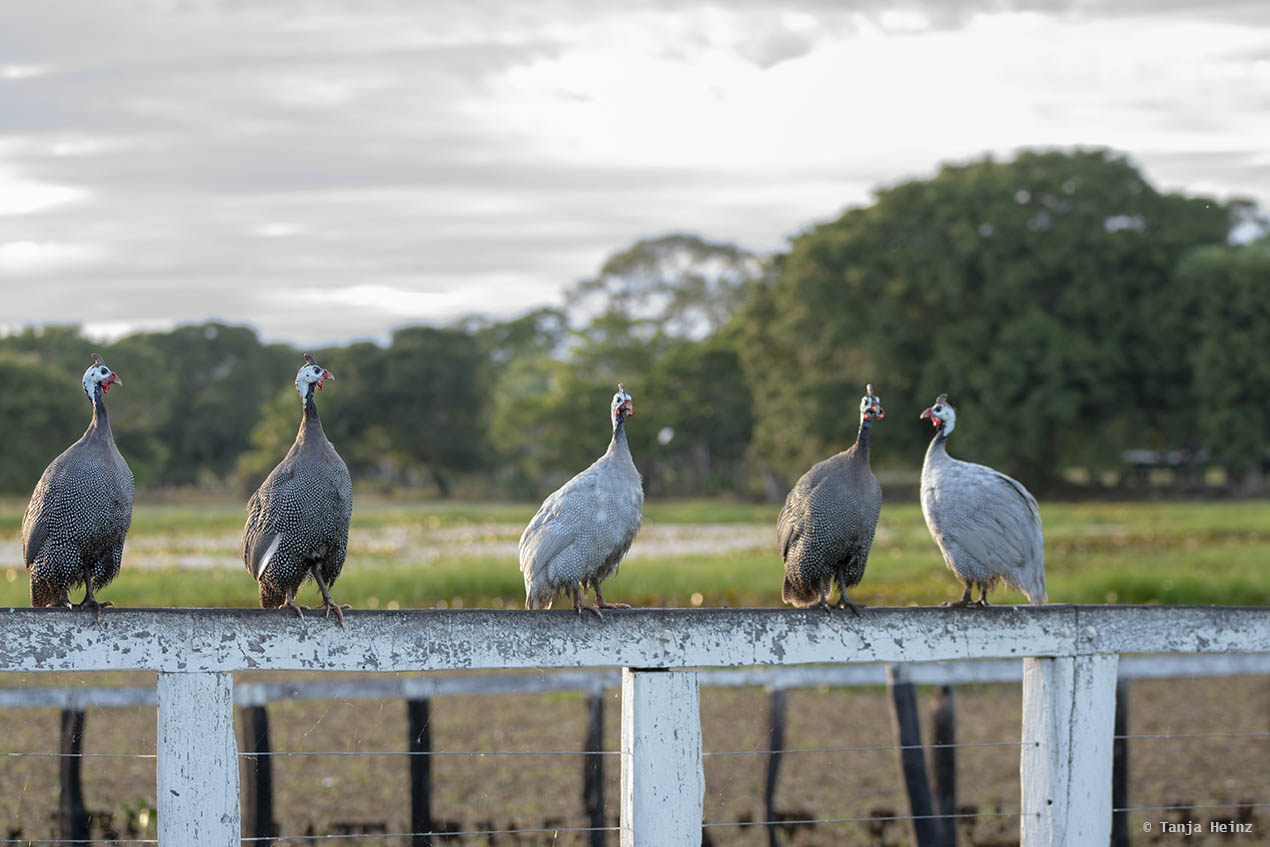
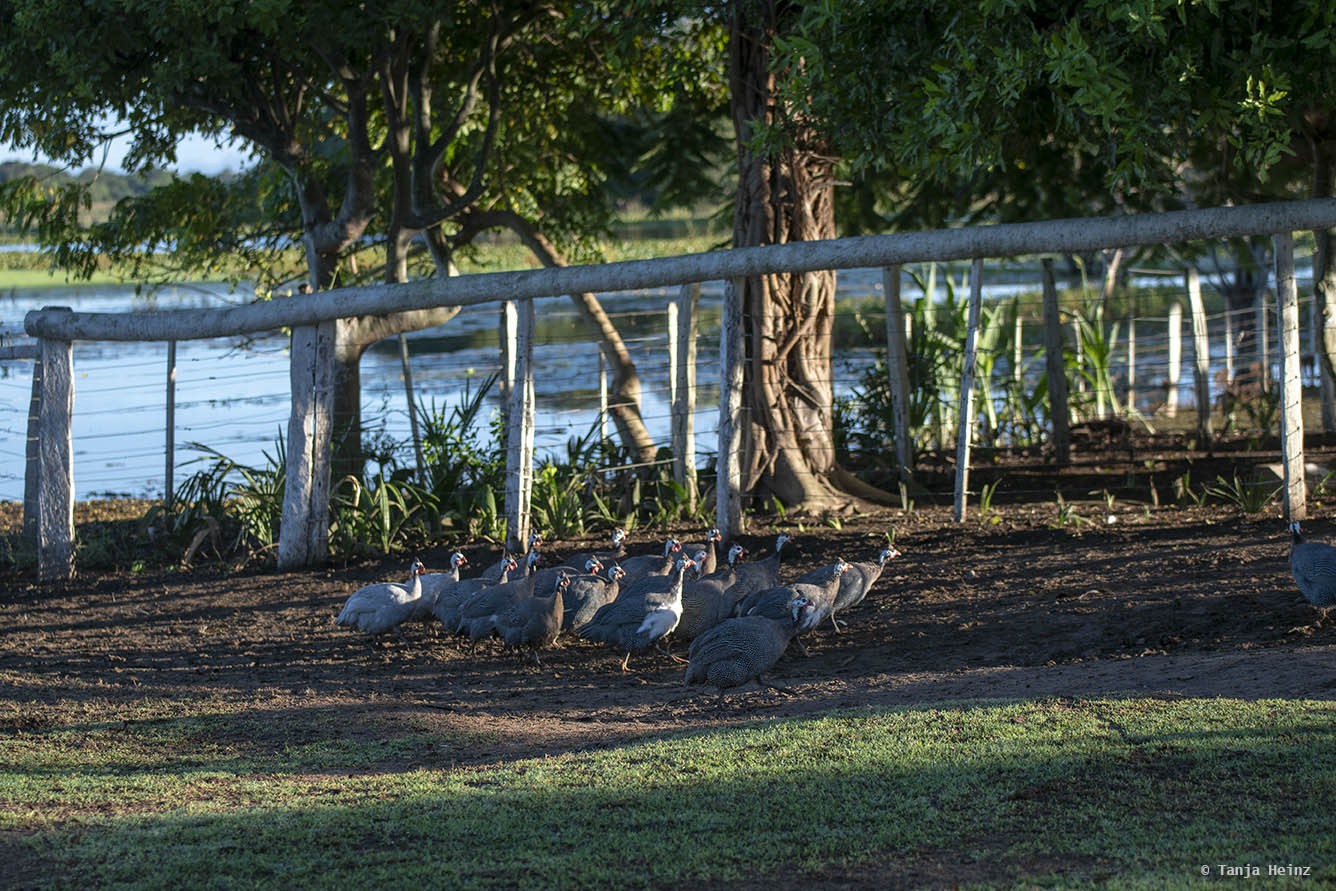
Storks (Ciconiidae)
Jabirus (Jabiru mycteria) belong to the family of the storks and are typical birds of the Pantanal in Brazil. They are widely distributed in South America and can be easily recognized by their black head and upper neck with a red pouch at the base. We could see them frequently from afar wading through flooded areas of the Pantanal.
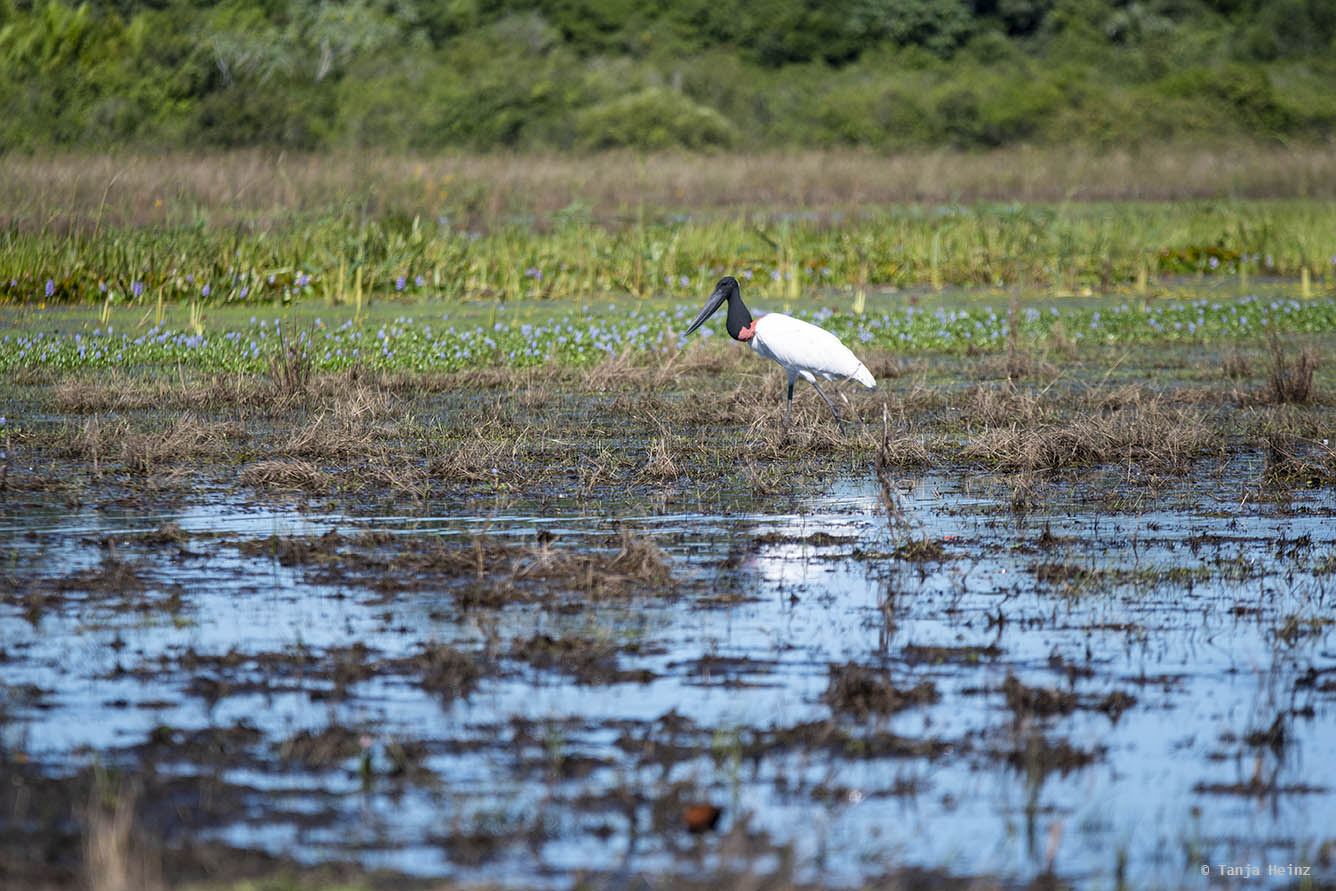
Ratite birds (Rheidae)
One bird I didn’t expect to see at all was the greater rhea (Rhea americana). When all of us were sitting in the car, one of the other participants spotted a greater rhea far away. What an amazing and unexpected encounter I thought. According to the IUCN greater rheas are “near threatened” and their populations are in decline.
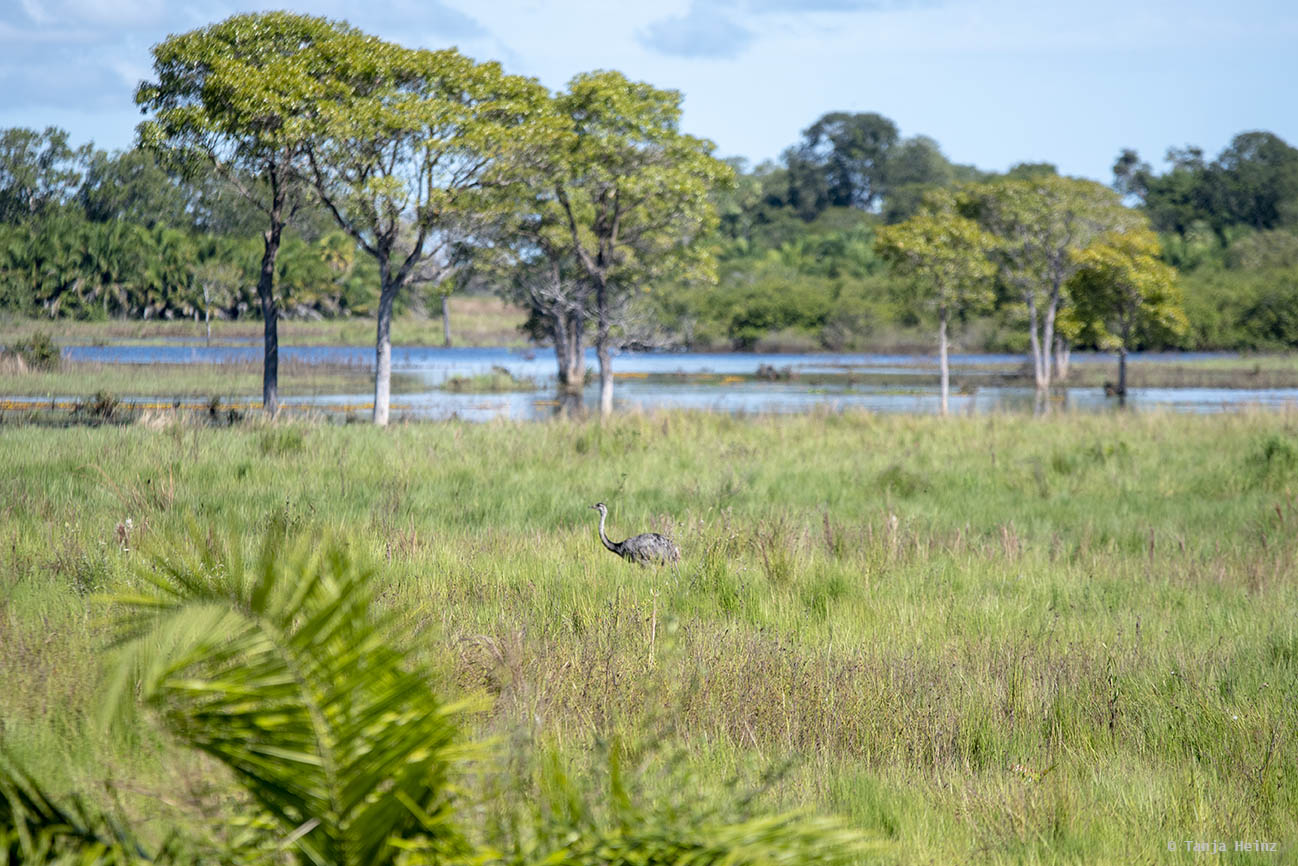
Tanagers (Thraupidae)
One bird family I observed in general quite often in Brazil was the the family of the tanagers. Be it in the Itatiaia National Park or in Ubatuba, tanagers are typical birds in South America. In the Pantanal we observed two species of them: the yellow-billed cardinal (Paroaria capitata) and the red-crested cardinal (Paroaria coronata). Both of them reminded me of red-cowled cardinals (Paroaria dominicana) which I had observed in Itaúnas. (left: yellow-billed cardinal, right: red-crested cardinal)
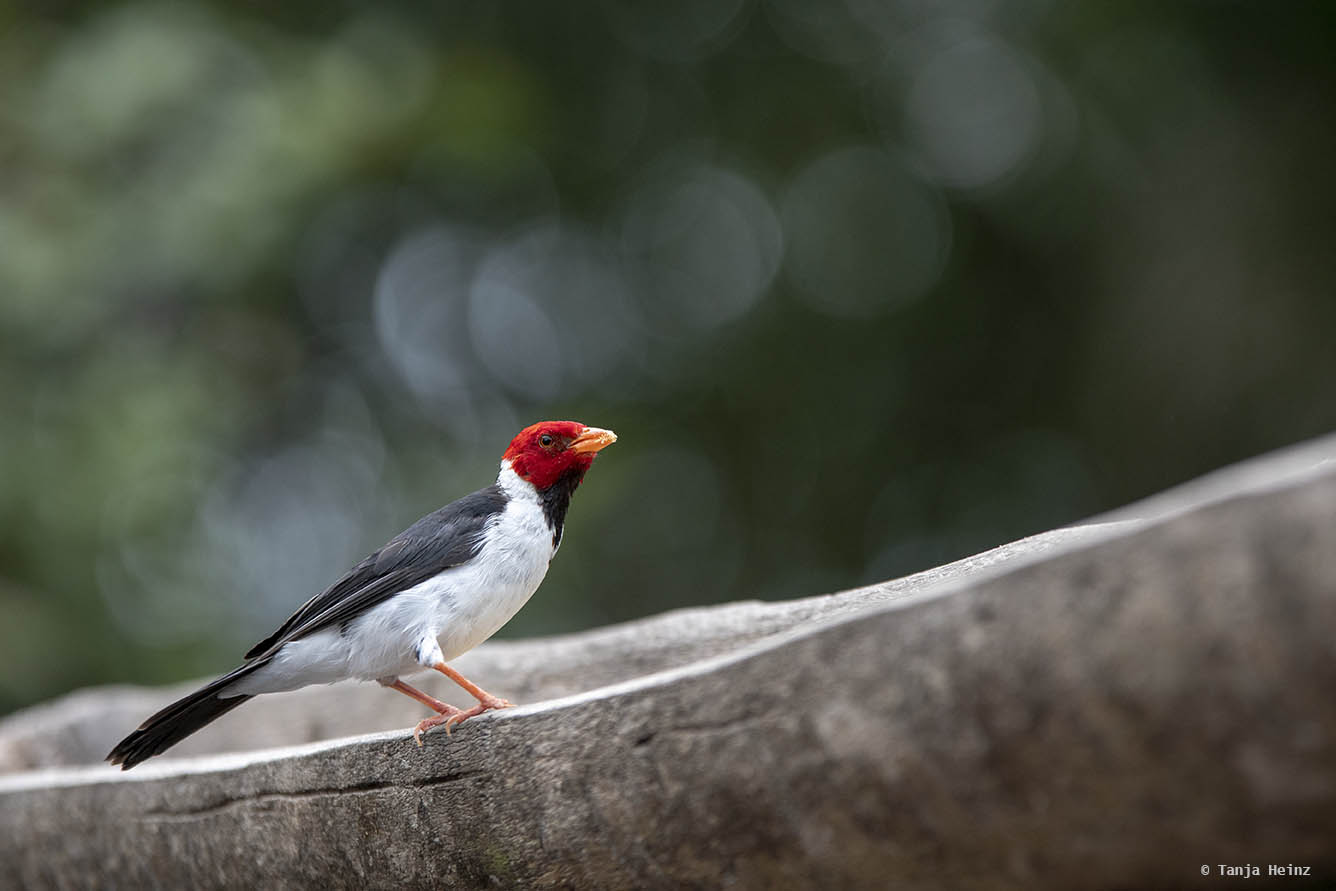
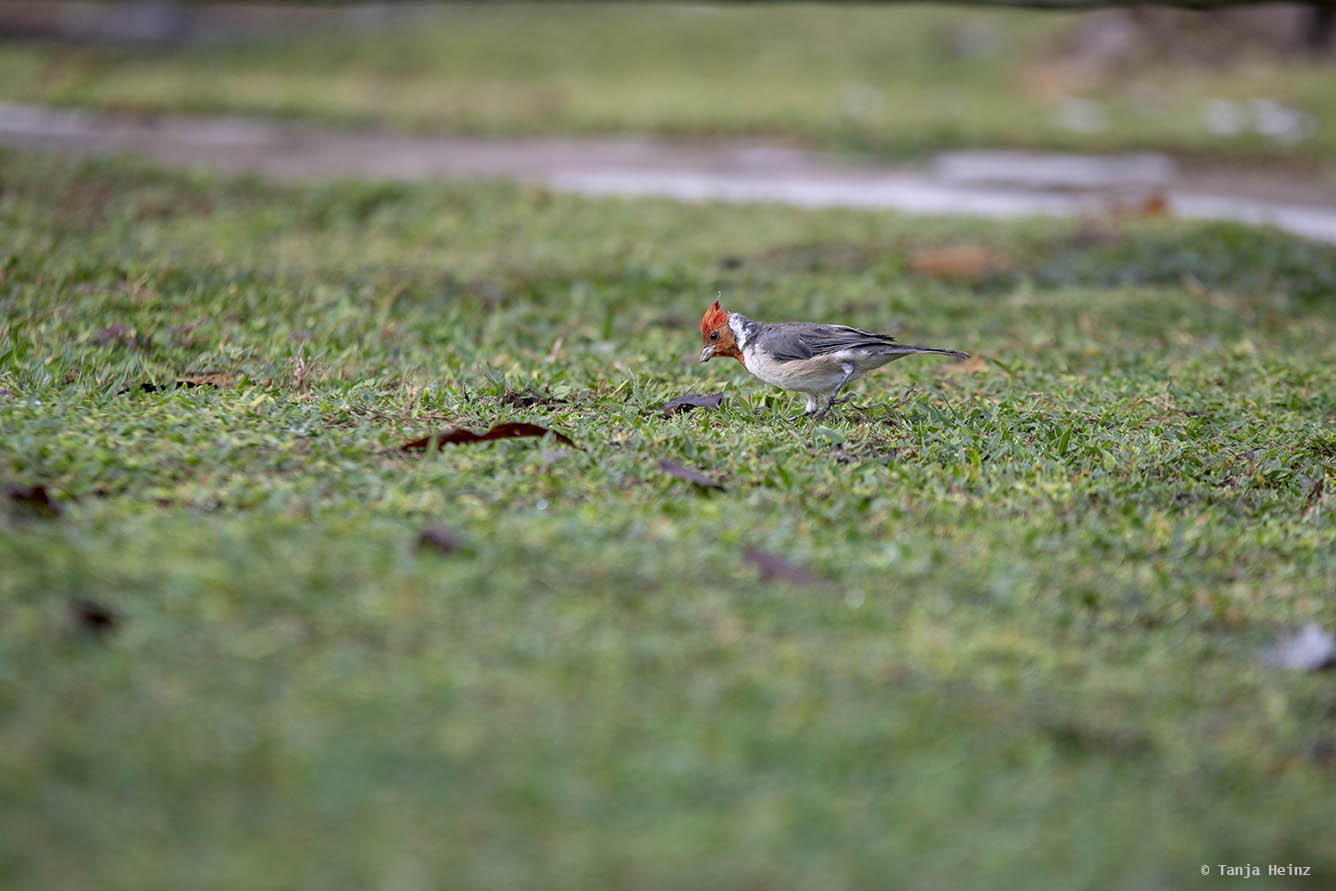
After our trip to the Pantanal we stayed two days in Campo Grande and saw another tanager close to our hotel. It was a bananaquit (Coereba flaveola).
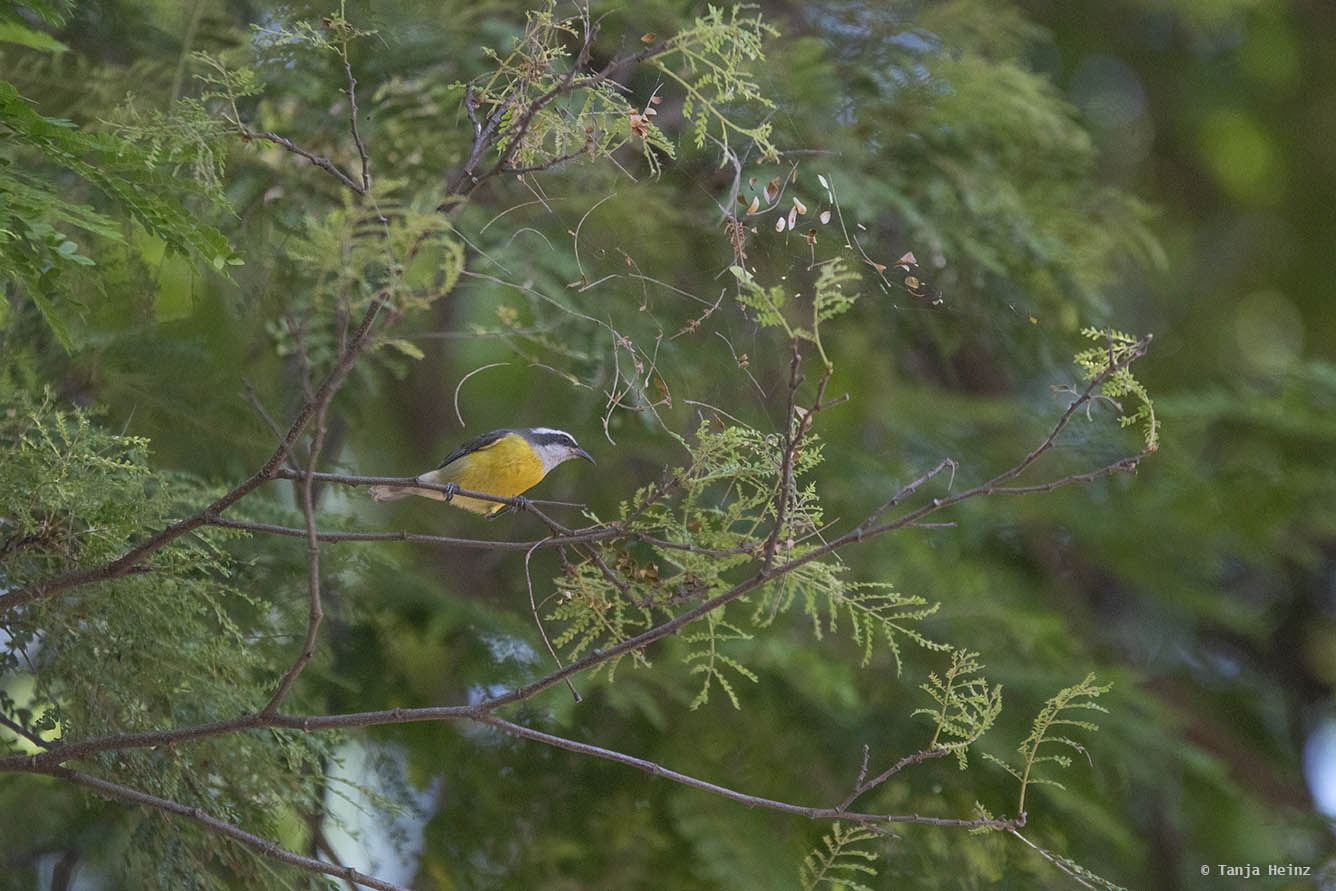
Woodpeckers (Picidae)
One bird I could observe for a quite long time was a woodpecker. While most of the other participants of the tour were fishing, I spotted a little woodpecker (Dryobates passerinus) building a hole. Another bird encounter which was very special.
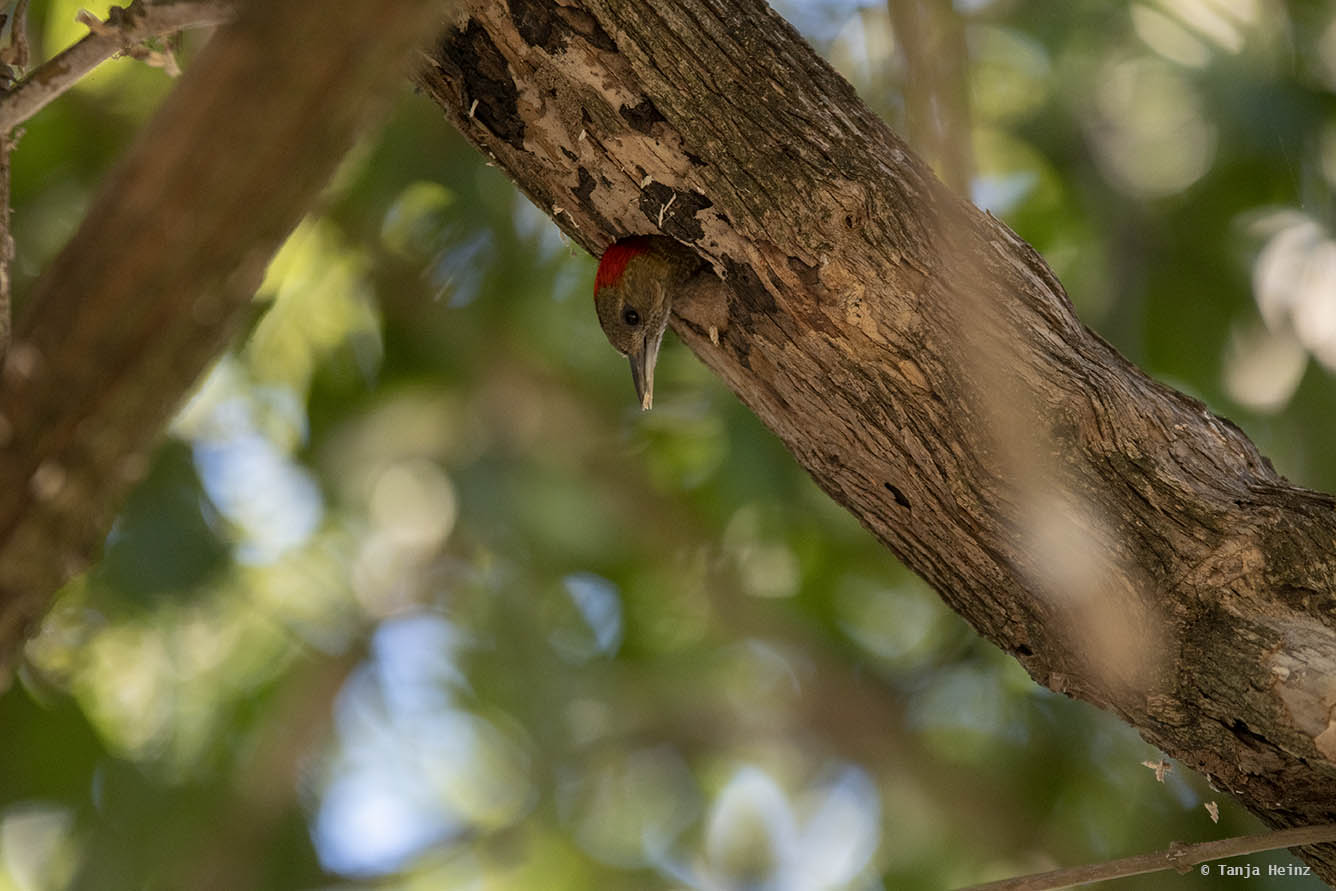
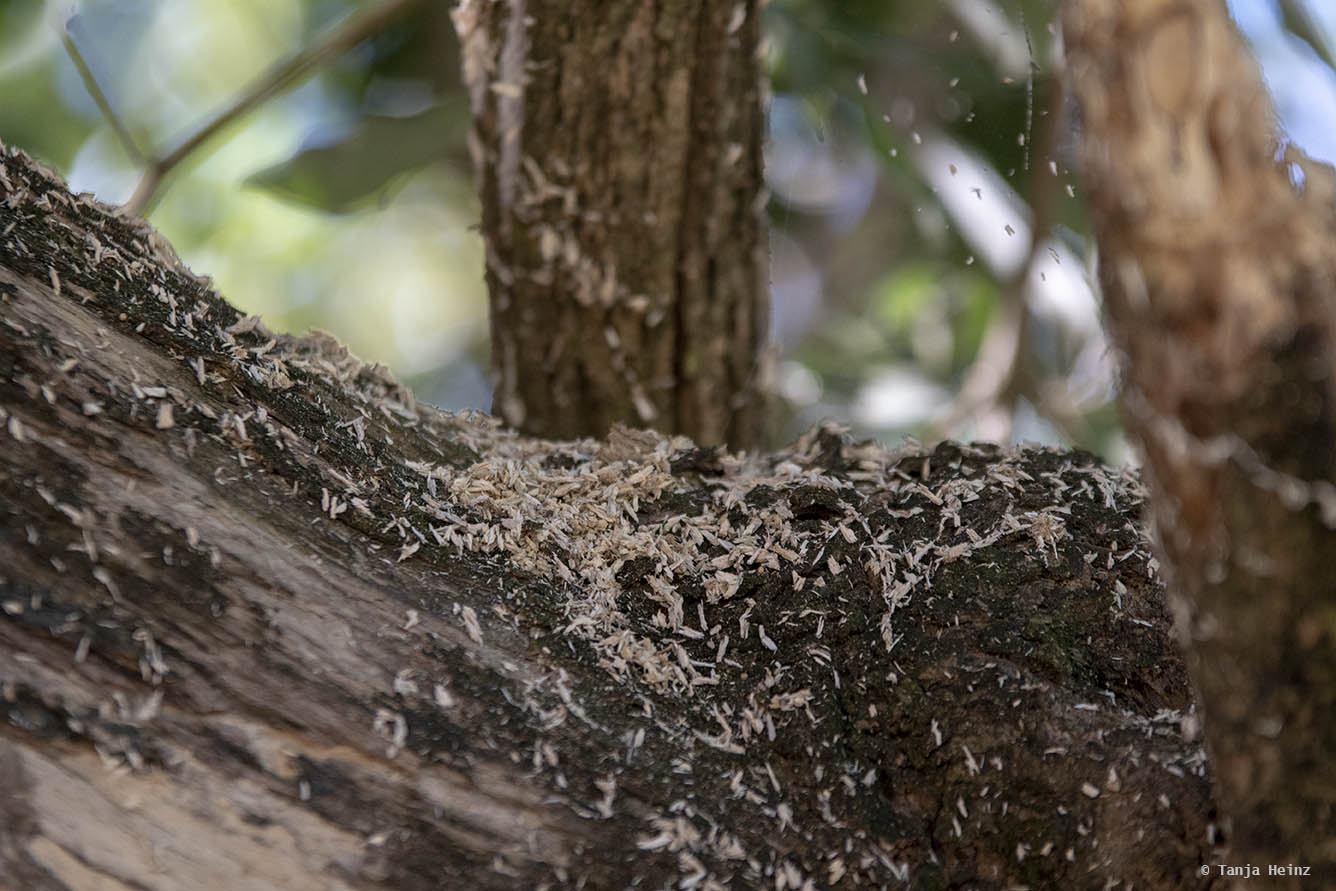
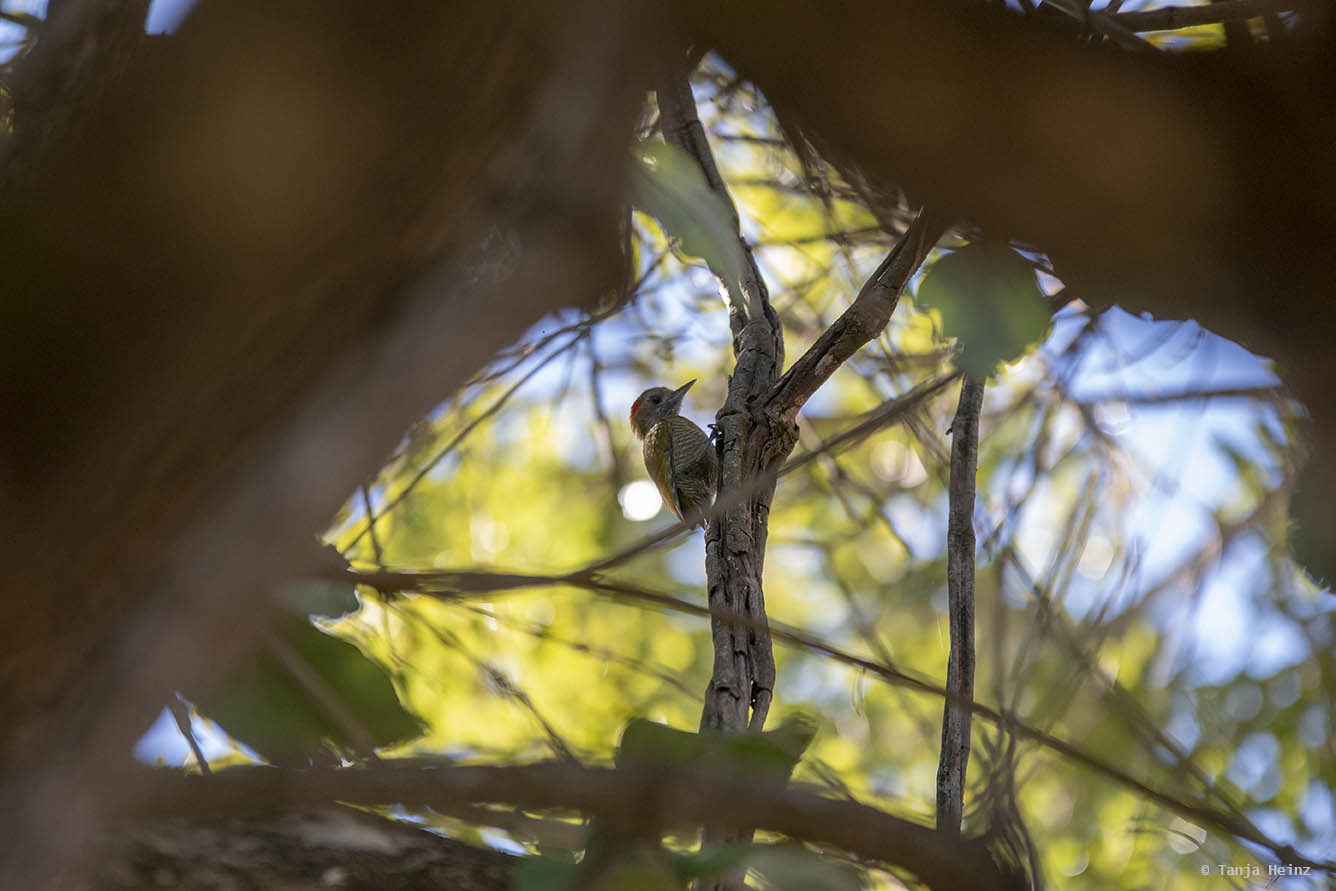
However, it was not the only woodpecker we saw. We also saw a green-barred woodpecker (Colaptes melanochloros) in the forest on one of our walks.
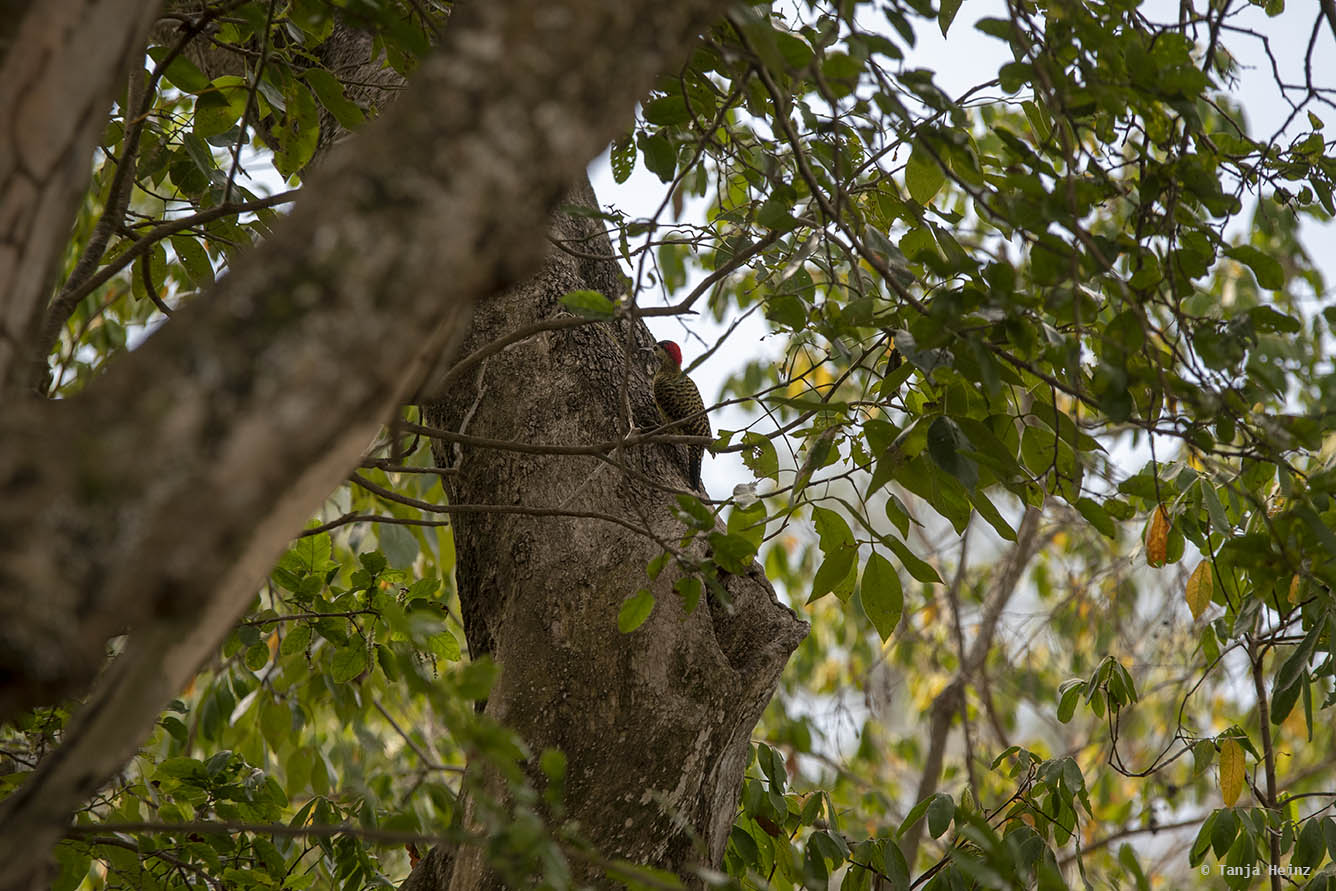
Birds of prey (Accipitridae)
I usually left the eating area before the others as I wanted to observe as many animals as possible around the Fazenda. On one day I was lucky enough to encounter a black-collared hawk (Busarellus nigricollis) in flight. These birds are widespread in South and Central America and of “least concern”. However, like many other bird species probably in decline.
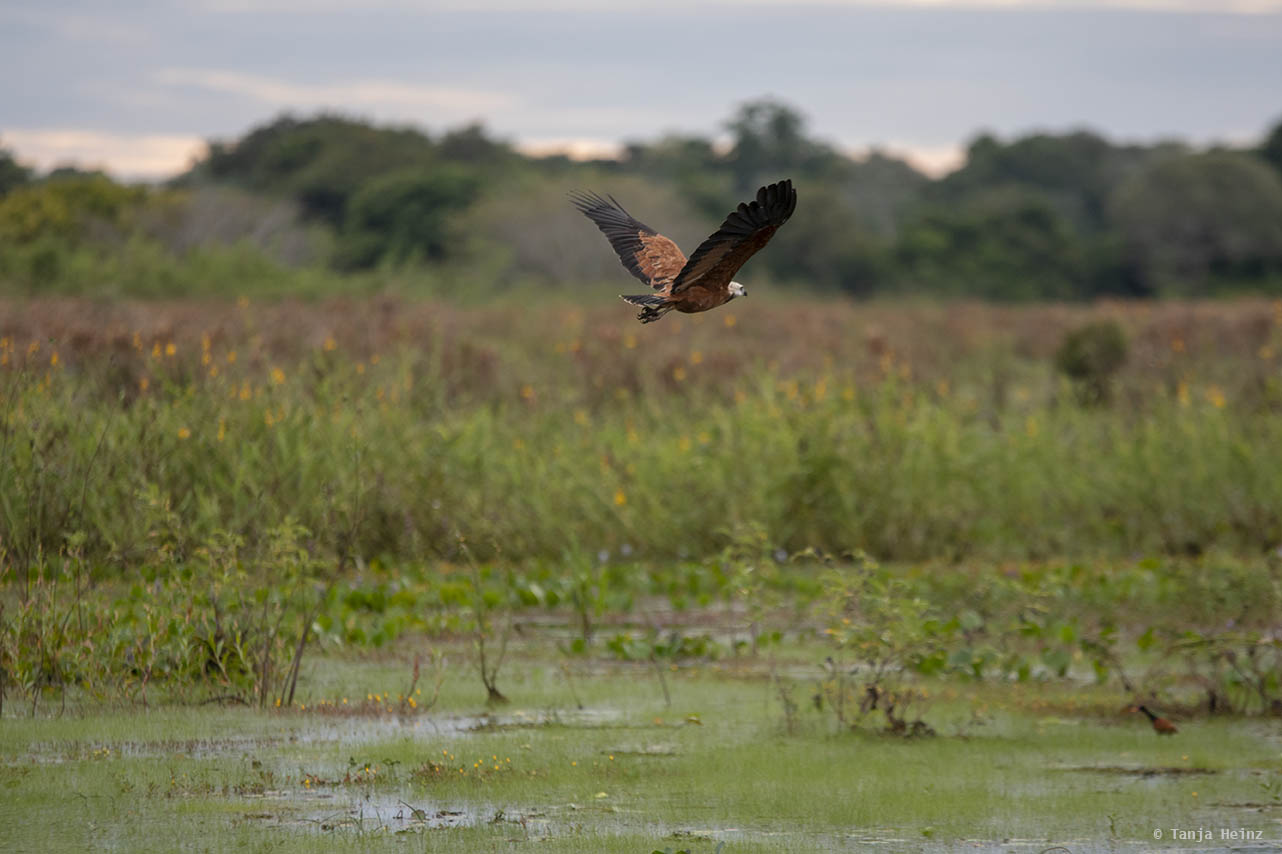
Jacamars (Galbulidae)
Jacamars are neotropical birds, and thus, occur only in tropical regions of the Americas. We observed one rufous-tailed jacamar (Galbula ruficauda) perching on a branch of a tree. Despite of our presence, the bird did not fly away at all. The bird is widely distributed in South America, especially in Brazil.
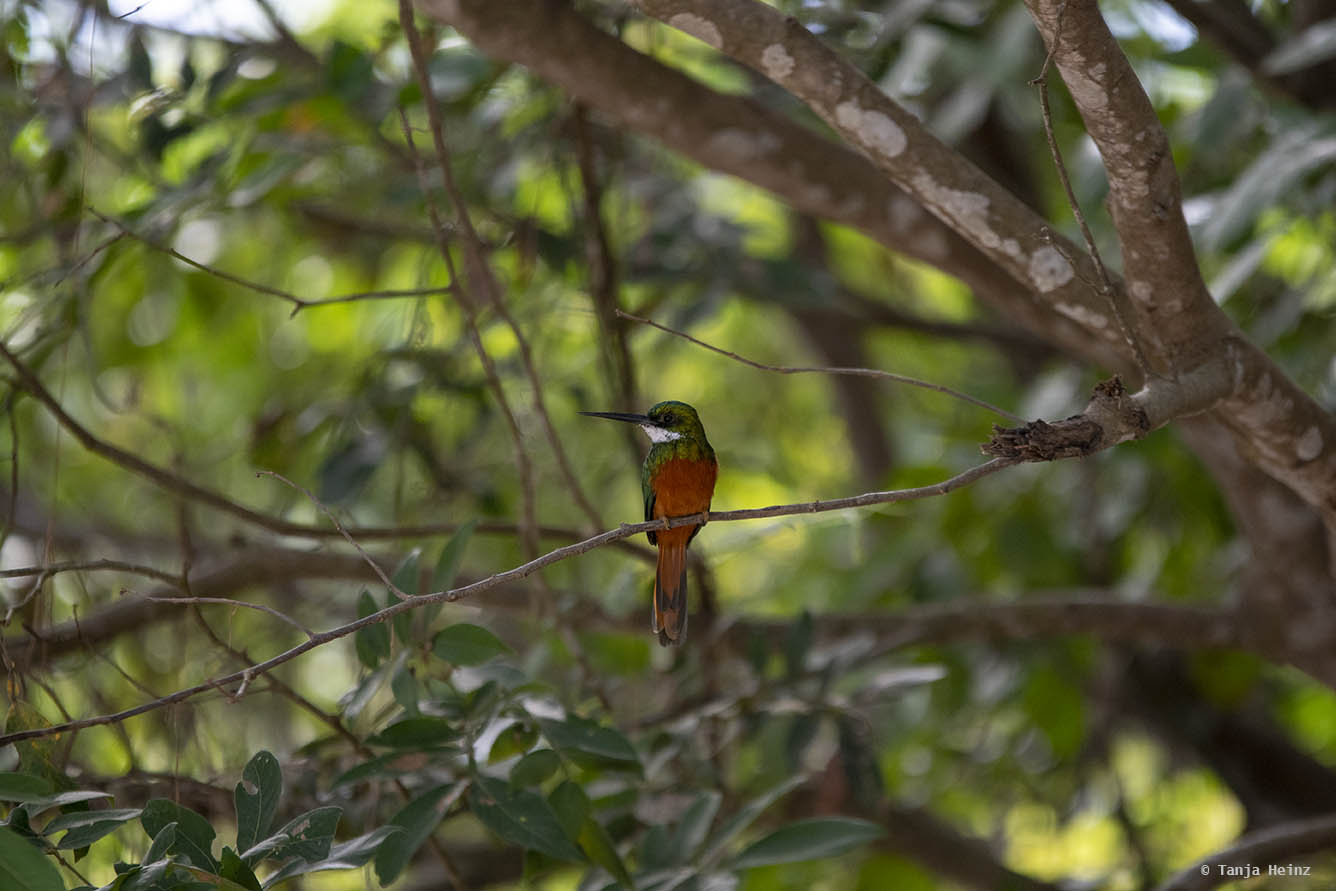
Jacanas (Jacanidae)
Jabirus or hyacinth macaws are very typical birds of the Pantanal in Brazil. However, the wattled jacana (Jacana jacana) is another one although it has a wide distribution in South America. We spotted them quite frequently around the Fazenda.
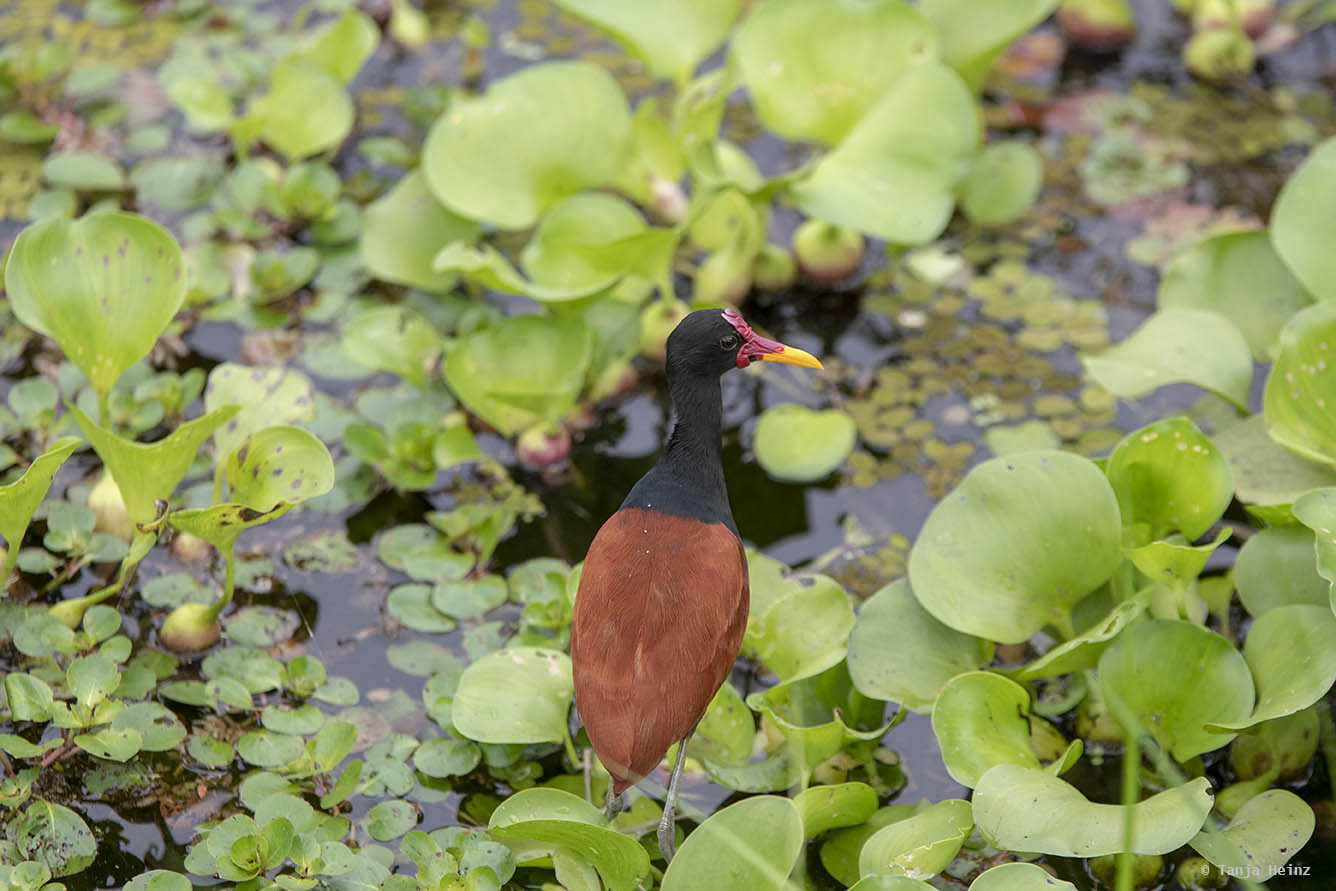
Wrens (Troglodytidae)
A rather inconspicuous bird among all those prominent birds was the thrush-like wren (Campylorhynchus turdinus). Interestingly, this bird does not have a continuous distribution in Brazil. It occurs in the western Pantanal and in eastern Brazil, but not in between.
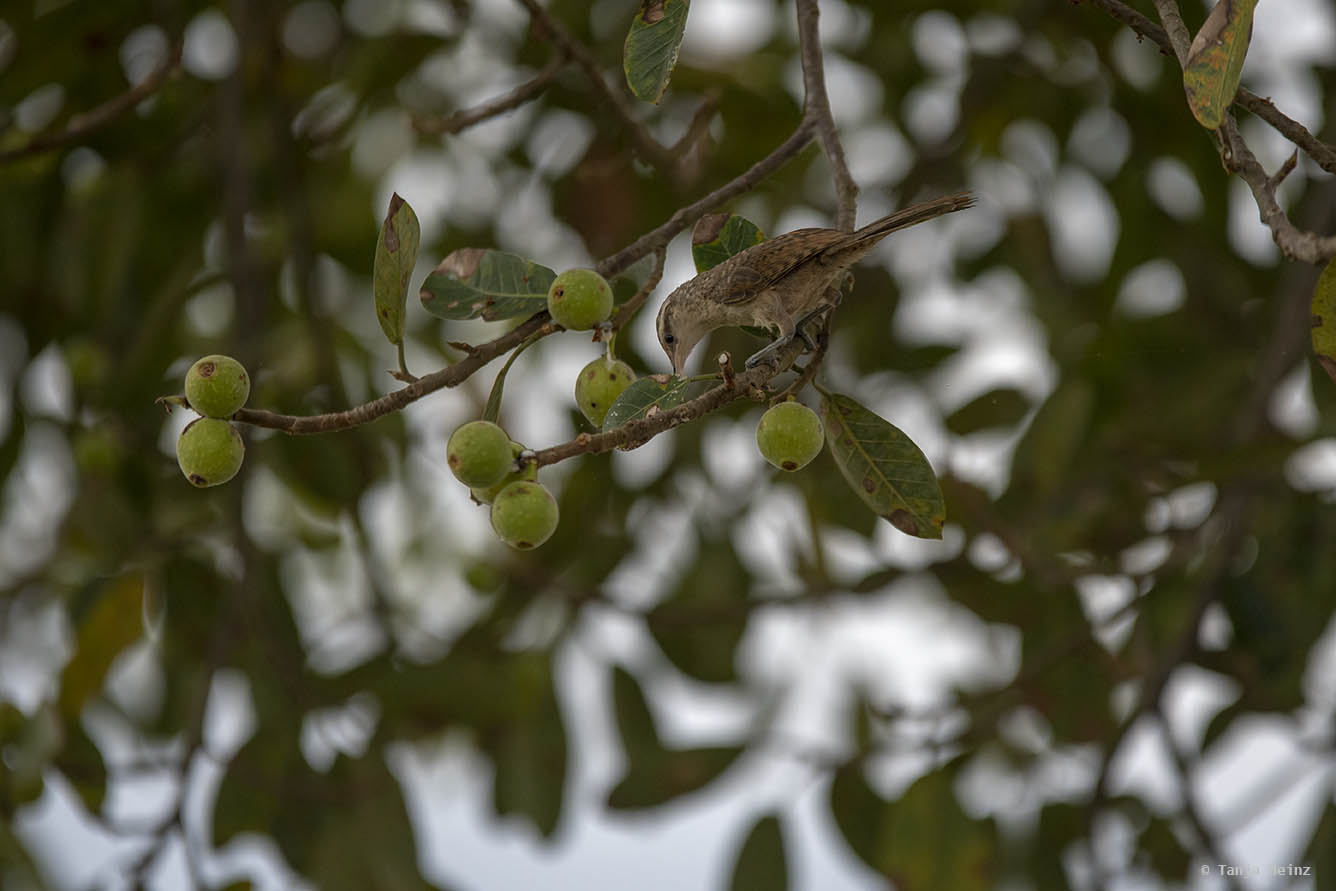
Falcons and caracaras (Falconidae)
Our encounter with Southern caracaras (Caracara plancus) on our boat trip was not the only one. We spotted another Southern caracara again after our walk through the forest. In this moment I had to decide to look between two species. Southern caracaras on the right and grey brockets on the left. So much wildlife to see…
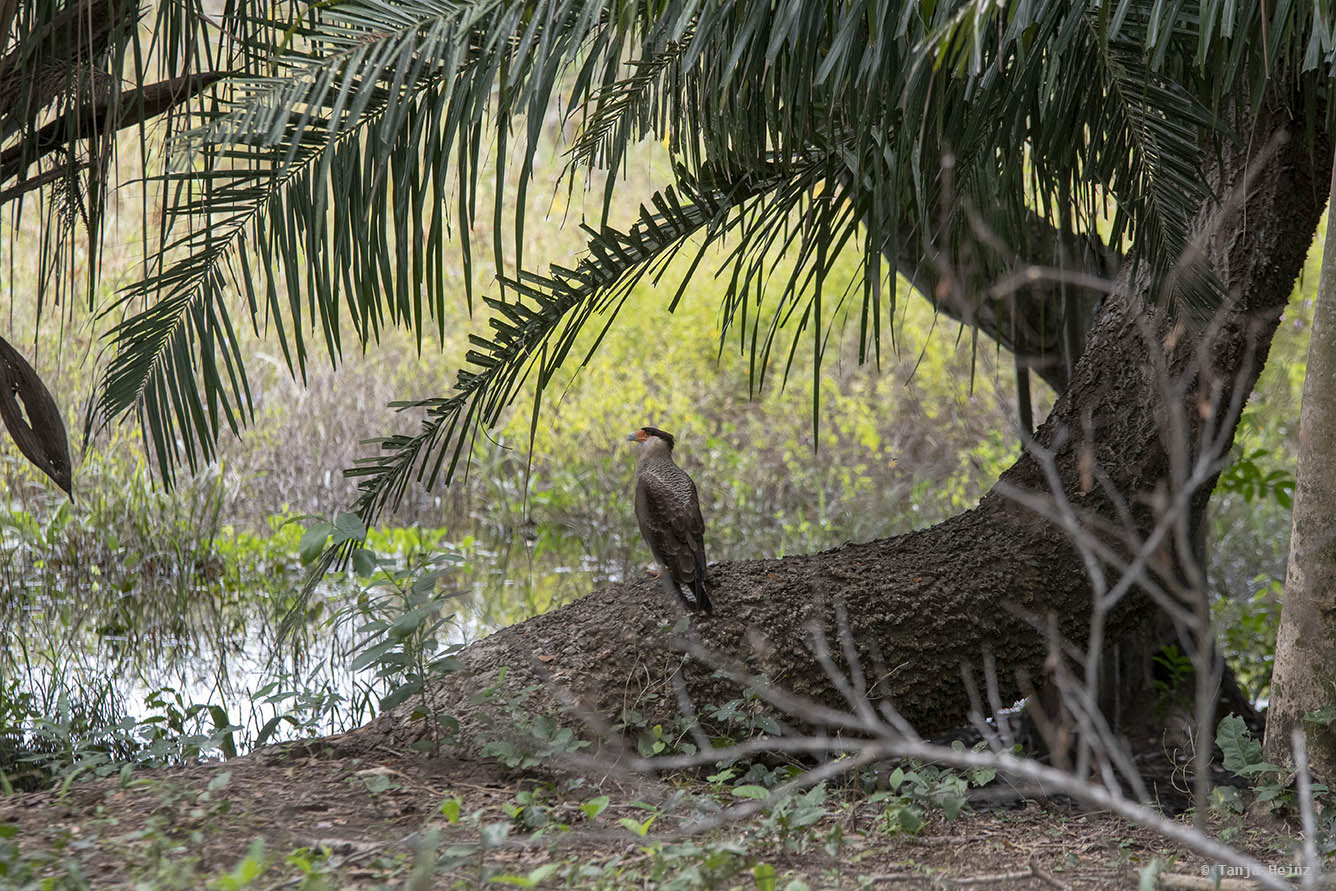
Cormorants and shags (Phalacrocoracidae)
Like Southern caracaras, we observed neotropic cormorants (Phalacrocorax brasilianus) on our boat trip. As the name suggests, neotropic cormorants occur only in tropical regions of Central and South America. According to the IUCN their populations are even increasing. We saw them several times.
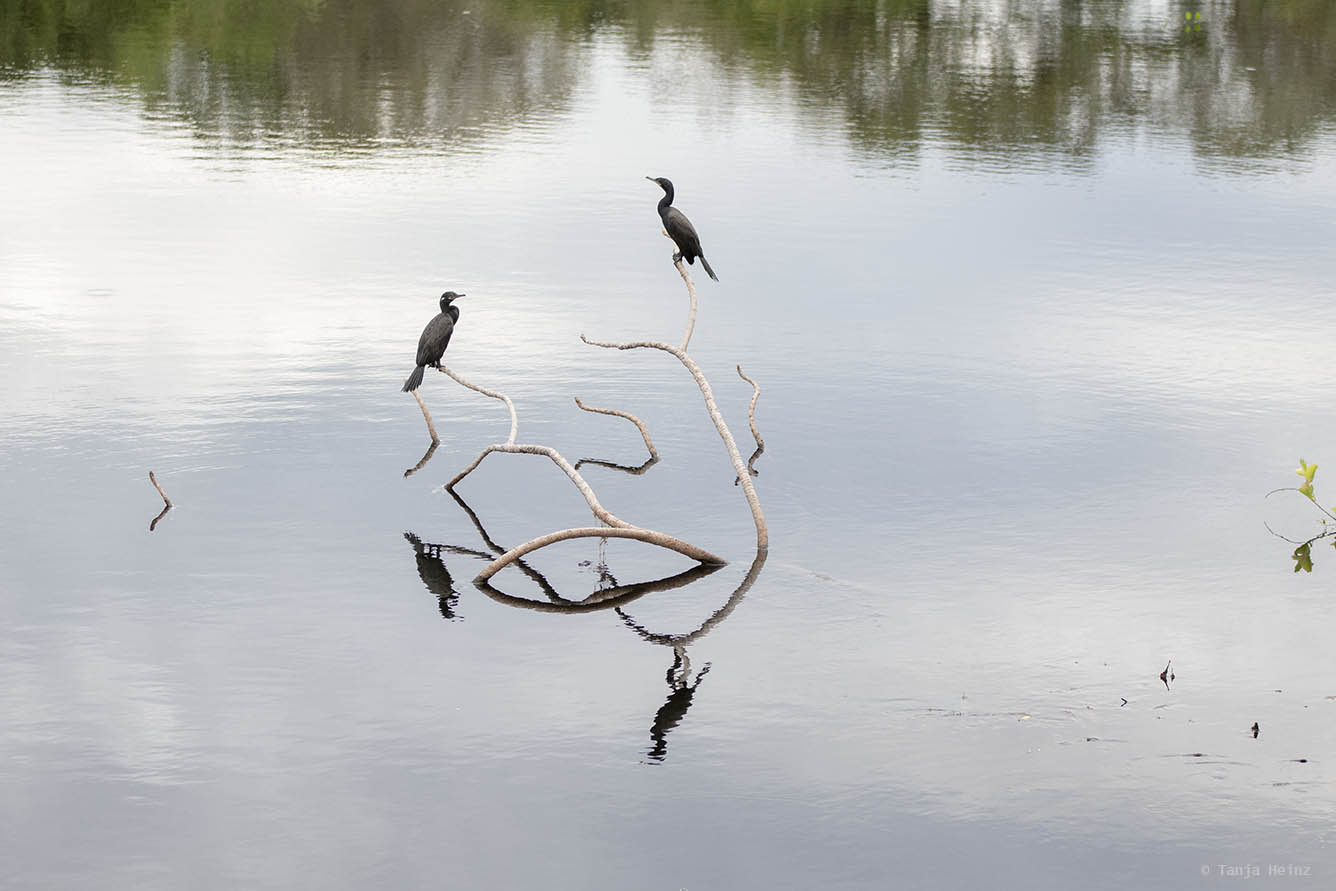
Toucans (Ramphastidae)
Unlike cormorants or herons, we observed toucans only twice. Once on our boat trip and the second time on a safari by car. In both cases we saw a toco toucan (Ramphastos toco). They have a wide distribution within Brazil, but not all over South America.
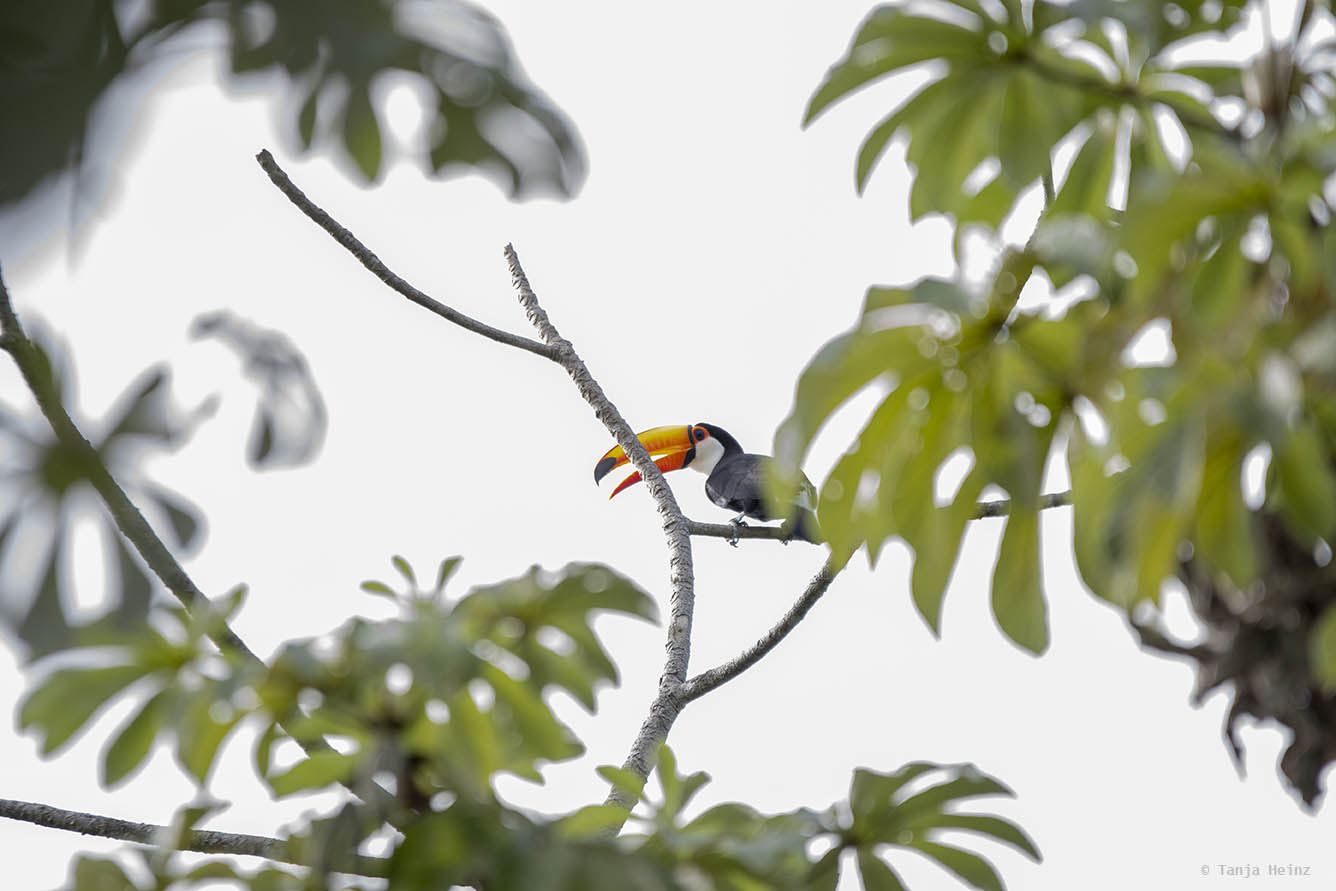
Hummingbirds (Trochilidae)
Although there are many different hummingbird species in Brazil, I spotted only one bird of this family. However, I encountered this hummingbird not in the Pantanal, but in Campo Grande close to our hotel. It was a swallow-tailed hummingbird (Eupetomena macroura).
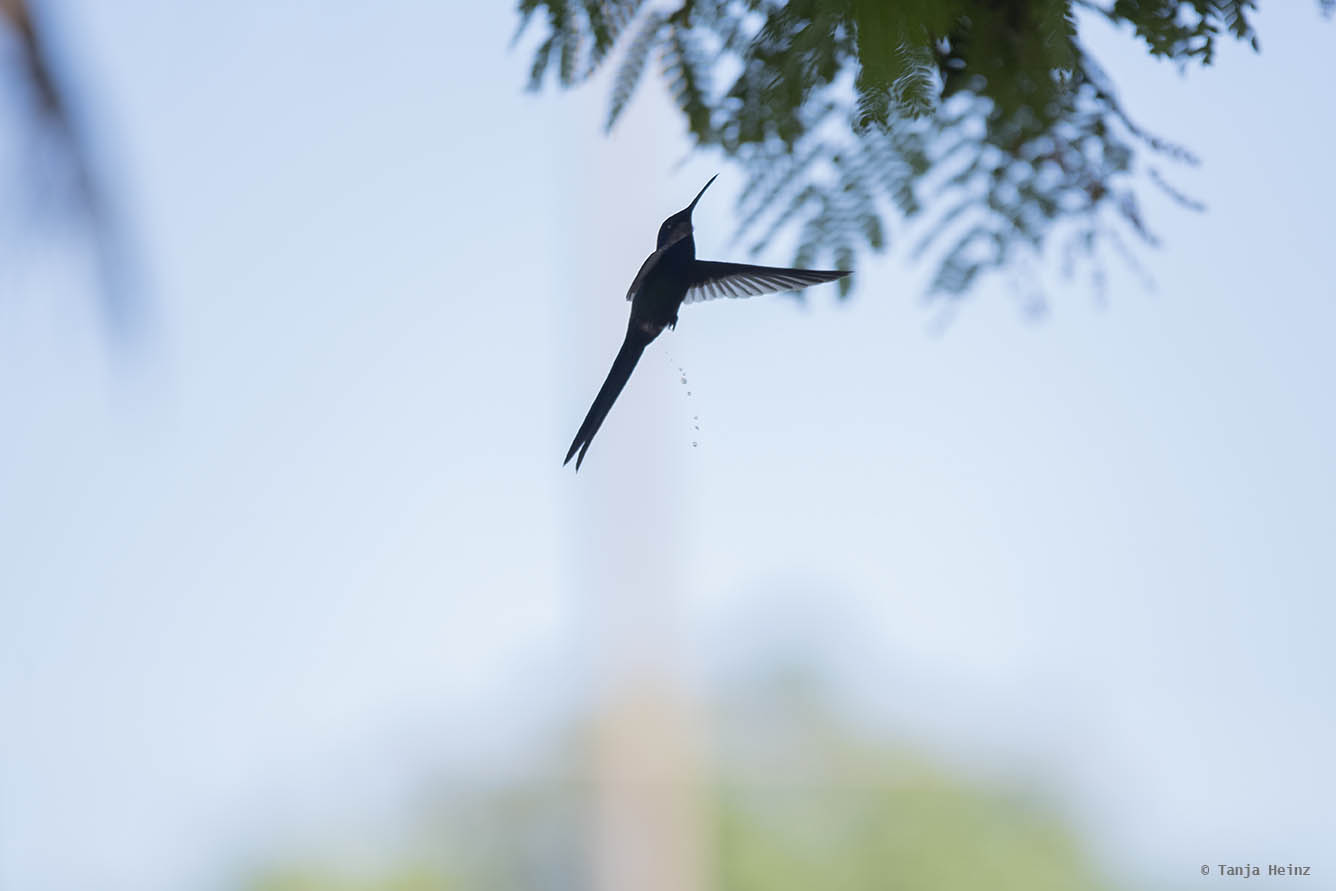
Practical information for the Pantanal in Brazil
Booking a Pantanal tour
As mentioned above, be careful when choosing a tour operator. The Pantanal in Brazil is a very popular destination, and thus, relatively expensive. Comparatively, we didn’t pay so much as we would have paid for another tour. Nevertheless, next time I will research for conservation projects to support by my participation. The fact that conservation was not addressed at all on this tour, I decided not to mention the tour operator here in this article. However, if you are interested, I’m open to tell you. You can leave me a message in the contact form or write an email at info@wildlife-travel.com. By all means, I will answer. In total, we paid 1200 R$ for a three-day-two-night-tour per person in a private room (April 2018). There is the option to stay in a dorm or in an hammock which is cheaper.
Accomodation in Campo Grande
Our starting point to the Pantanal in Brazil was Campo Grande – the capital of Mato Grosso do Sul. We arrived from Foz do Iguaçu and were directly picked up at the bus terminal in Campo Grande by our tour operator. After our Pantanal tour we stayed two more nights in Campo Grande. We decided to stay close to the bus terminal although the hotel we chose was not in the center of the city. We stayed at the Hotel Paris and we were quite happy with this decision. The rooms were comfortable and it was not an expensive hotel. However, the area around the hotel is not very interesting. But if you are looking for an economic and nice accommodation for a short stay, I can recommend this hotel. The hotel can be found in the street Avenida Gury Marques, 4175 – Universitário, Campo Grande, 79063-480.
Travelling by bus
The bus terminal is located in the street Avenida Gury Marques, 1215 – Universitário, Campo Grande, 79063-480. We traveled with the bus company Eucatur from Foz do Iguaçu to Campo Grande. The journey took about 14 hours and we paid 114,88 R$ per person. The bus left in Foz do Iguaçu in the afternoon and arrived on the next morning in Campo Grande. After our trip to the Pantanal we traveled by bus again from Campo Grande to Rio de Janeiro. This was our longest journey by bus within Brazil. The journey took about 24 hours and we paid 389,88 R$ per person. We traveled with the bus company Andorinha. We left in the morning and arrived on the next morning in Rio de Janeiro. There is the option to book a flight. If you choose the bus, you can book the bus tickets at the ticket desk or online on Clickbus or Brasil by Bus.
Have you already been in the Pantanal? If yes, please let me know your experiences especially the way you travelled. With a tour operator or on your own? And which wild animals did you see in the Pantanal in Brazil.
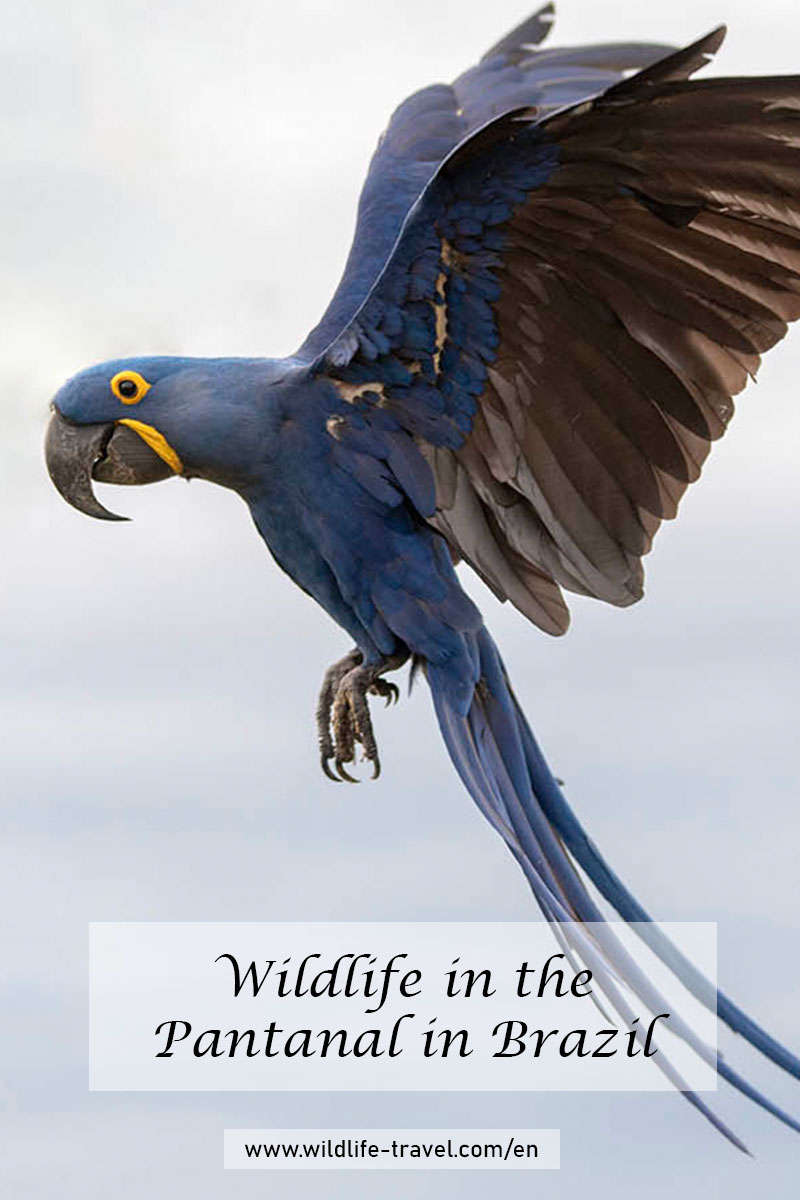
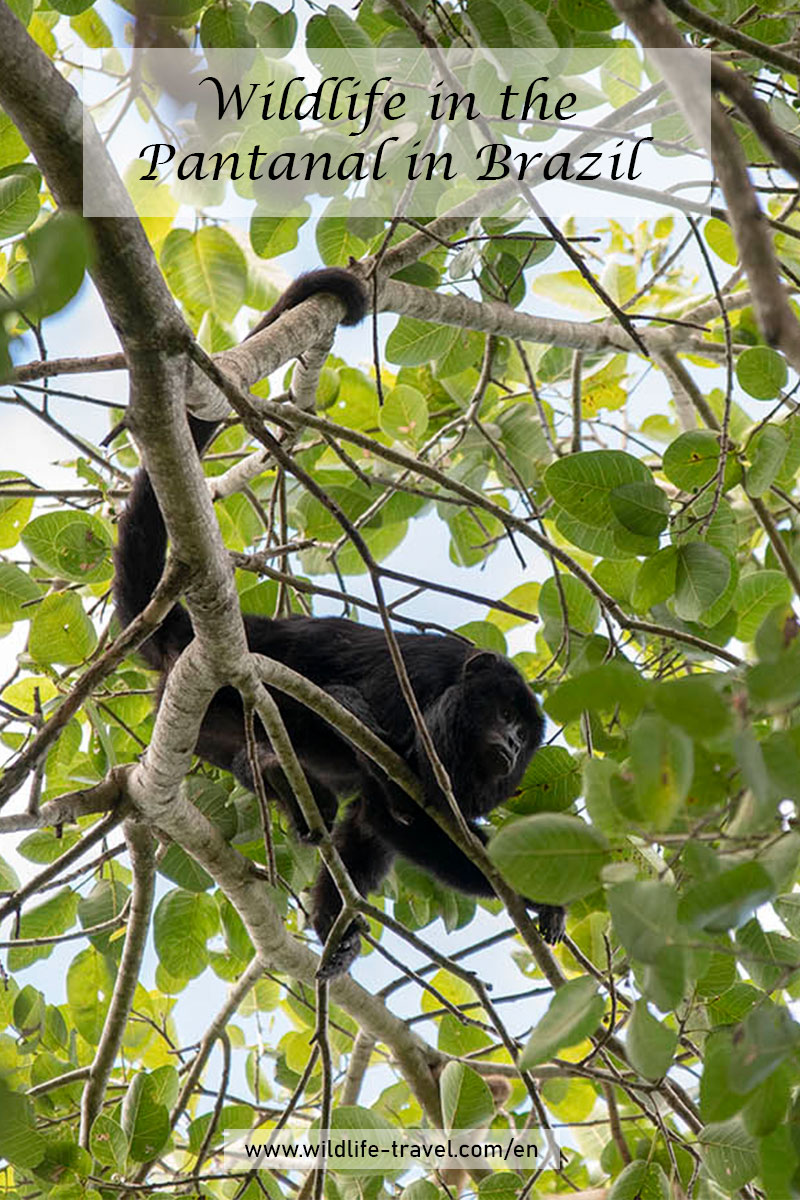

Thanks so much for sharing all your insights, Tanja. The Pantanal is high on our wish list so it’s super helpful to know the North is preferable and June to August is the preferred timing. Like you, we would definitely prefer a tour operator who is conservation focused. It’s so cool you got to see macaws and capybaras as well as all the bird species. I just saw Guinea fowl in Zimbabwe and didn’t realize they had been introduced to S America. Those sunsets that you captured along with the reflections on the water are stunning. I’m not sure I’d be brave enough to go through waters known to have snakes given my fears. We can’t wait to get there someday soon!
Thank you so much Marielena for your comment 😀 The Pantanal is a perfect place to photograph animals, but also landscapes. I’m sure it would be a paradise for you where you can be creative also with long exposure photography. I think it is very important to research well for a good tour operator or conservation organization. As the Pantanal is a very popular destination, there are different ways and many offers to explore the Pantanal. The macaws and capybaras where indeed amazing. I could have observed them for hours. Yes, it was brave to go through the water. I have to admit, I was a little bit scared… But by all means, the Pantanal is a wonderful place and really worth a visit!
What a lovely blog site Tanja – I’m glad I found it, via your recent ‘like’ on one of my Instagram photos. My own website, which is centred around ‘wildlife photography adventures’ has a very similar theme running through it. I shall bookmark ‘wildlife-travel’ to keep up with your adventures. By the way, the Pantanal article is great – the Southern Pantanal is one of my favourite destinations.
Thank you so much Tony for your comment. I’m very happy that you like the article 🙂
I have visited your website. Wow! You have been already on so many adventures. Your gallery is amazing! I’m impressed by your bird photographs as I know that taking photographs of birds is very, very challenging.
I completely understand that the Pantanal is one of your favourite destinations. Very impressive landscapes and the wildlife is so diverse and wonderful. I wish I would have seen a giant anteater, too 😉 But I will go back there. I’m sure.
I definitely have to check more articles on your website as you have visited so many beautiful places!
Have a wonderful weekend!
this is amazing post thanks for sharing information
Thanks…
A very informative article. I will arrive in Brazil this summer and I want to arrive in the Pantanal, but the prices are a bit discouraging. Could you tell me which tour operator you used?
Hello Roxana,
thank you very much for your comment 🙂
I think summer is a very good time for the Pantanal. I was there in a March/April, just after the rainy season. They say, that July is the best month for seeing, e.g., jaguars and many more animals. I went with the company http://gilspantanaldiscovery.com.br/ to the Pantanal. I hope this information helps you.
Kind regards,
Tanja